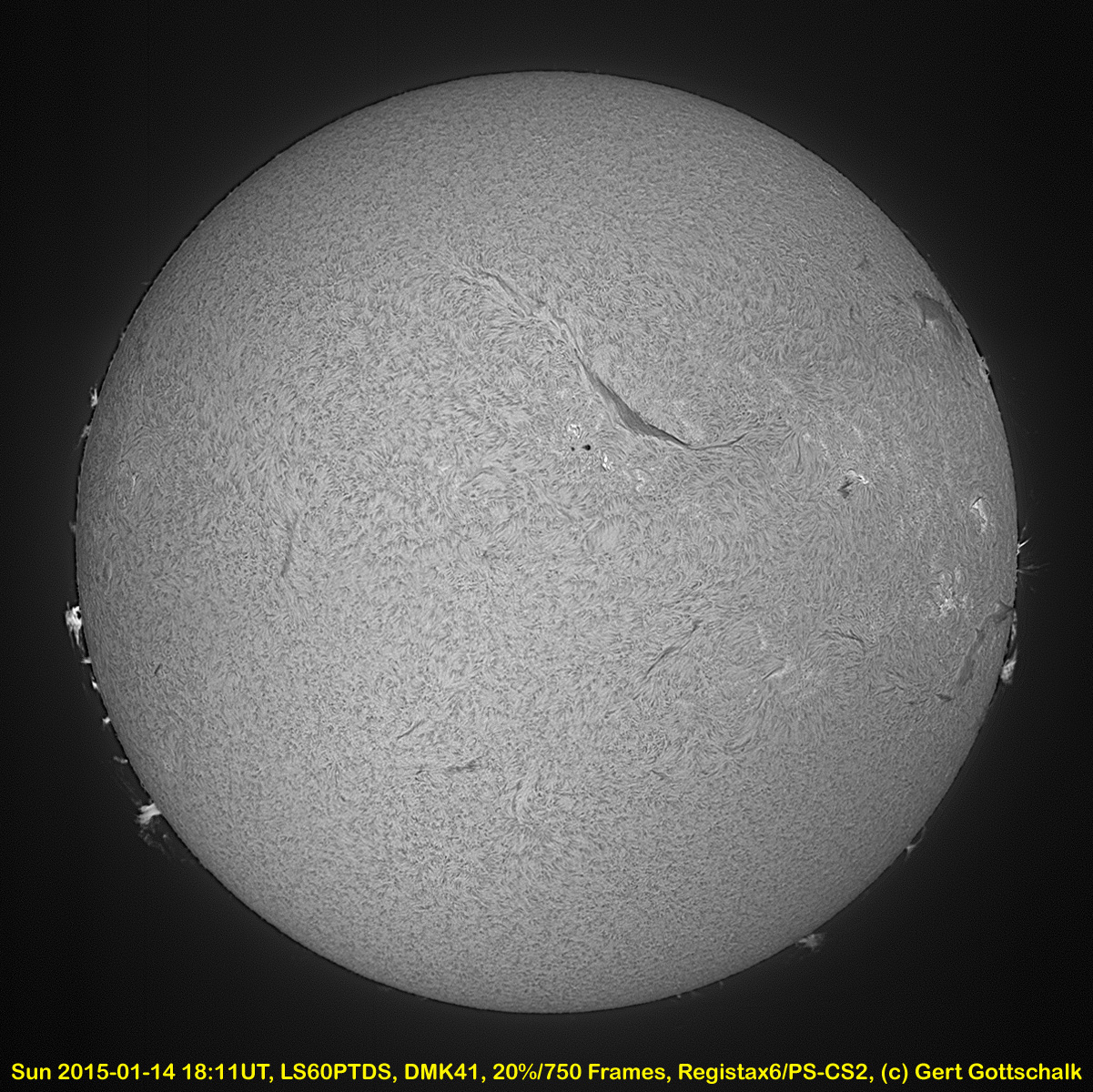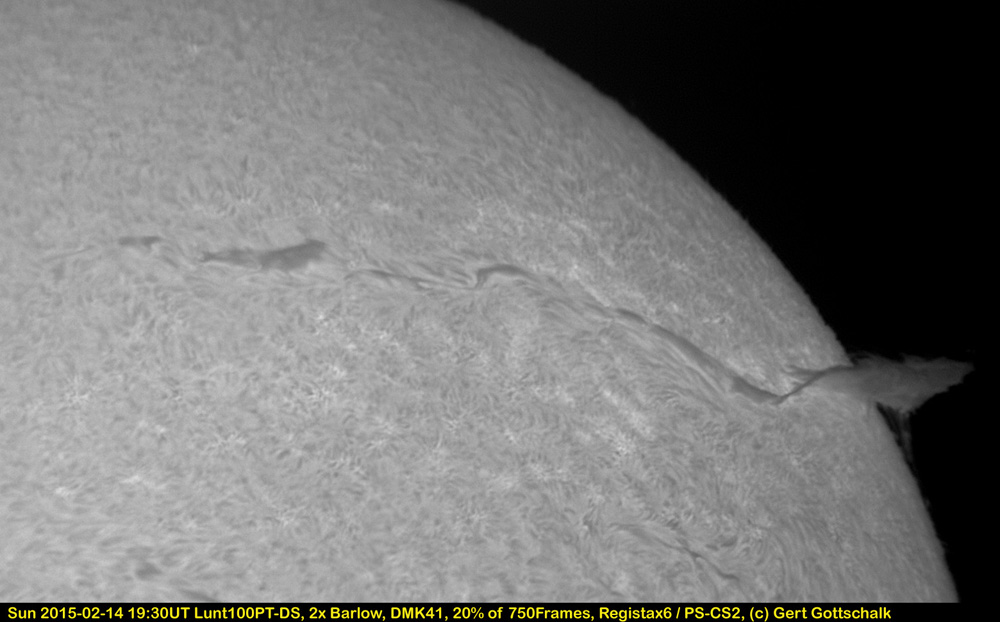Images taken with Lunt LS60 or Lunt LS100 in single stack or double stack mode as indicated near the image.
Recording with DMK41. Typically 15% to 25% of 750 frames processed in Registax 6 and Photoshop CS2.
2015-11-21 19:04UT Very high frequency seeing today. This allowed only to use the small aperture Lunt LS60PT. For scaling the solar disk to the DMK41 camera again the 0.9x Shapley lens was used.
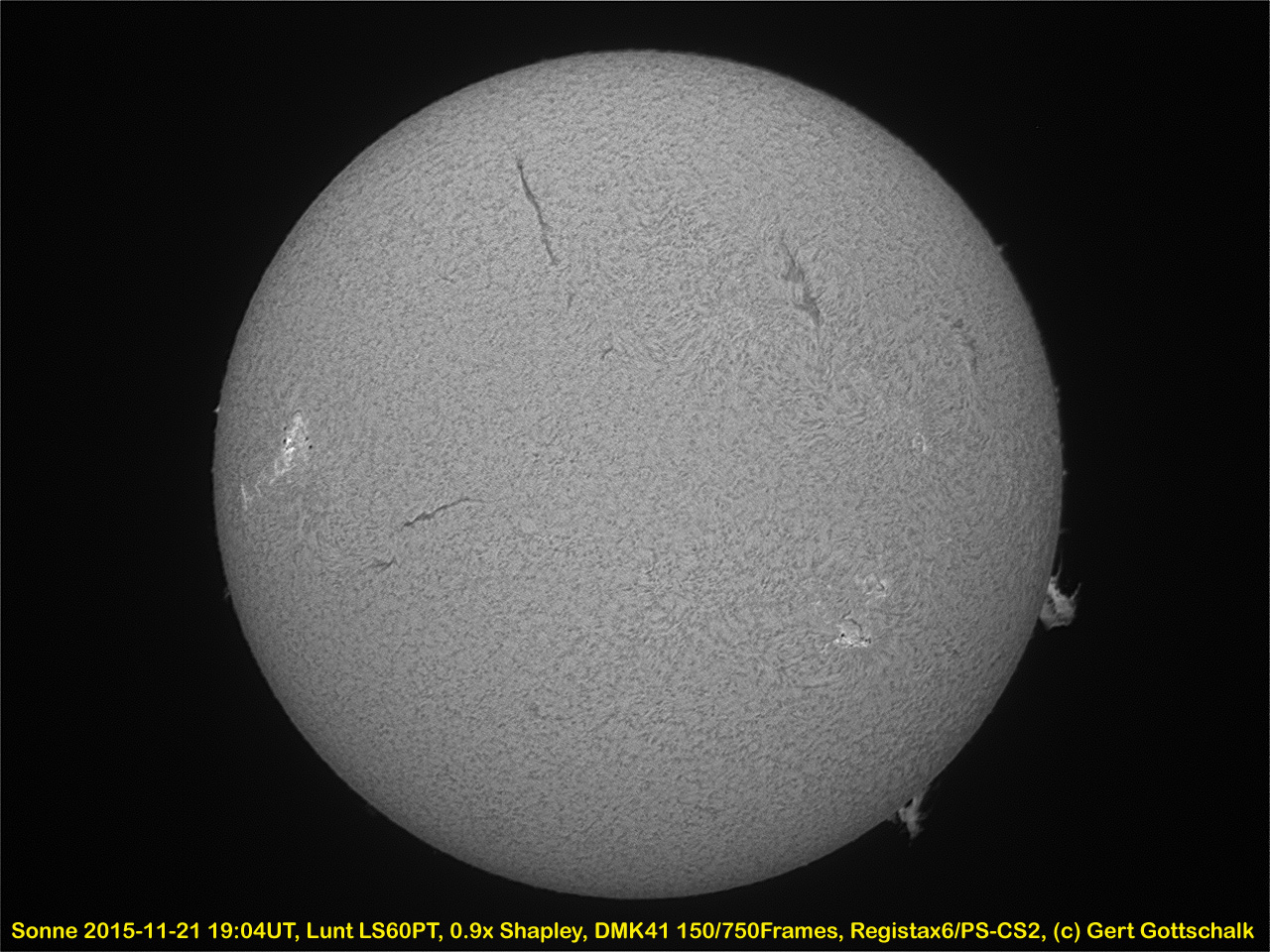
2015-11-21 19:12UT With the 2x barlow lens the bad seeing the limitng factor. Two nice prominences.
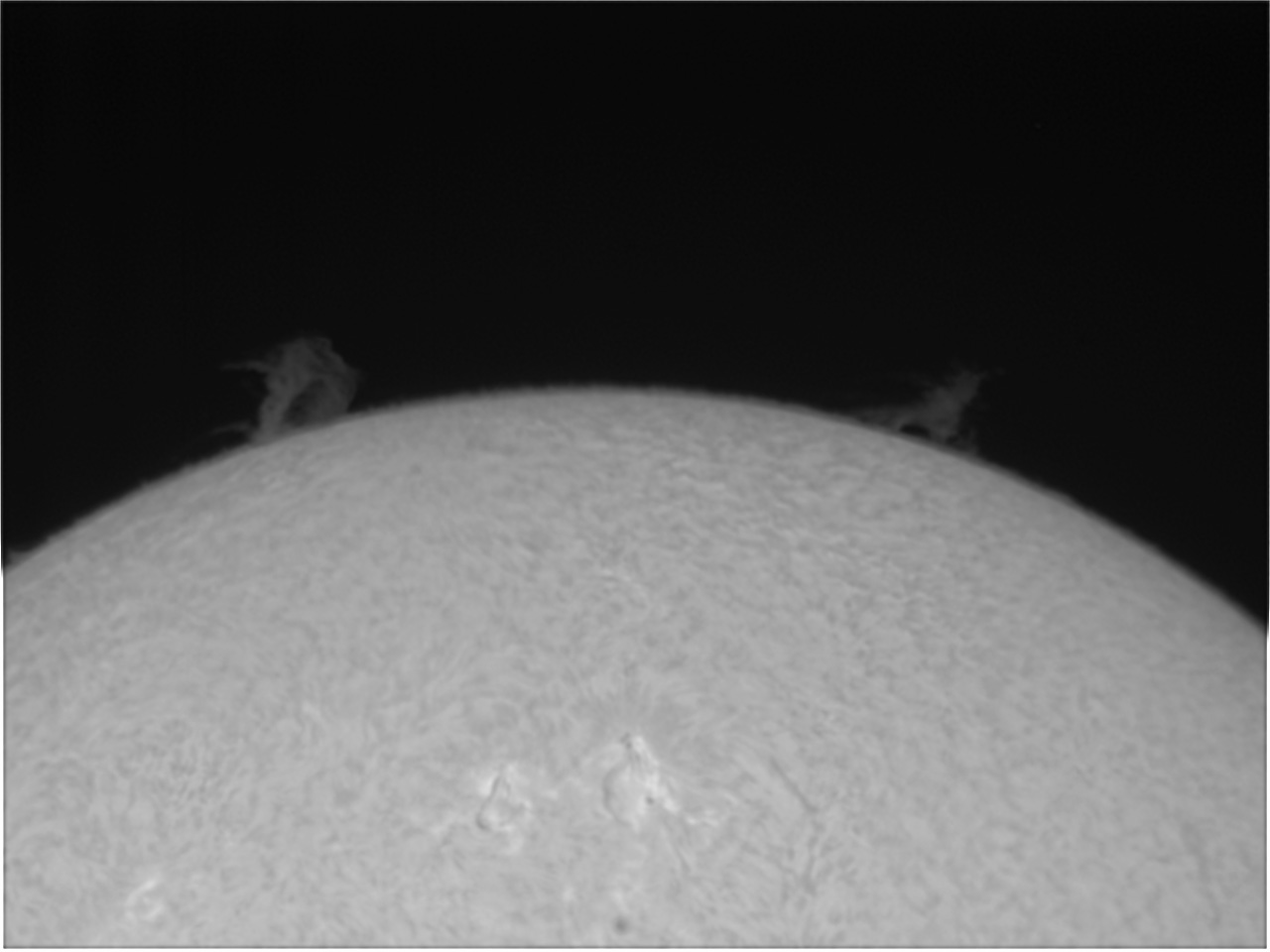
2015-11-14 19:23UT This day was the last chance before a weather system was supposed to move through. So I used the Lunt LS60 for a full disk observation and then added a 3x Barlow for details of the horseshoe filament.
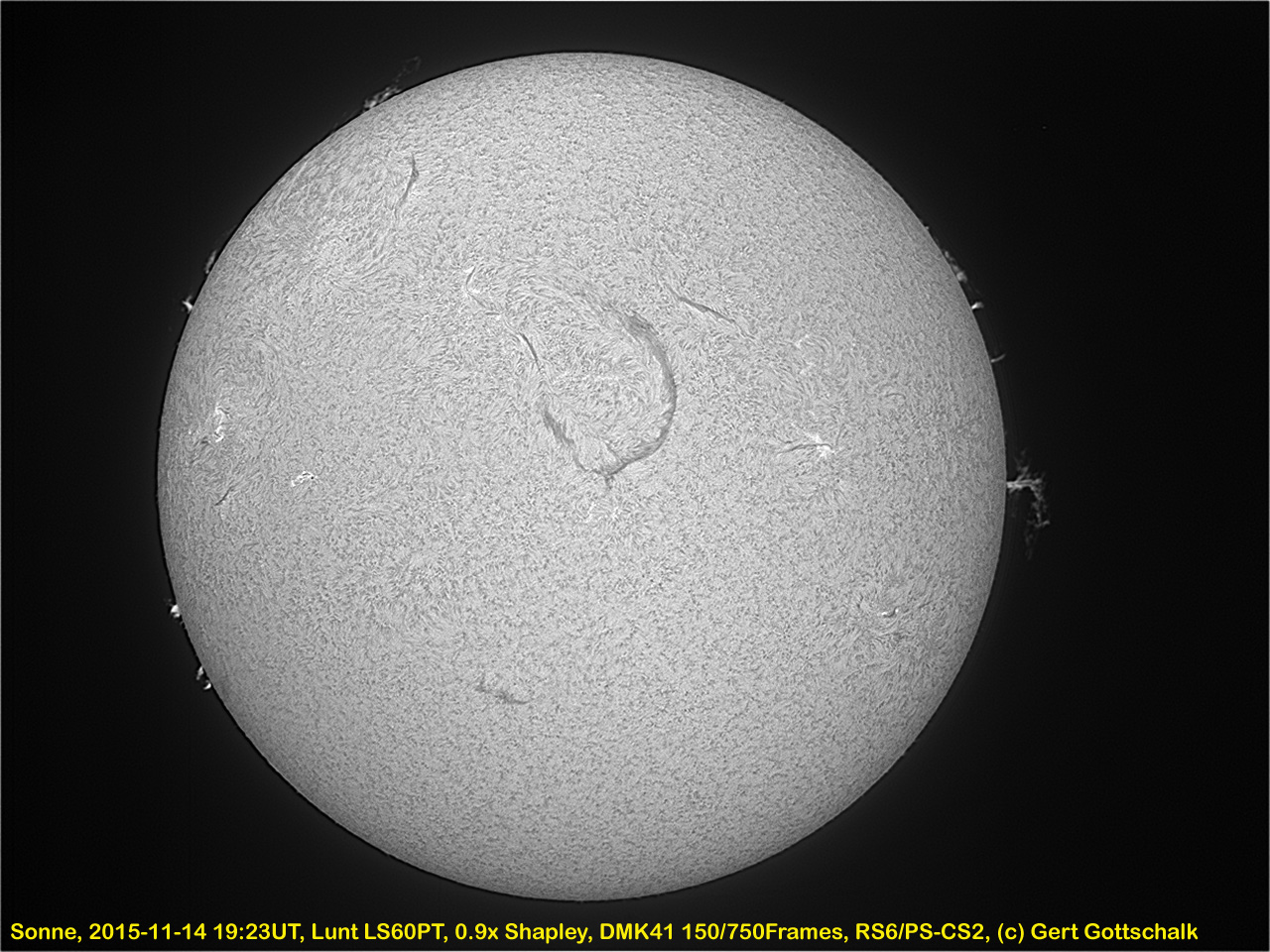
2015-11-14 19:12UT I tried the 2x Balor to magnify the two prominences at right, but he seeing was not allowing for a sharp image.

2015-11-14 19:33UT A 3x Barlow image of the horseshoe shaped filament near center. This Meade 3x Barlow shows some bothering frnging near lower center. Will have to try another barlow.
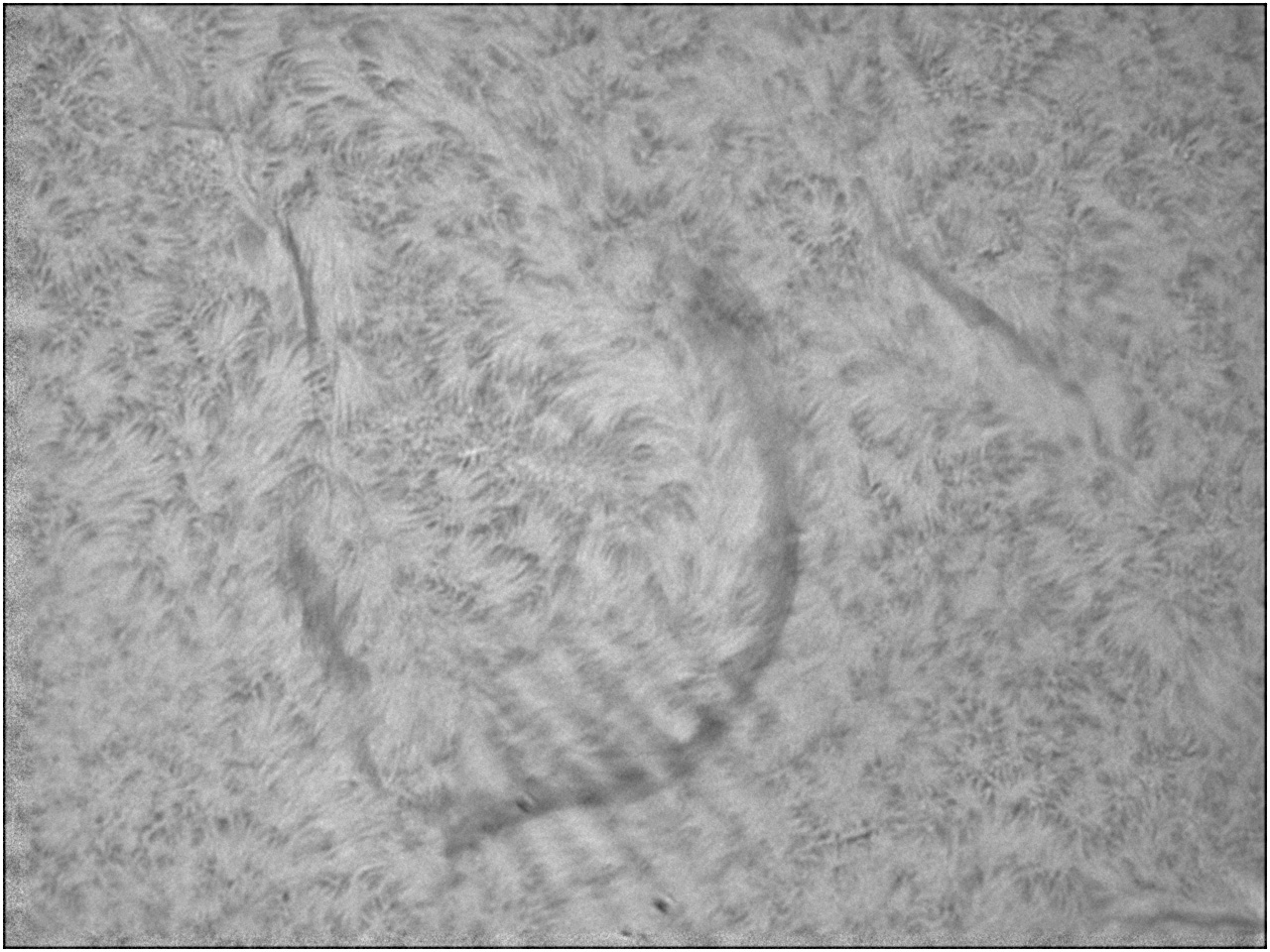
2015-10-31 19:43UT A clear saturday morning allowed the use of the Lunt LS100PT with DS unit and 2x Barlow. There is a flare event happening in the active region near the sunspot.
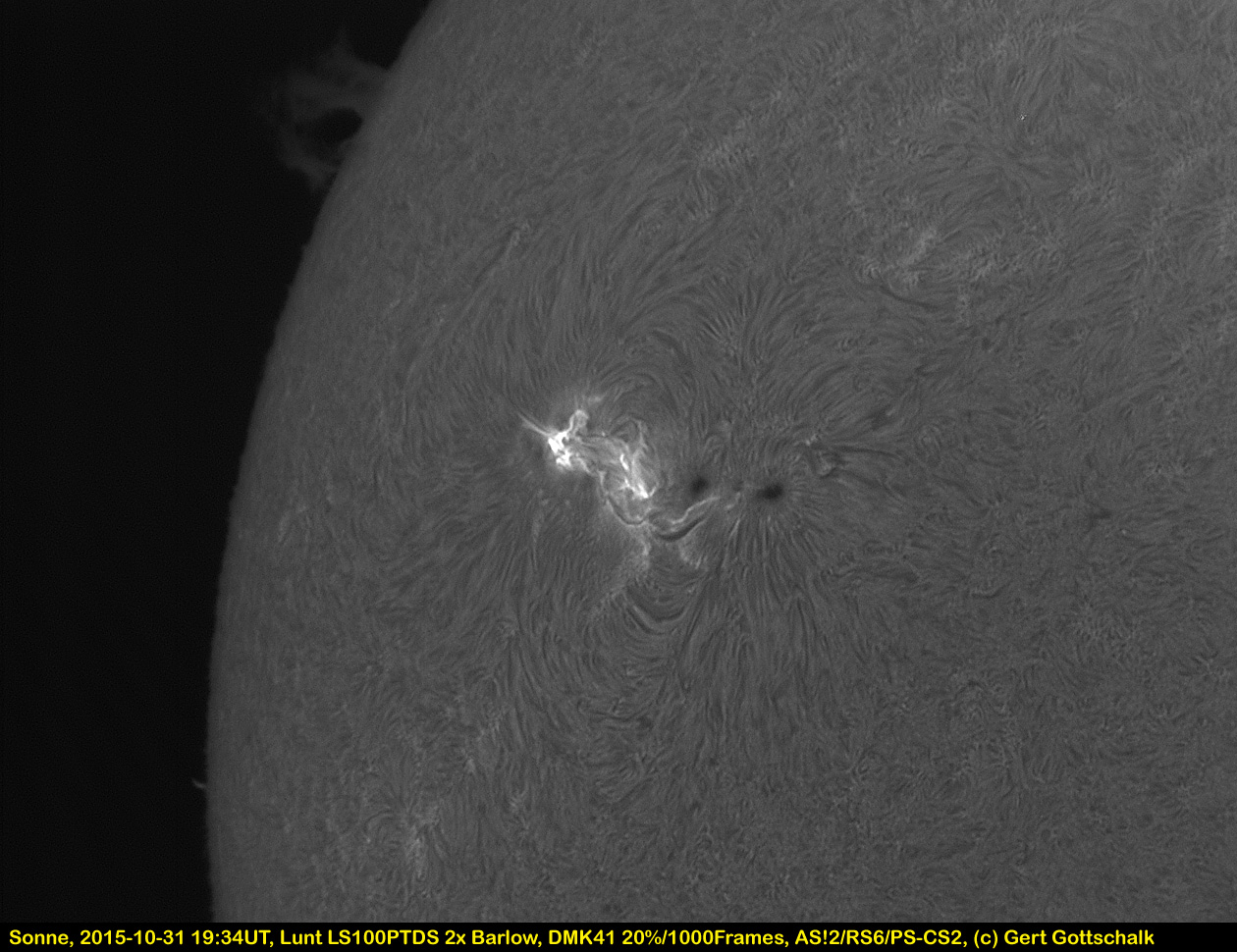
From 26 frames the following time lapse was made covering approx 50minutes.
2015-10-11 18:29UT The solar disk has recently shown a decrease in activity. No more large filaments and sunspots. So for the composite today only the single stack filter was used.
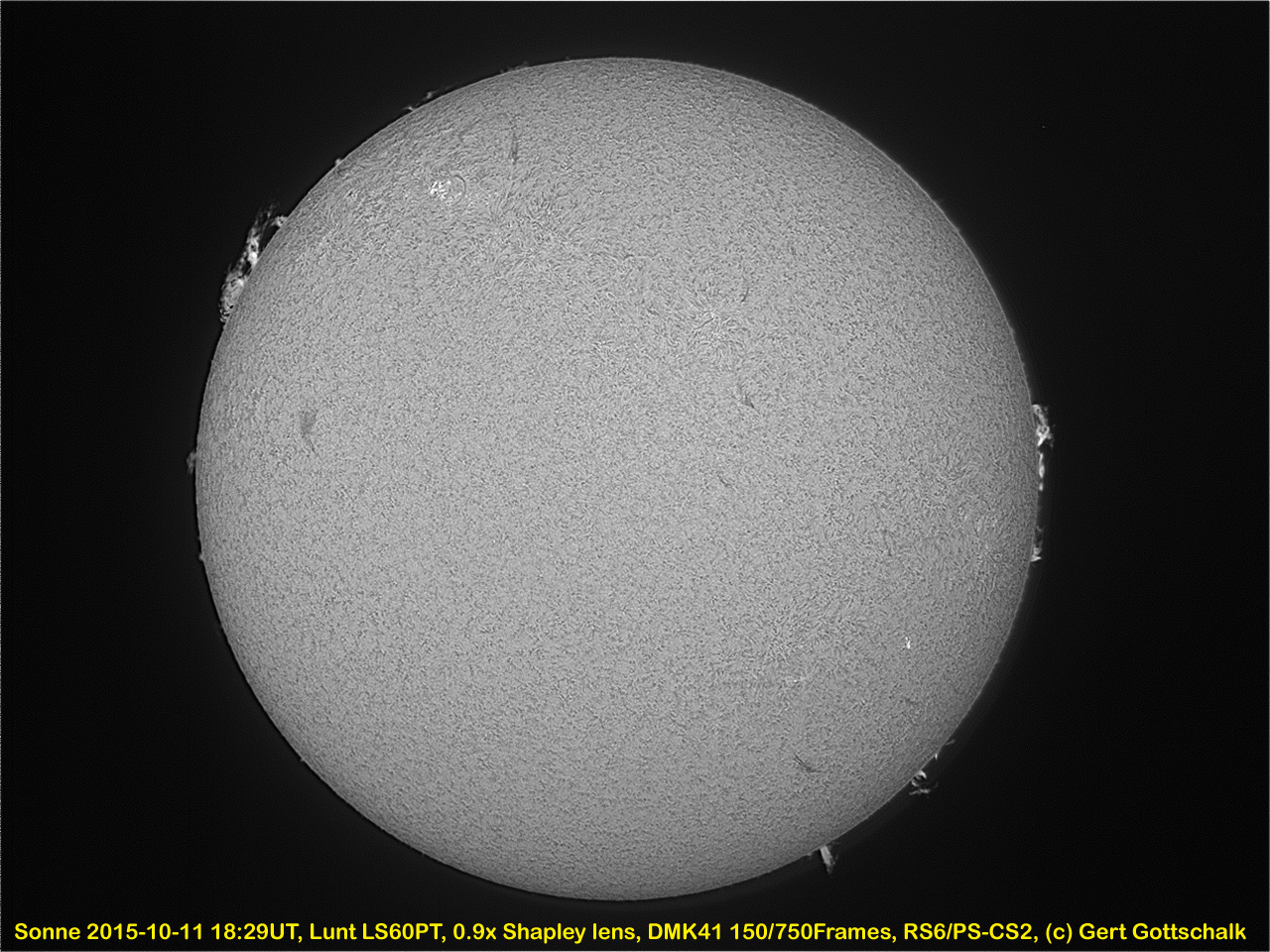
2015-10-11 18:36UT Still some nice prominences were hovering over the solar limb and with a 3xBarlow lens could fit the image scale of the DMK41 camera nicely.
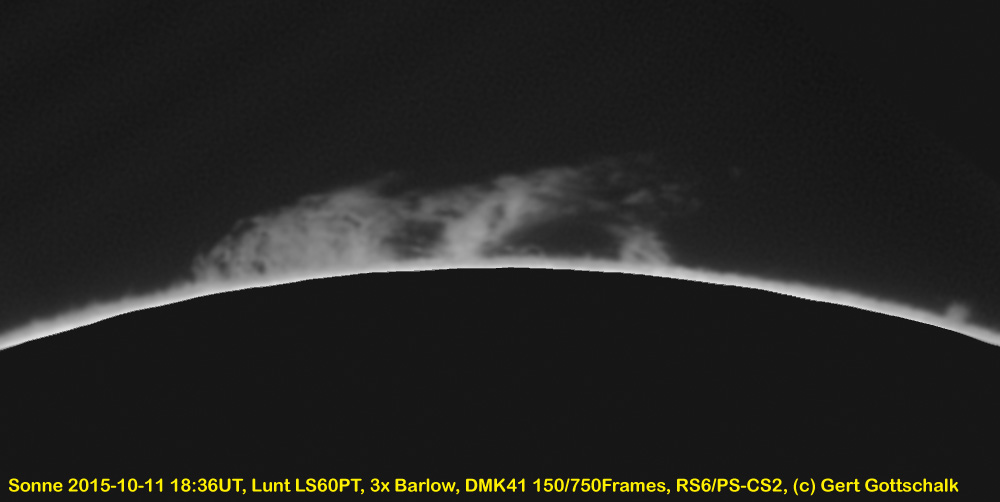
2015-10-11 18:37UT A somewhat smaller prominence but with some nice filament at left.
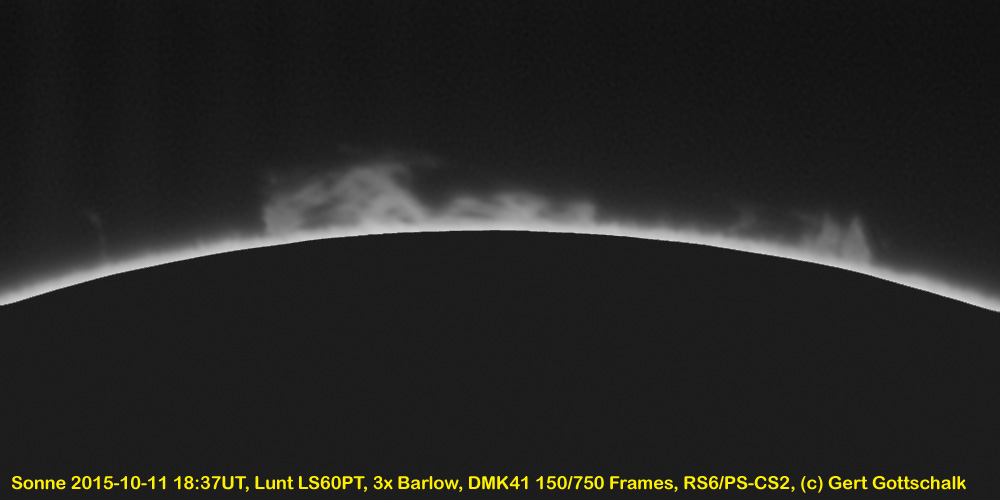
2015-10-11 18:39UT Another smaller combination of two prominences..
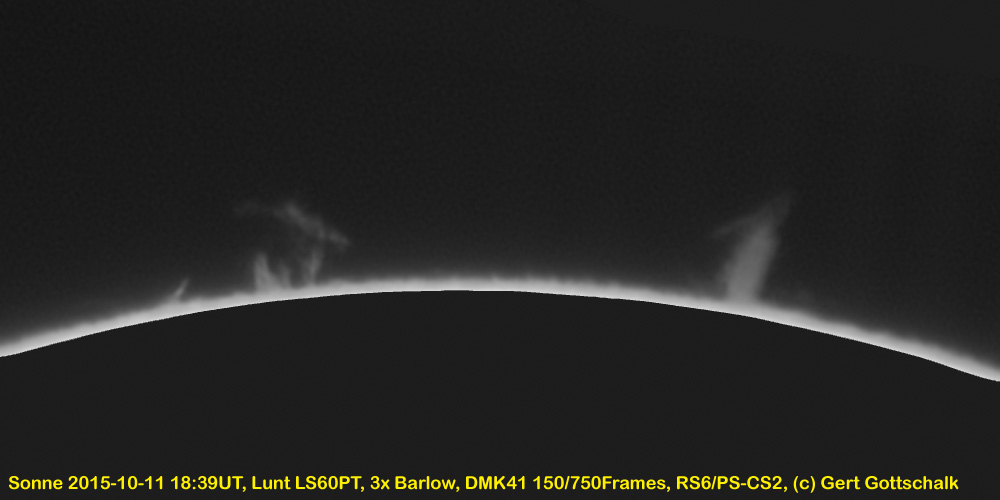
2015-09-26 18:37UT, A very clear blue sky today allowed the use of the high contrast double stack filter module on the Lunt 60mm scope. The seeing was average. There is a nice filament over the surface at right.
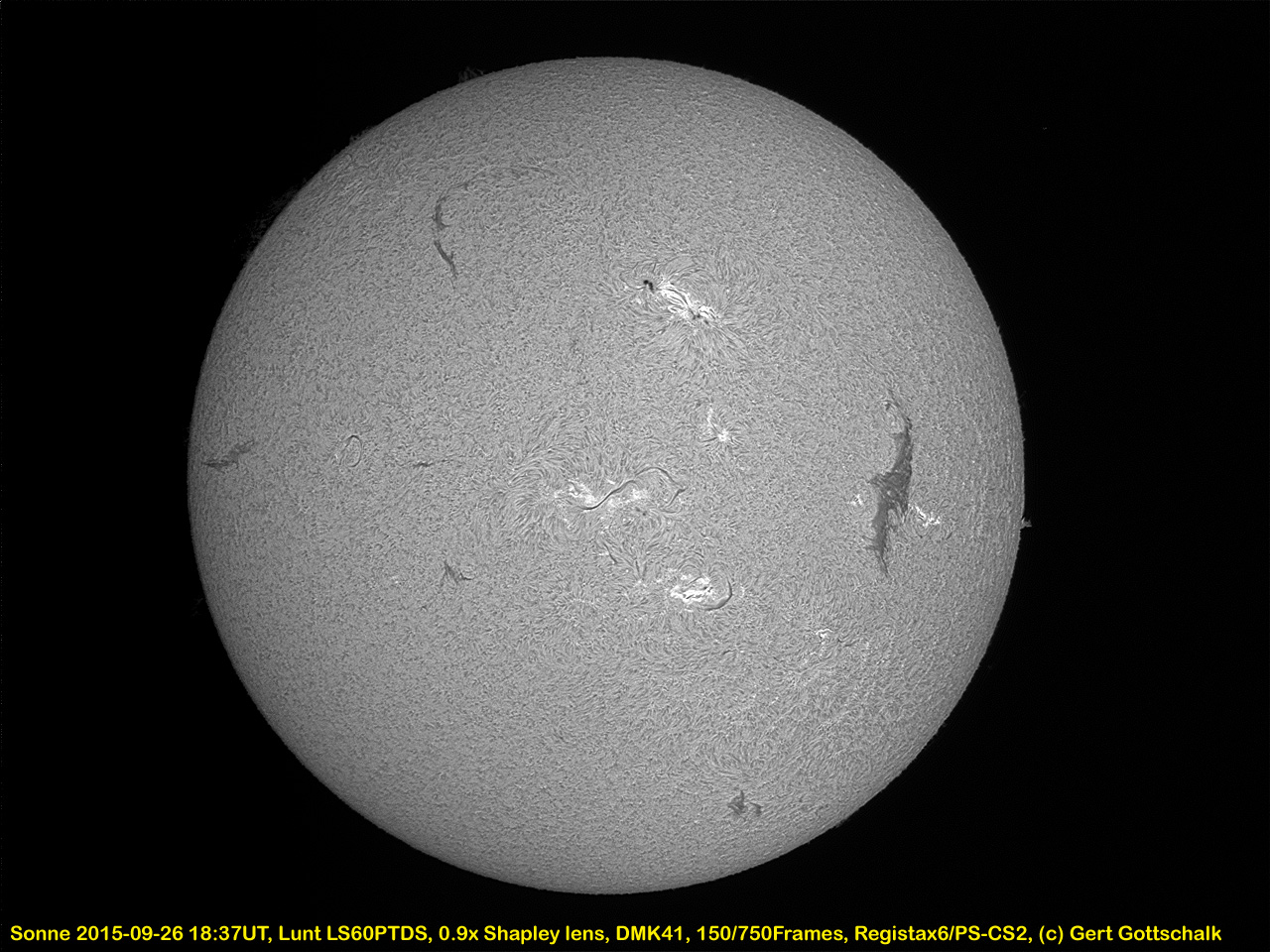
2015-09-26 18:44UT, A magnified view of the filament with the 3x Barlow lens. This magnification was the limit for the seeing condition. The original video frames are already very blurry.
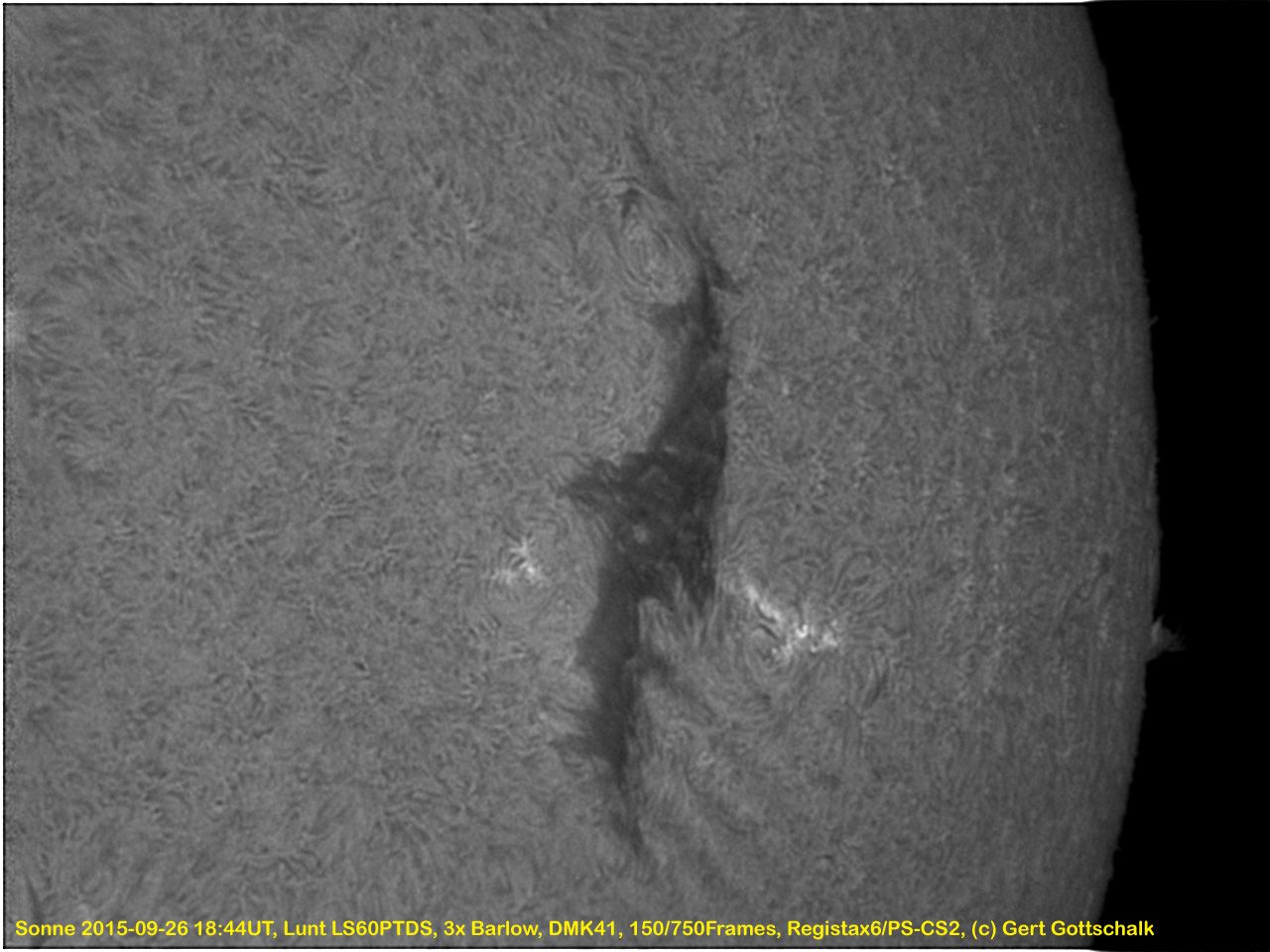
2015-09-26 18:46UT, Another magnified view. Here the sun spot near center magnified with the 3x Barlow lens. We can see some nice magnetic field line structures.
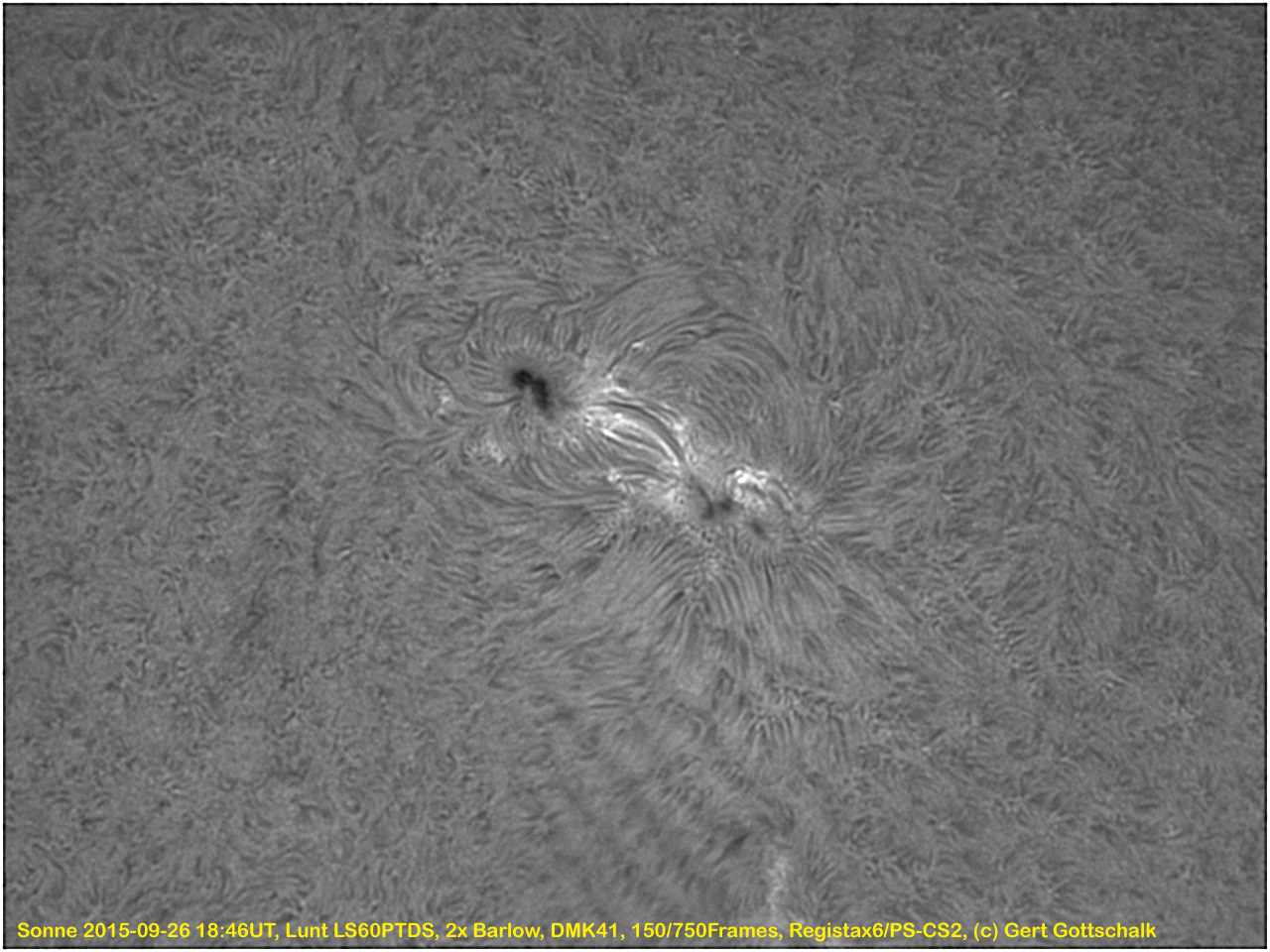
2015-09-07 18:07UT. We had nice clear skies today and I combined several techniques for today's image. First a composite of 2 exposures. One for the surface and one for the prominences. Both use the single stack LS60PT scope.
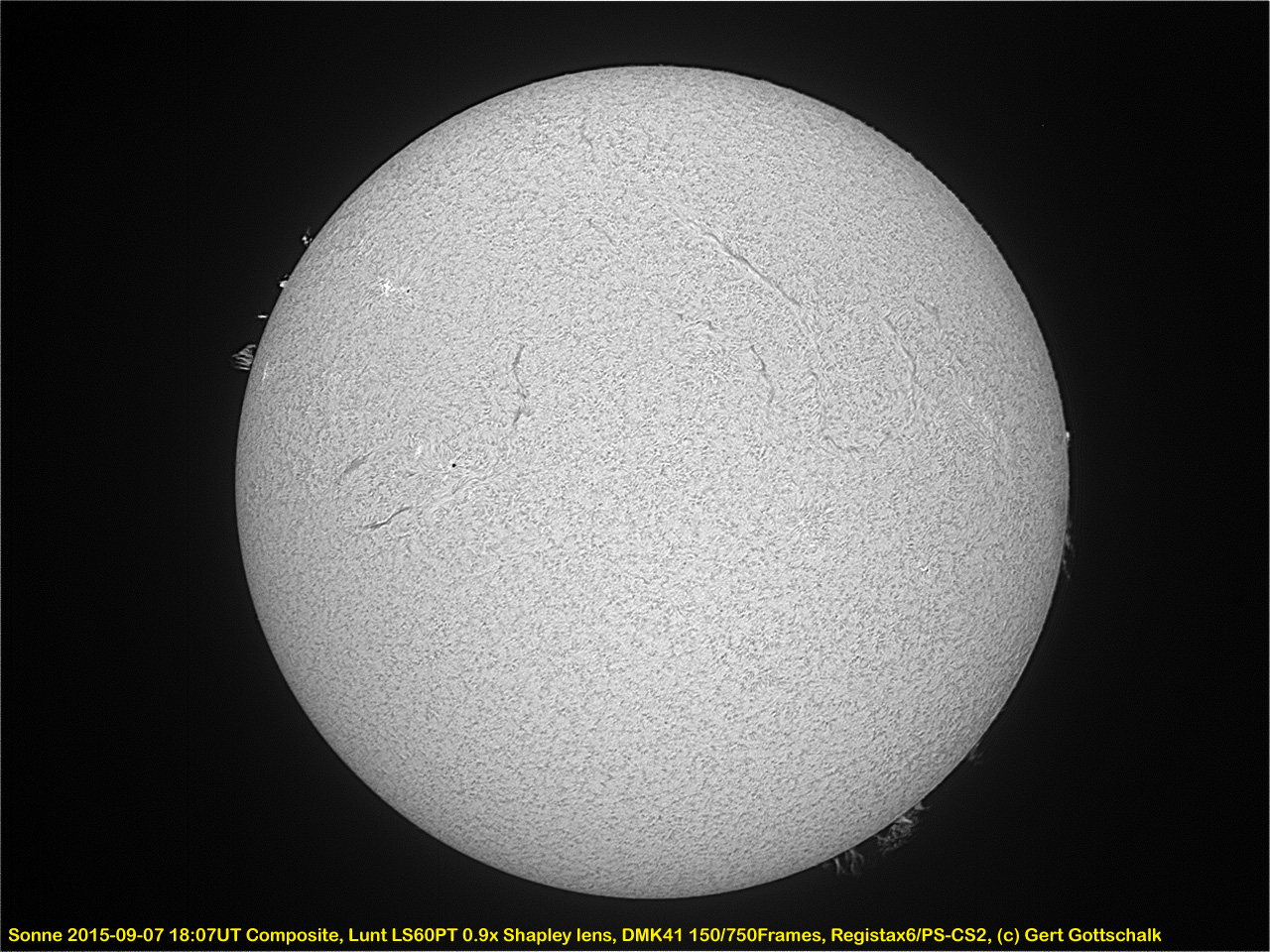
2015-09-07 18:21UT With the double stack filter there is good contrast to show the surface and prominences in the same exposure. Although the prominences are fainter.
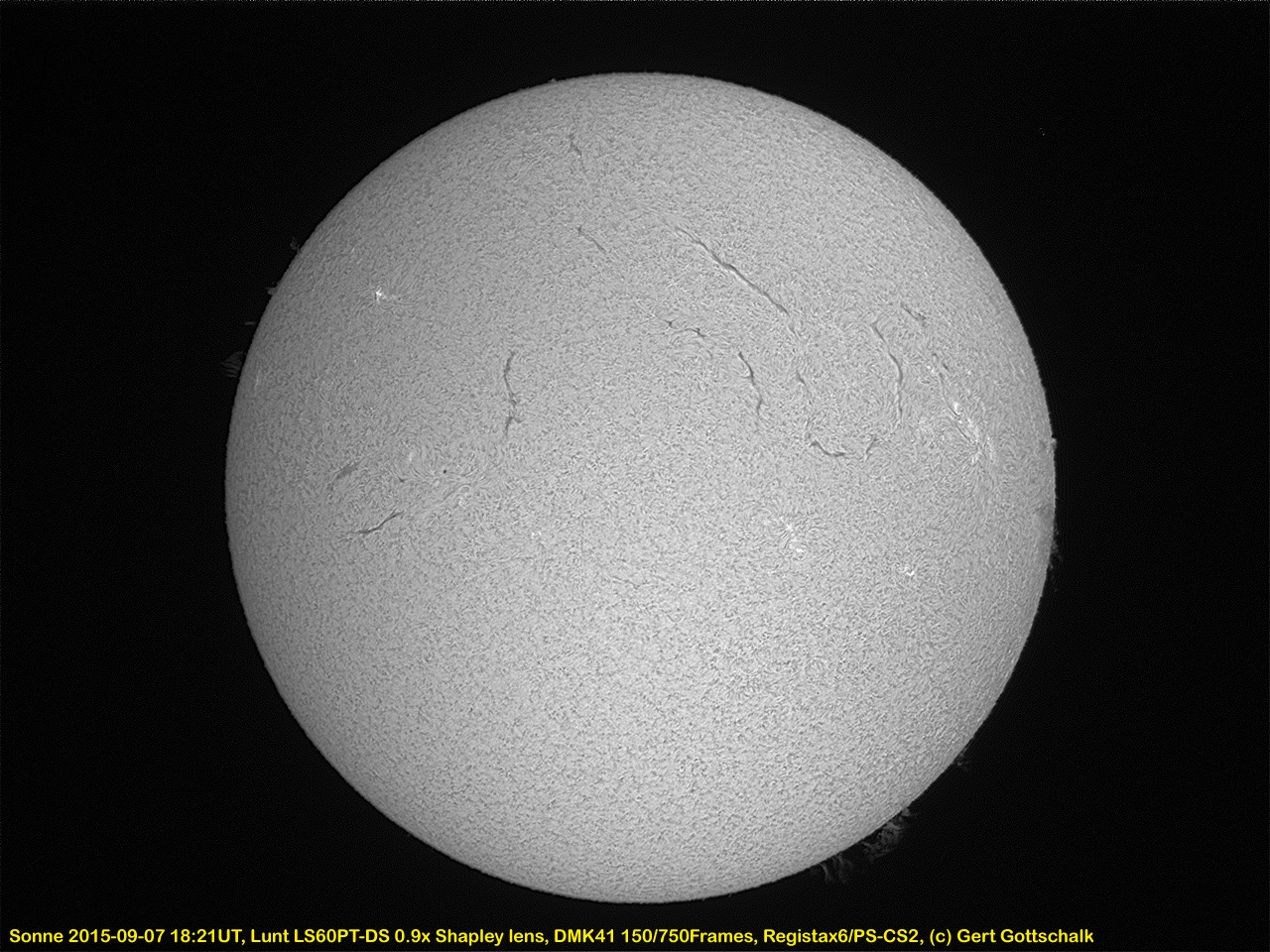
2015-08-30 20:39UT. It was a bit hazy and today the full disk image was the best option. The exposure is with the Lunt LS60PT with DS filter and the 0.9x Shapley lens.
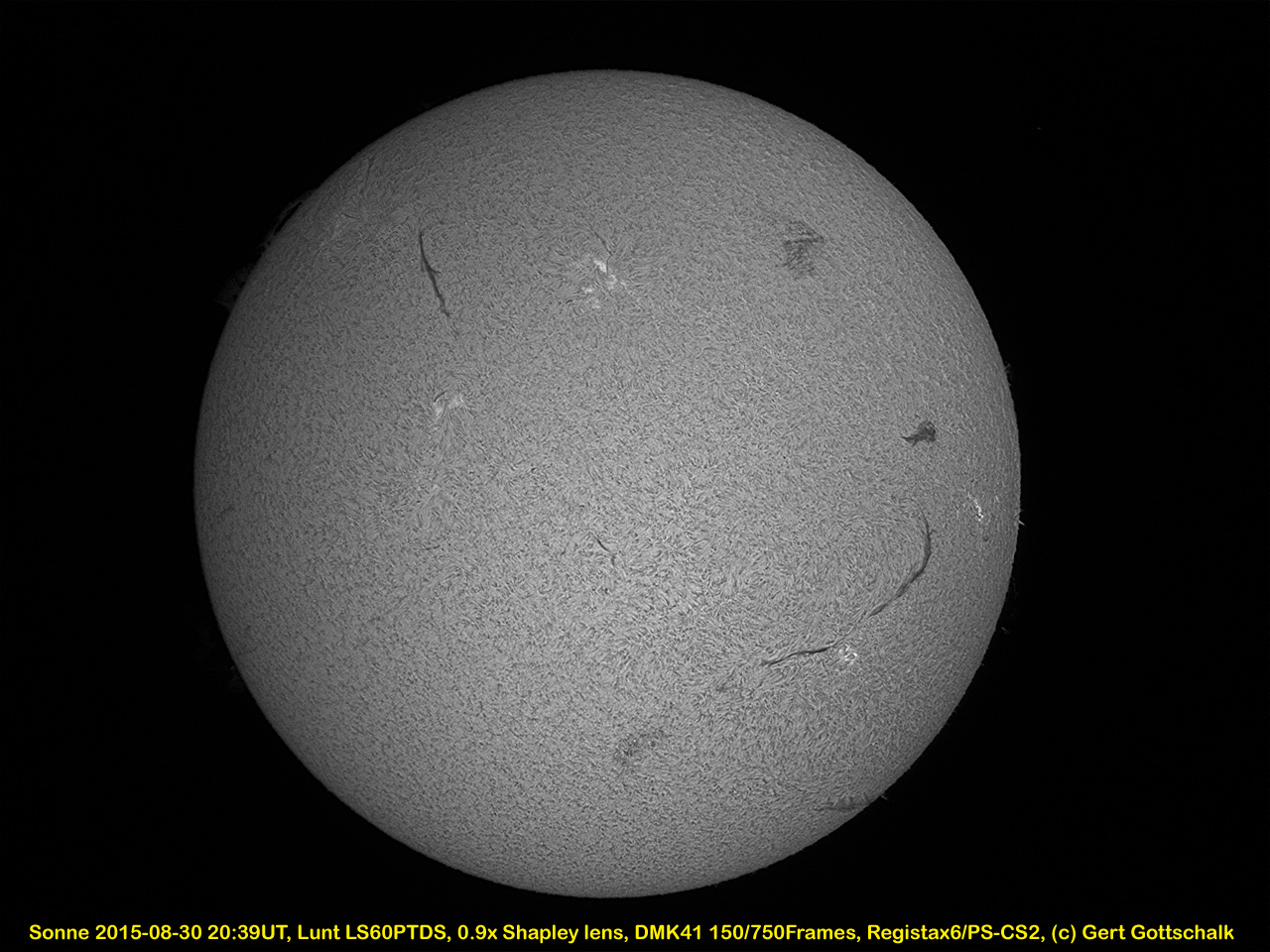
2015-08-30 20:33UT. An experiment with the 3x Barlow lens to bring out a small prominence gave some pretty good result.
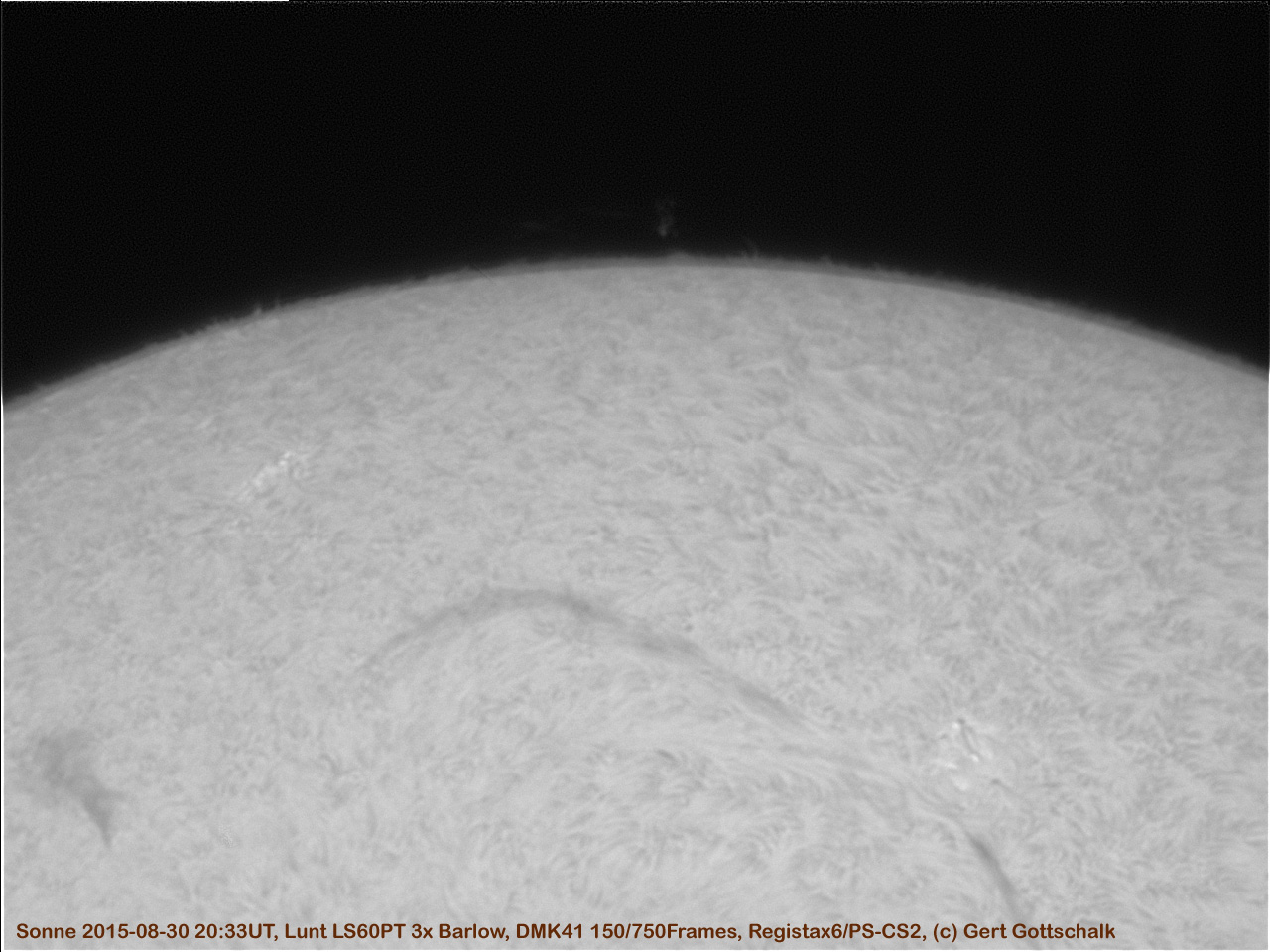
2015-08-22 18:27UT. The day was a bit hazy from remote wildfires. The first observation is full disk with the Lunt LS60PT and the 0.9x Shapley lens.
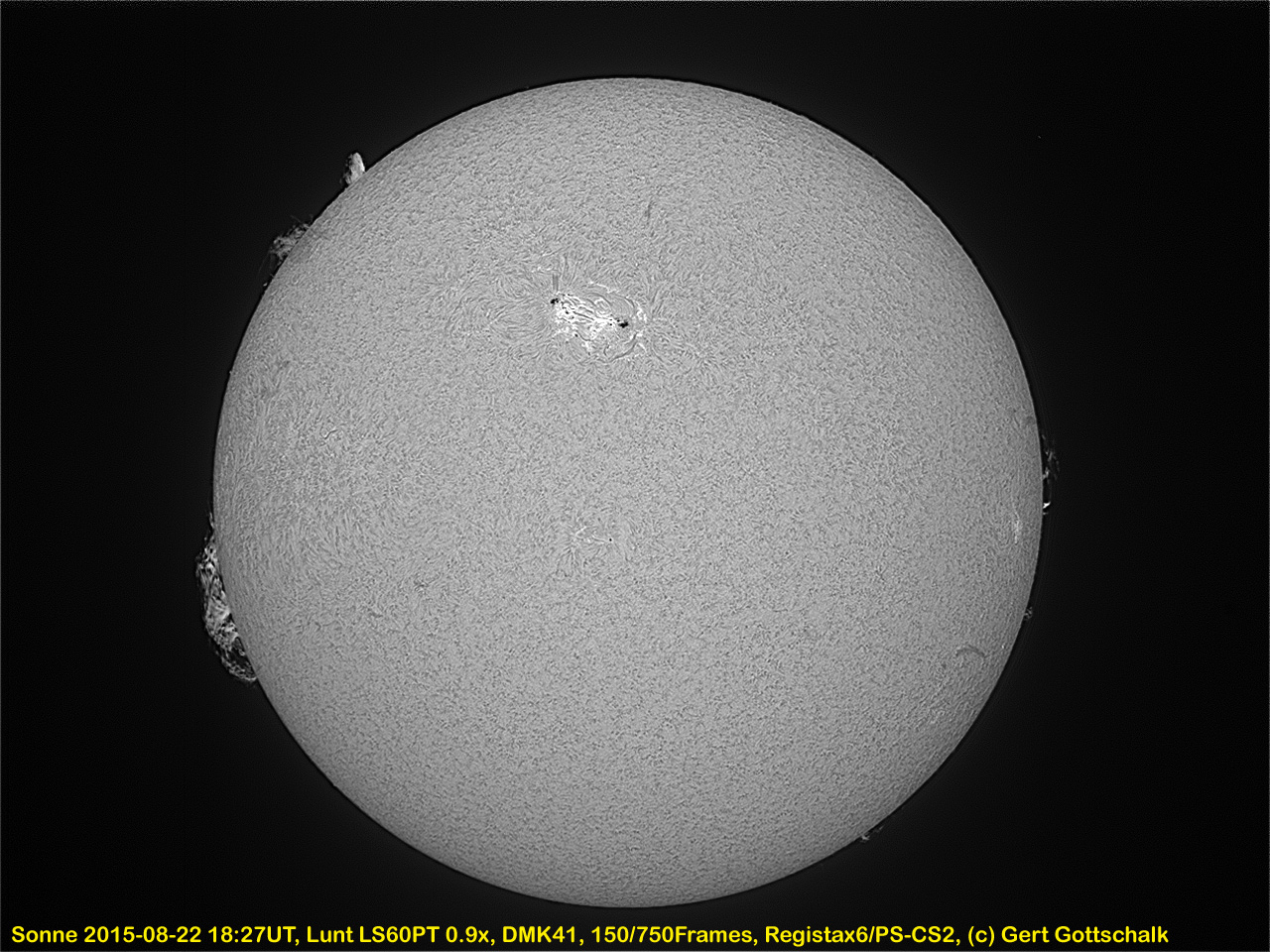
2015-08-22 19:56UT. The seeing had some good moments and I wanted to use the Lunt LS100PT with 2x Meade Shorty Barlow. Here the prominent sunspot near center.
A timelapse animation of 2hrs activity in the spot can be found here : Sunspot_20150822_crf16_8fps.mp4
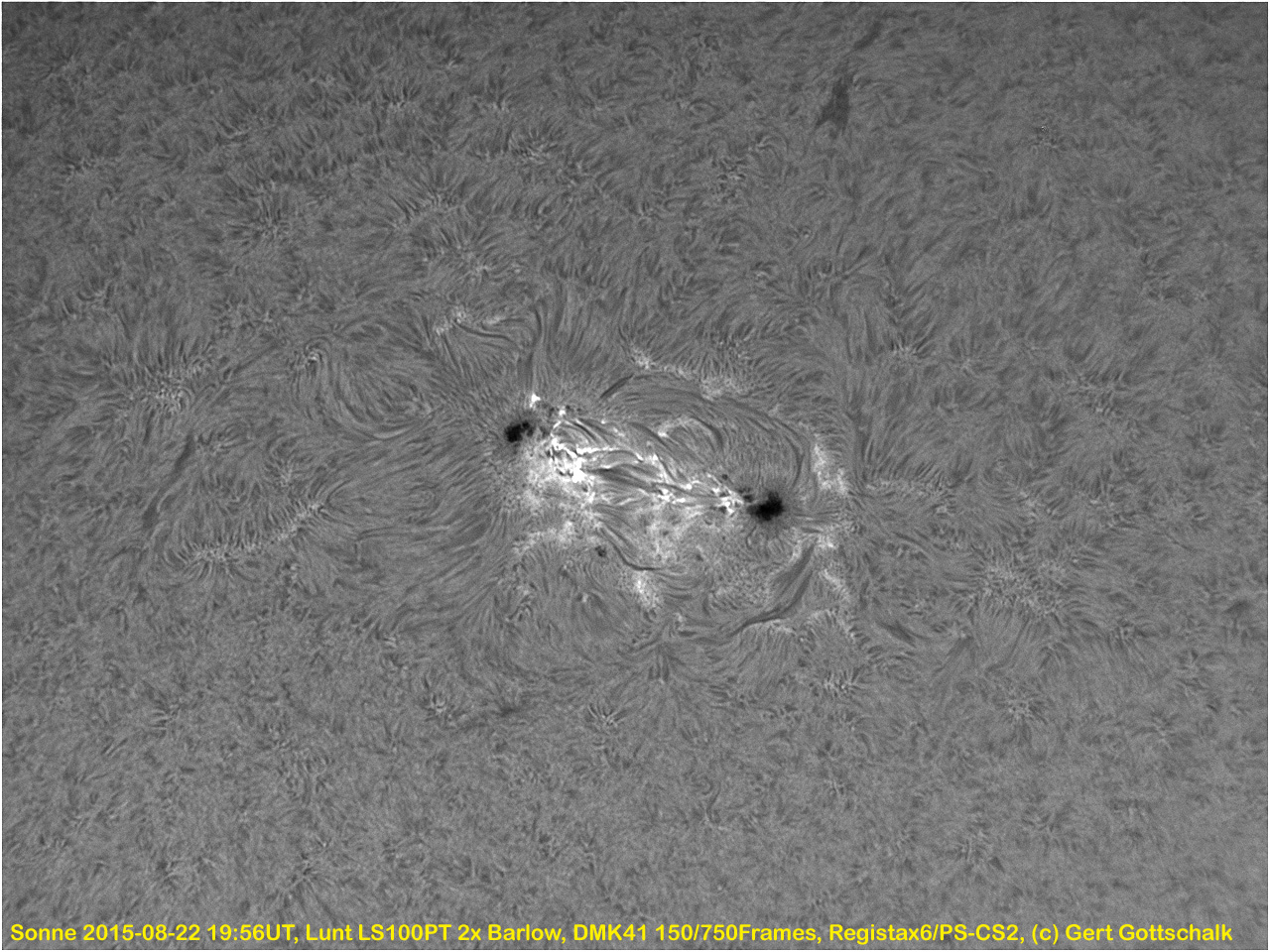
2015-08-22 18:59UT. A nice large prominences at lower left of the disk. Exposure and gamma were slightly adjusted to show the surface and prominence at the same time.
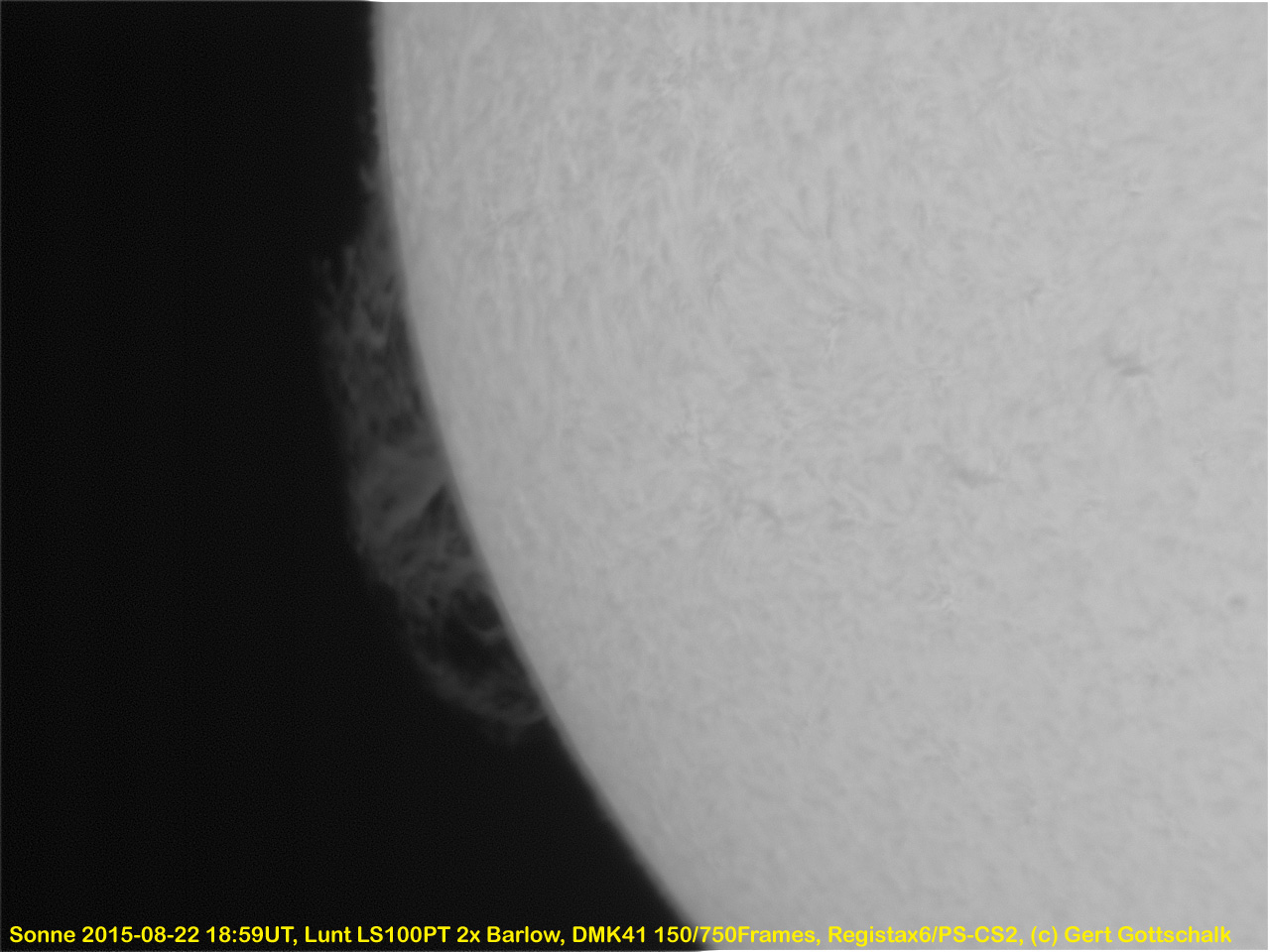
2015-08-22 19:01UT. Another promimences at upper left. The lower part has extensions over the surface area.
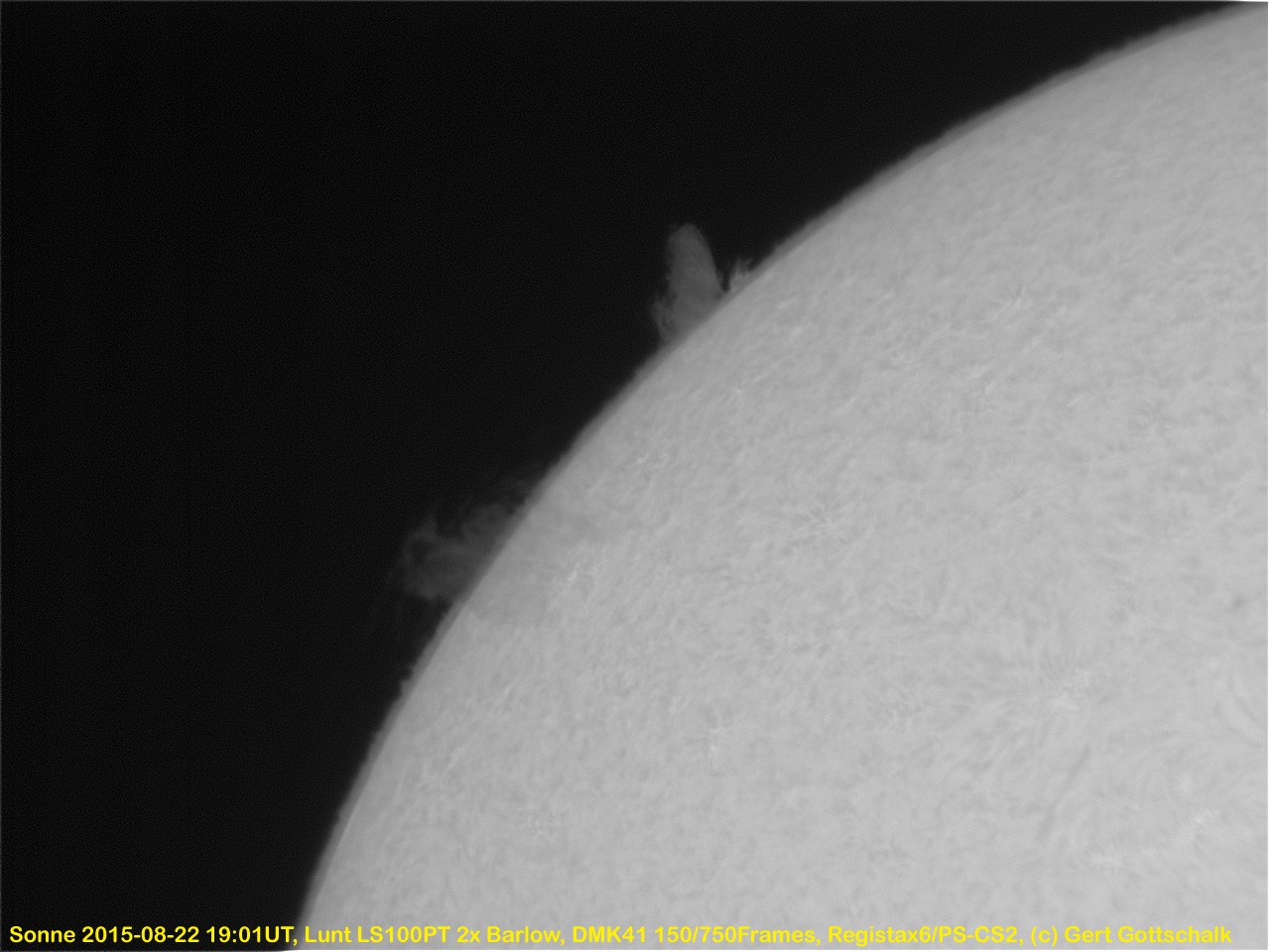
2015-08-22 19:04UT. Another promimences at right with some structure detail.
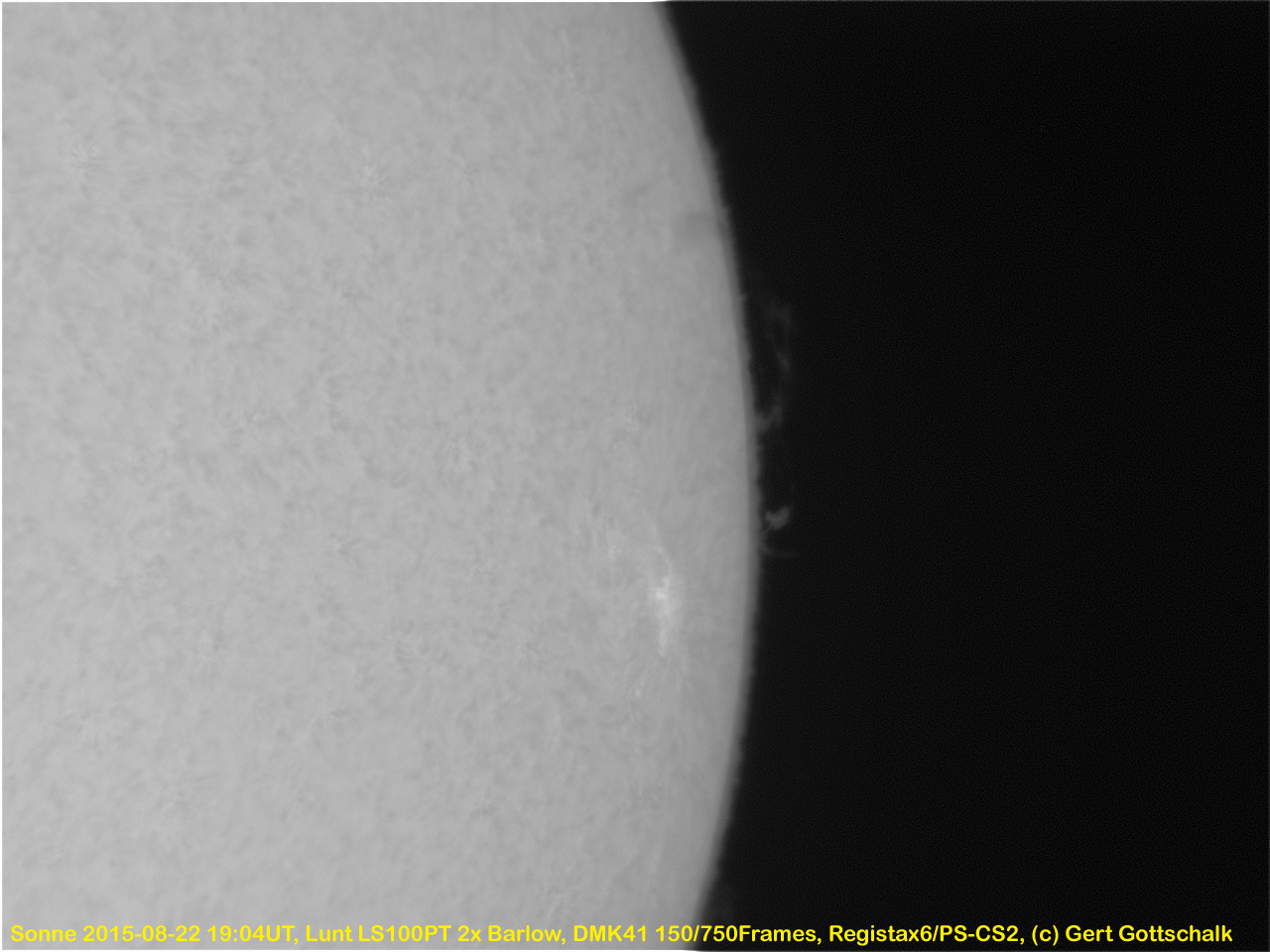
2015-08-09 18:10UT. The day had deep blue skies, just right to try H-Alpha imaging of the Sun. The fist image is from a combination of a surface and prominence exposure with the Lunt LS60PT in single stack mode with 0.9x Shapley lens.
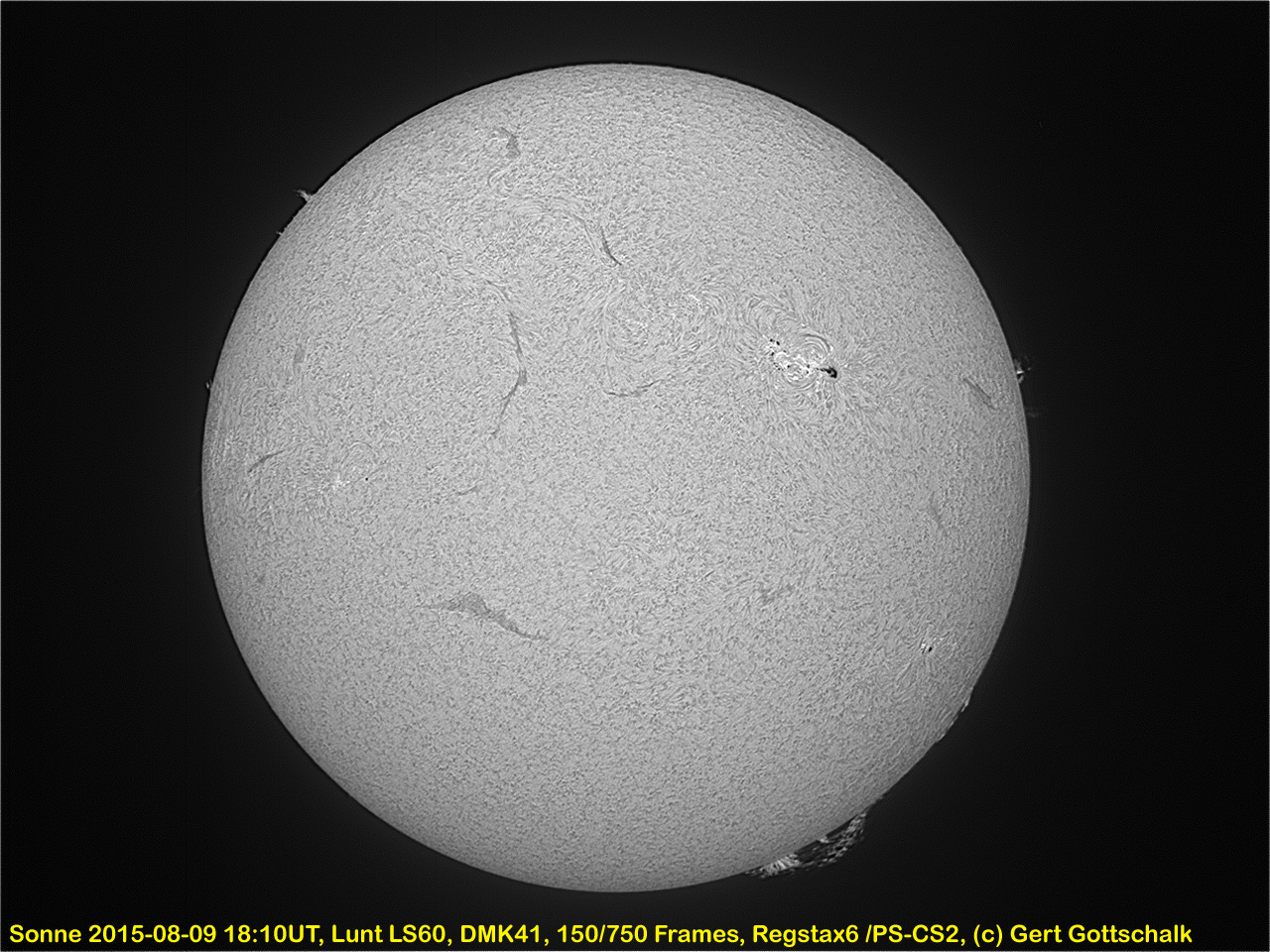
2015-08-09 19:30UT. The seeing appeared pretty good in the 60mm aperture Lunt LS60 and so I changed to the Lunt LS100 with 2x Barlow lens for some details. First image is a sun spot with a lot of detail.
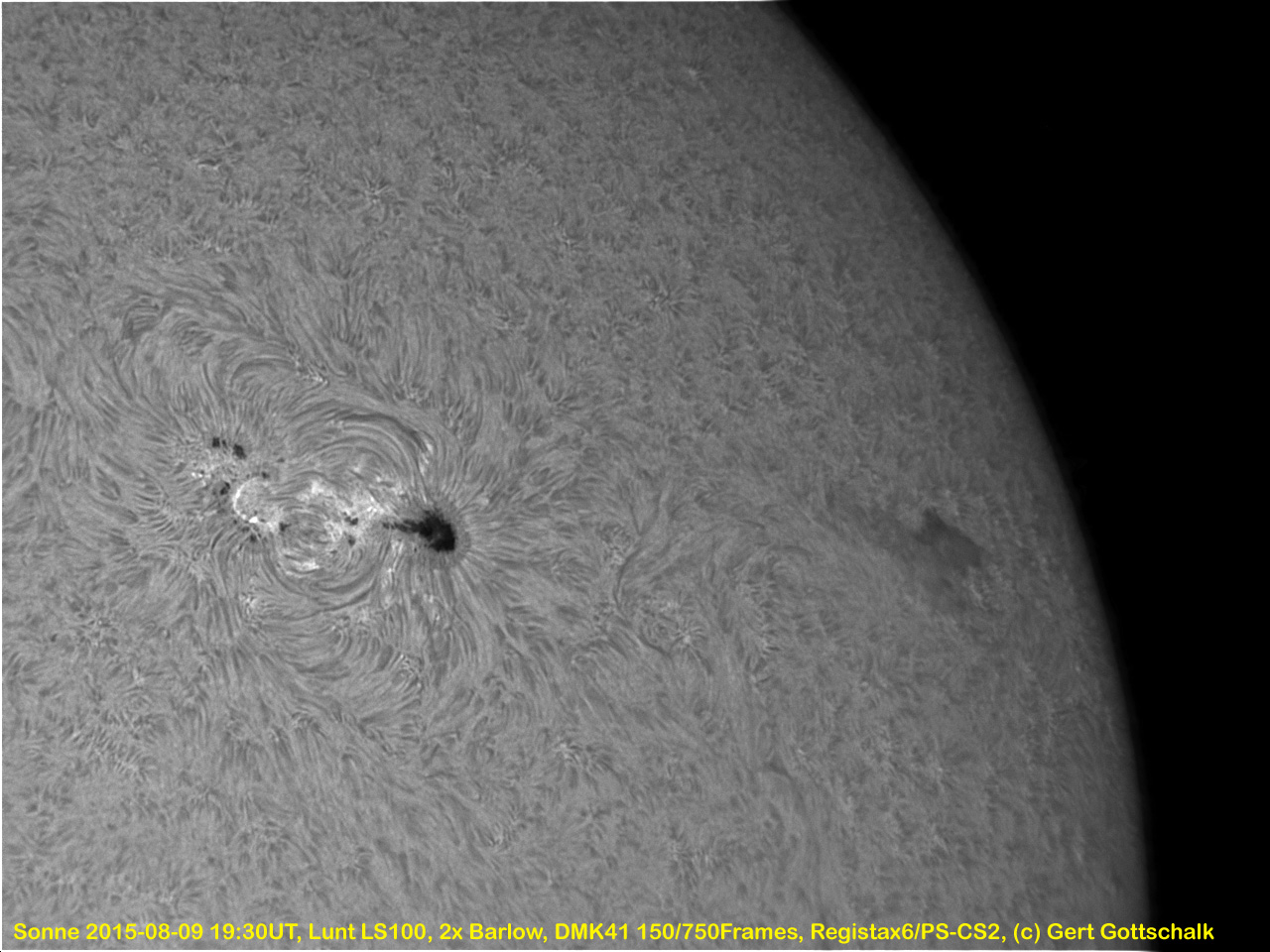
2015-08-09 19:32UT. some more detail on the Solar surface.
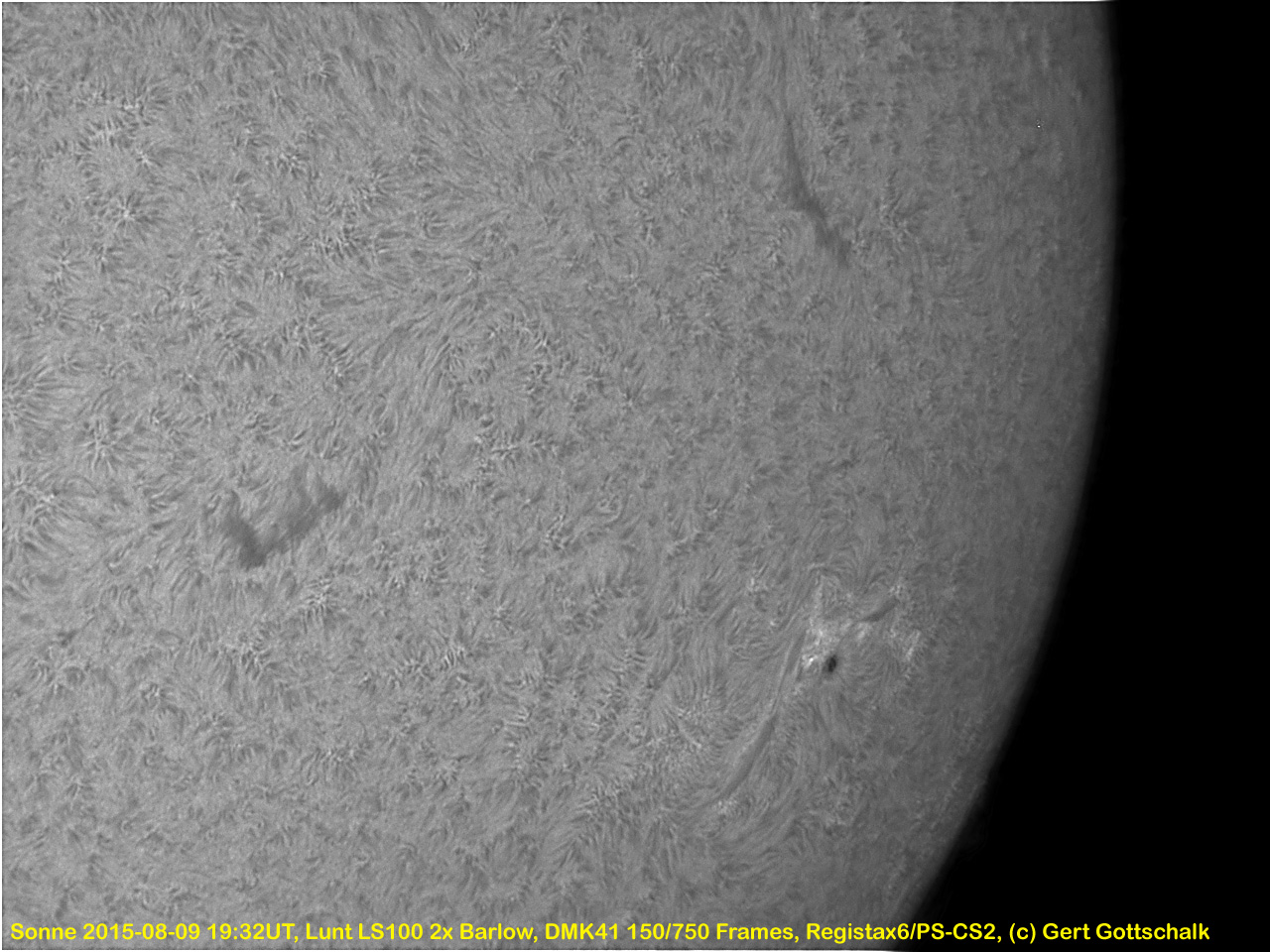
2015-08-09 19:35UT. The opposing limb of the Sun, too had some nice surface detail.
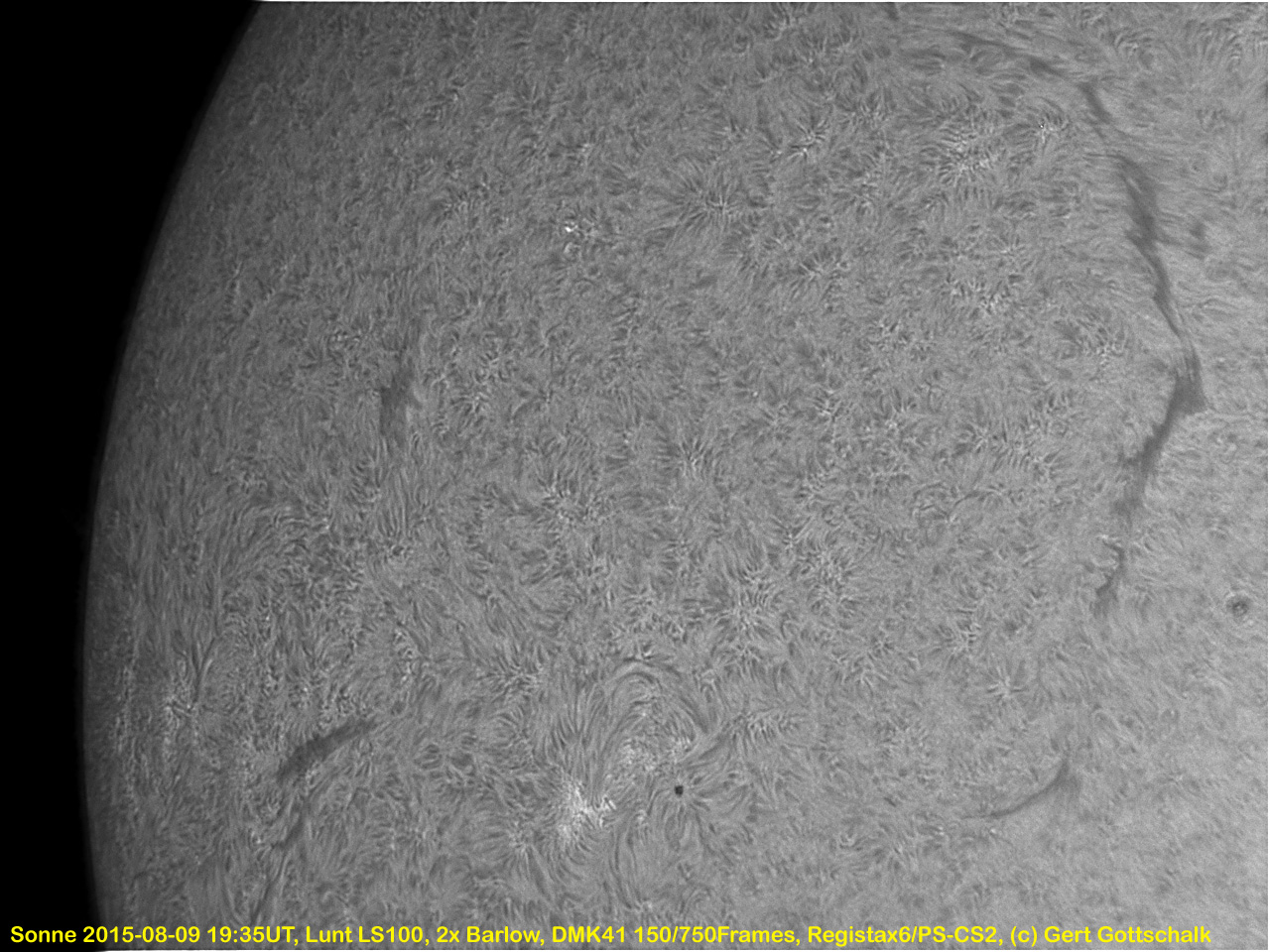
2015-08-09 19:45UT. At the same limb a longer exposure shows a nice small prominence.
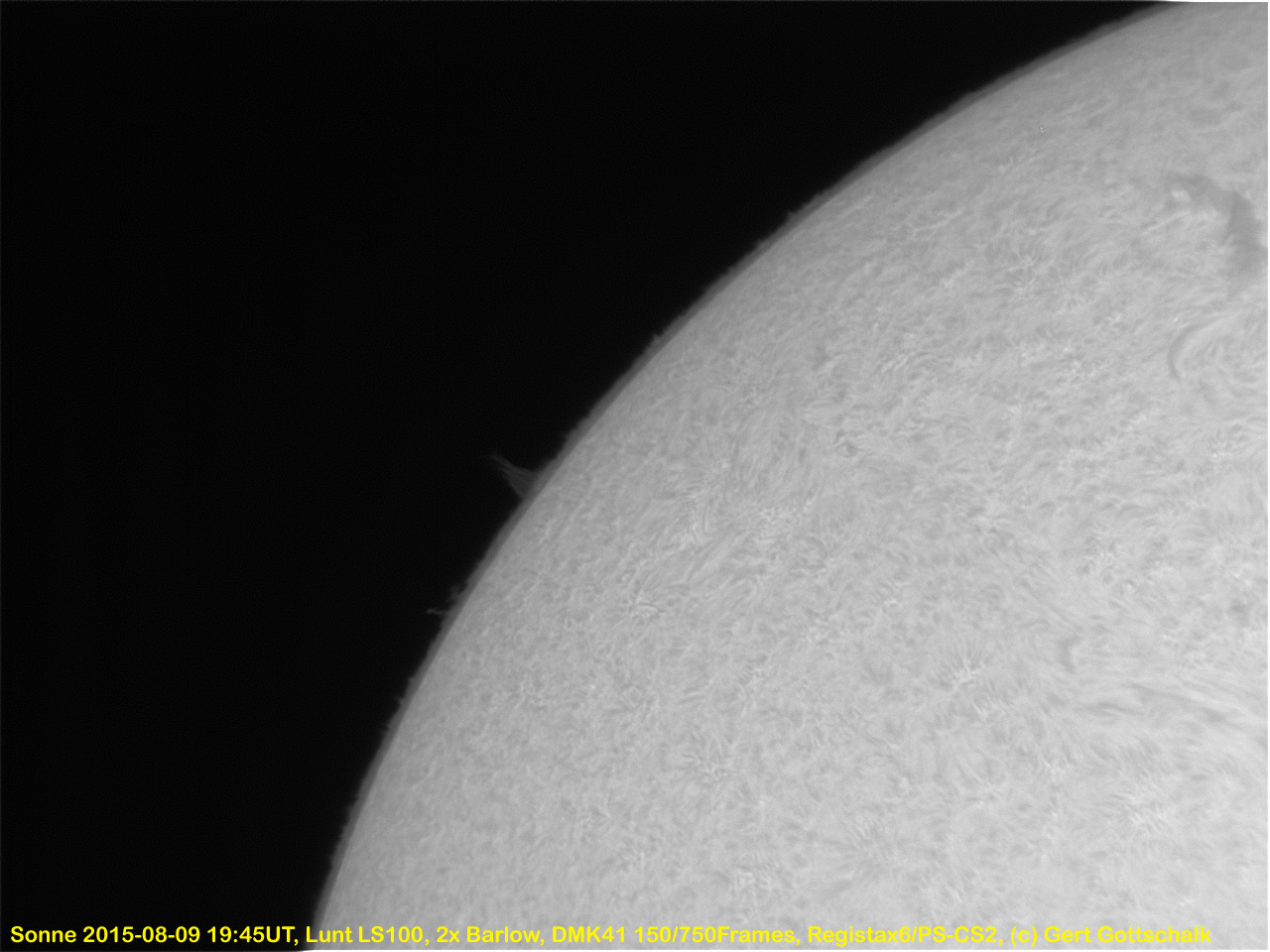
2015-08-09 19:43UT. At last a very nice prominence.
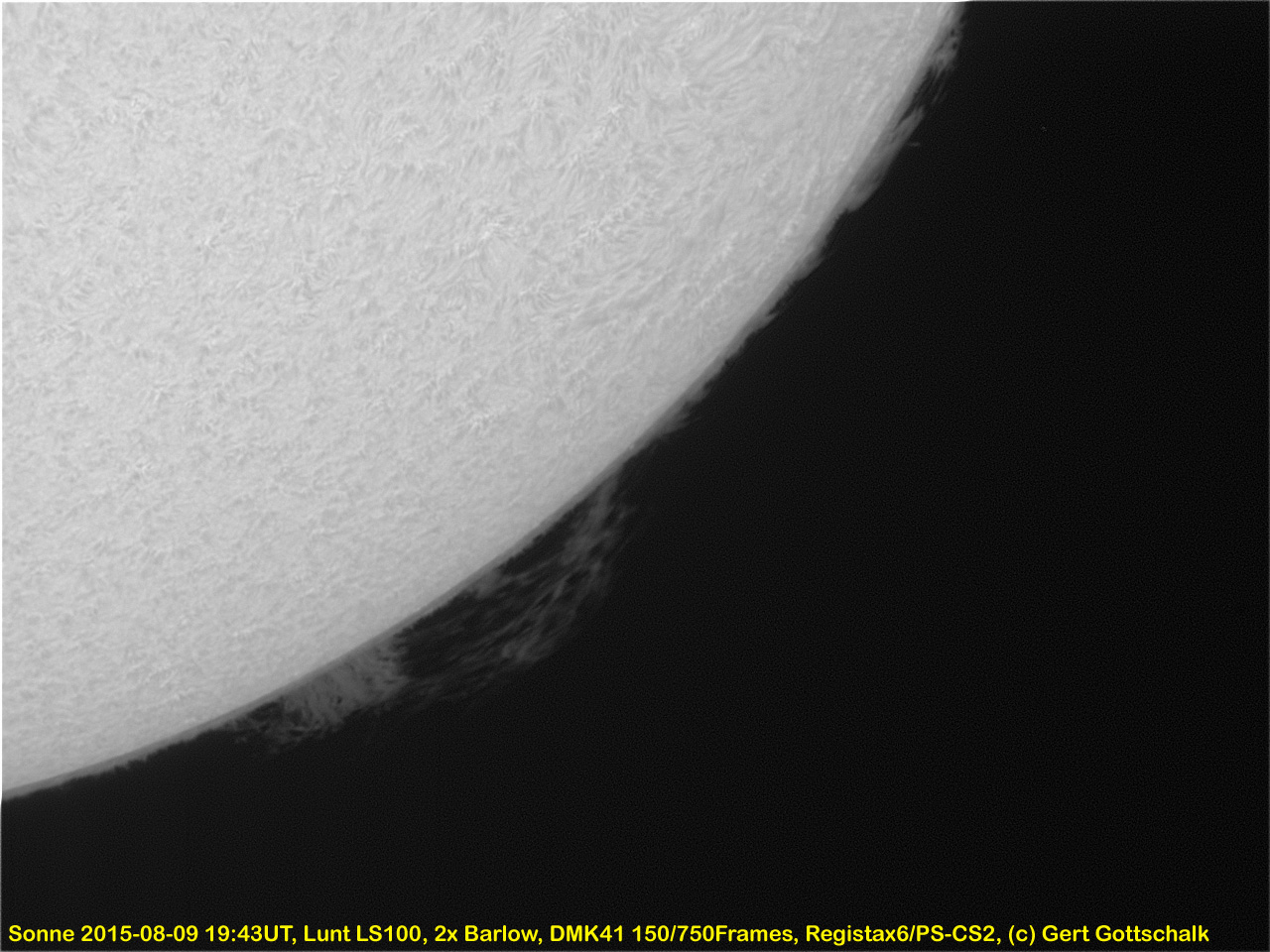
2015-07-26 18:16UT. There was little activity on the Sun today. I took images with the Lunt LS60 in single and double stack mod. First a composite of single stack exposures for the surface and prominences. A very faint piece of a prominence is at left far above the solar limb. The first two images here again use the 0.9x Shapley lens to adjust image scale to the DMK41 sensor chip.
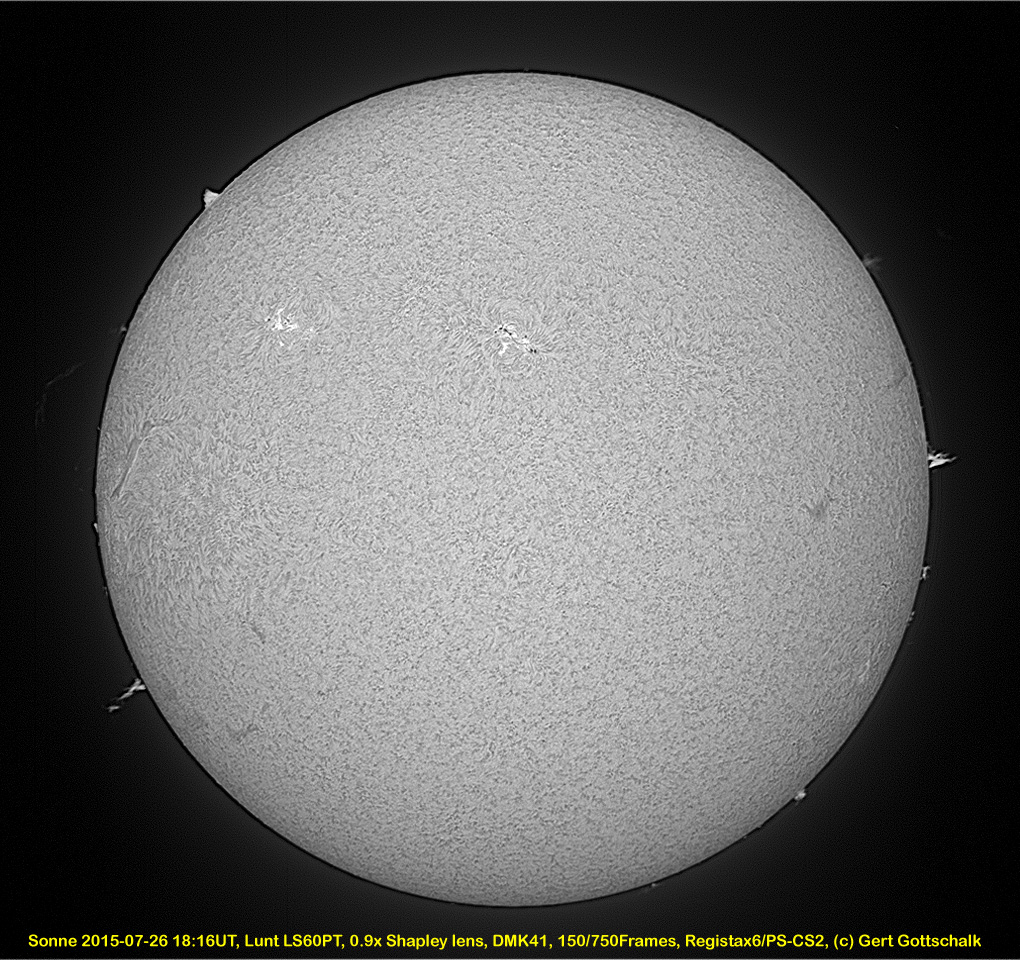
2015-07-26 18:20UT. Next using the double stack filter there is increased contrast in the image.
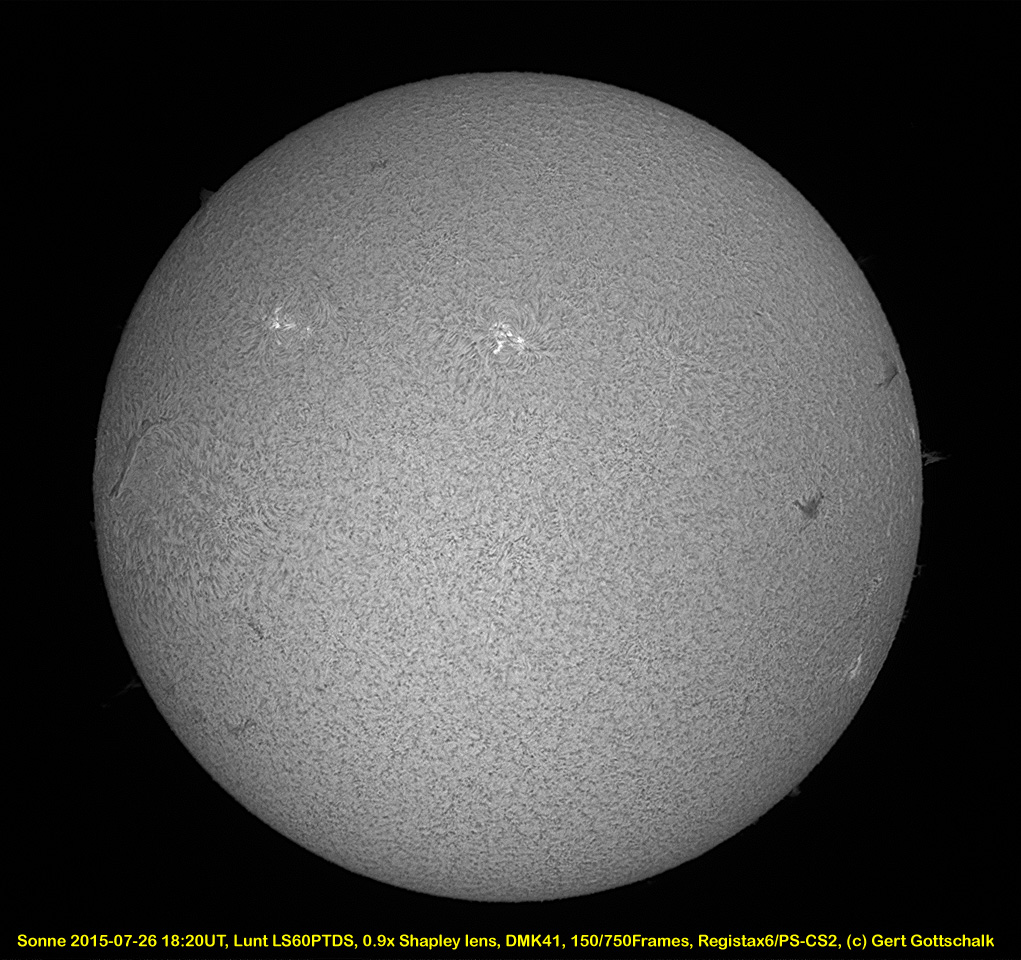
2015-07-26 18:27UT. The seeing conditions were not too bad and I tried using the Meade 3x shorty Barlow lens. It has only a small spot of Newtons rings (bottom center) so it is quite useful for images with the Lunt in double stack mode.
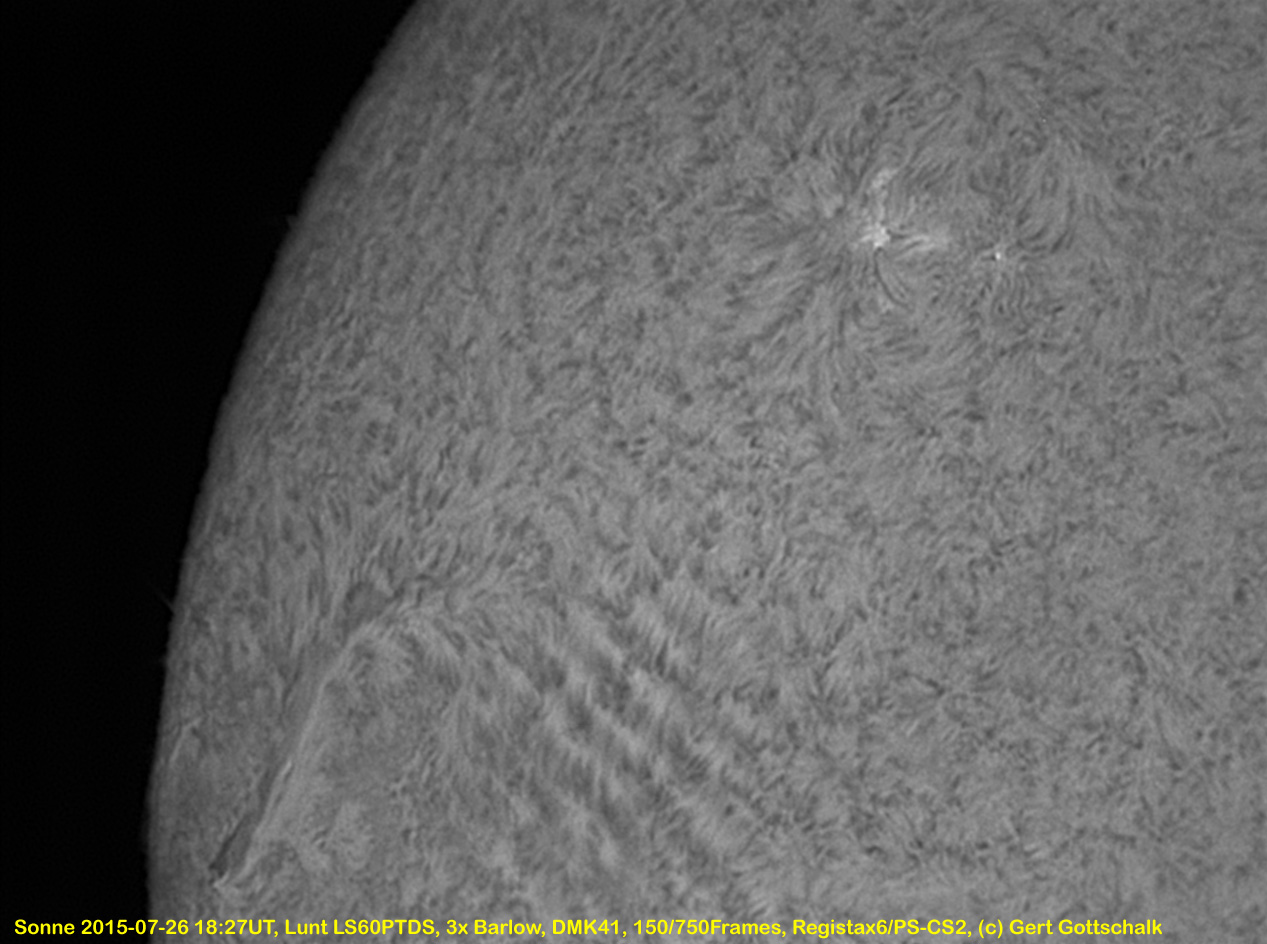
2015-07-18 17:40UT. After a little break this is the first image of the new observing series. First a composite of a surface and prominence exposure with single stack filter.
The image uses the 0.9x Shapley lens to fit the entire disk onto the DMK41 chip.
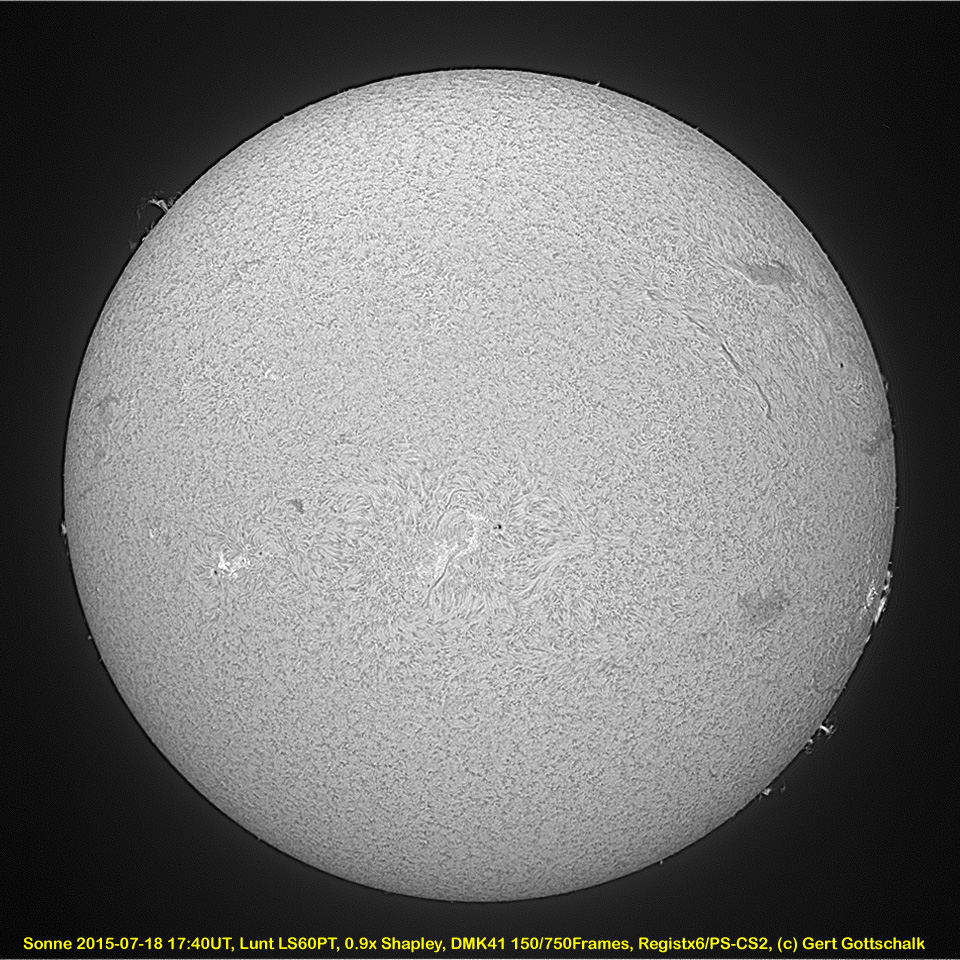
2015-07-18 17:49UT. Next an single image using double stack filtering. The surface contrast is more dominant.
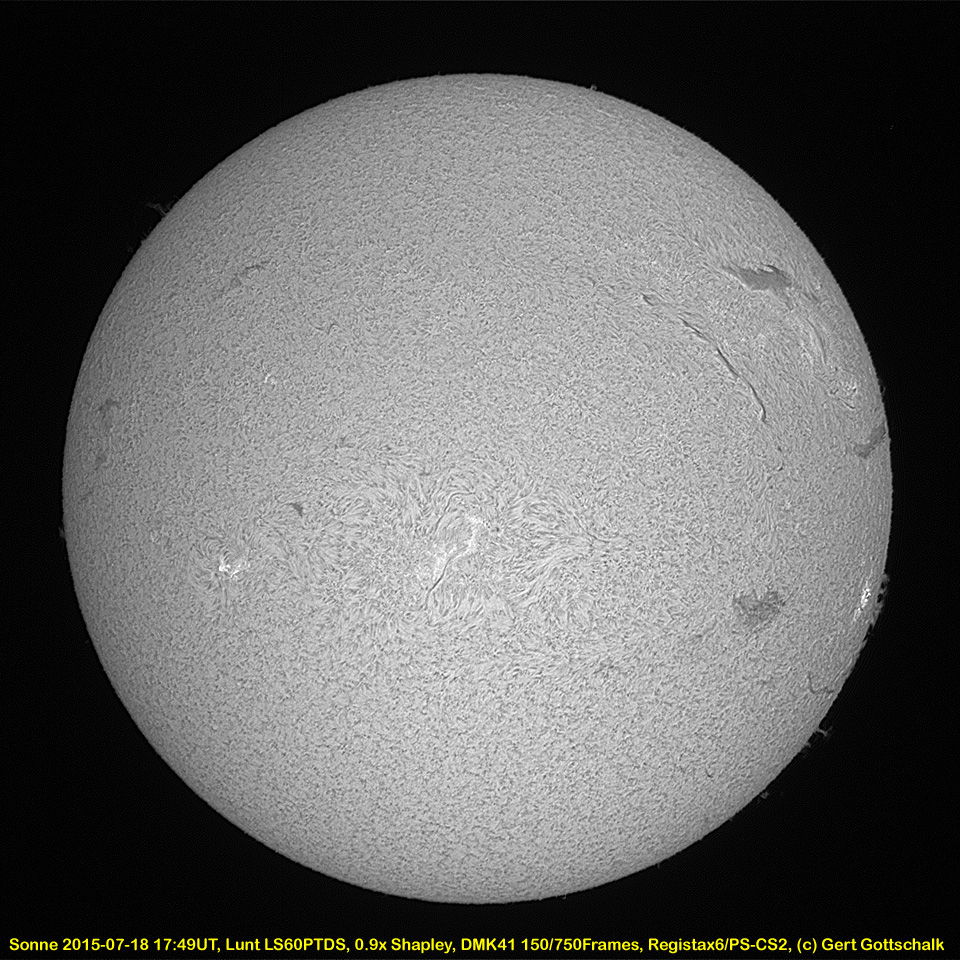
2015-06-21 18:28UT. The sky was very clear today with some moments of good seeing. The contrast with the double stack filter was very crisp and it was used for this full disk image and the subsequent details.
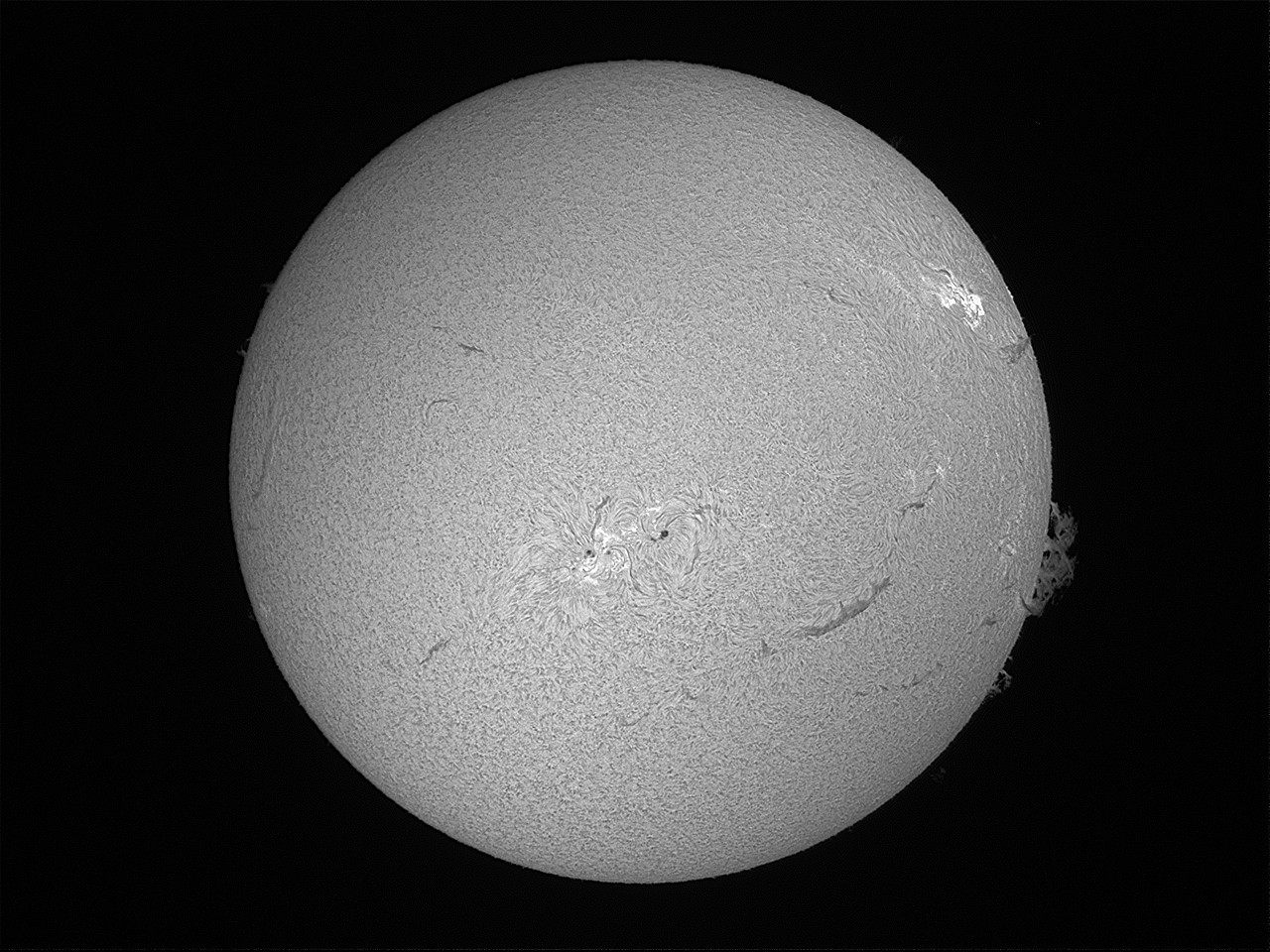
2015-06-21 18:40UT. The activity region at upper right showed a weak flare which is overexposed in the full disk image. With a 3x Barlow lens and shorter exposure the eruption became more detailed.
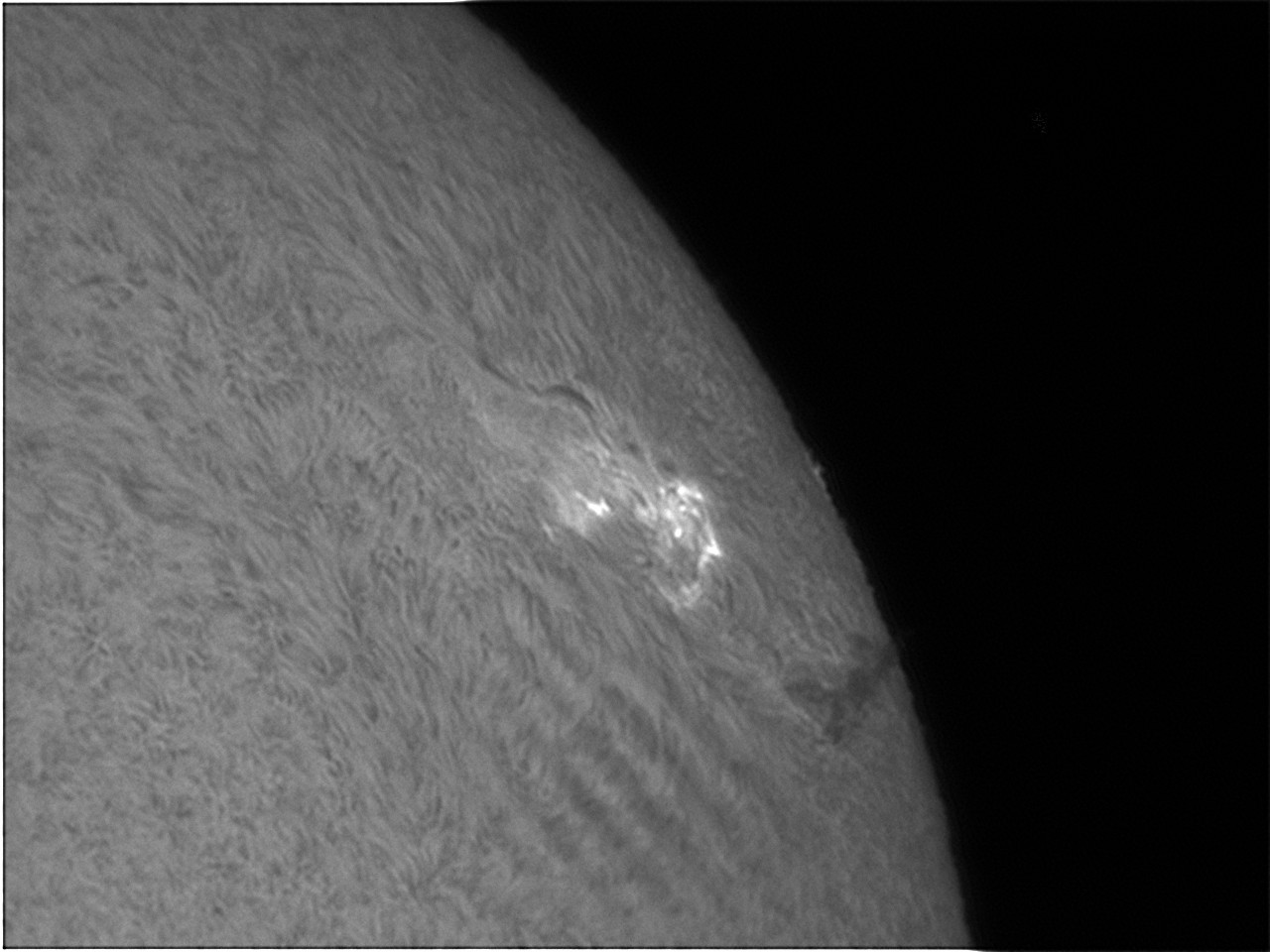
2015-06-21 18:42UT. With longer exposure and softer contrast the nicely structured prominence at right shows a lot of detail.
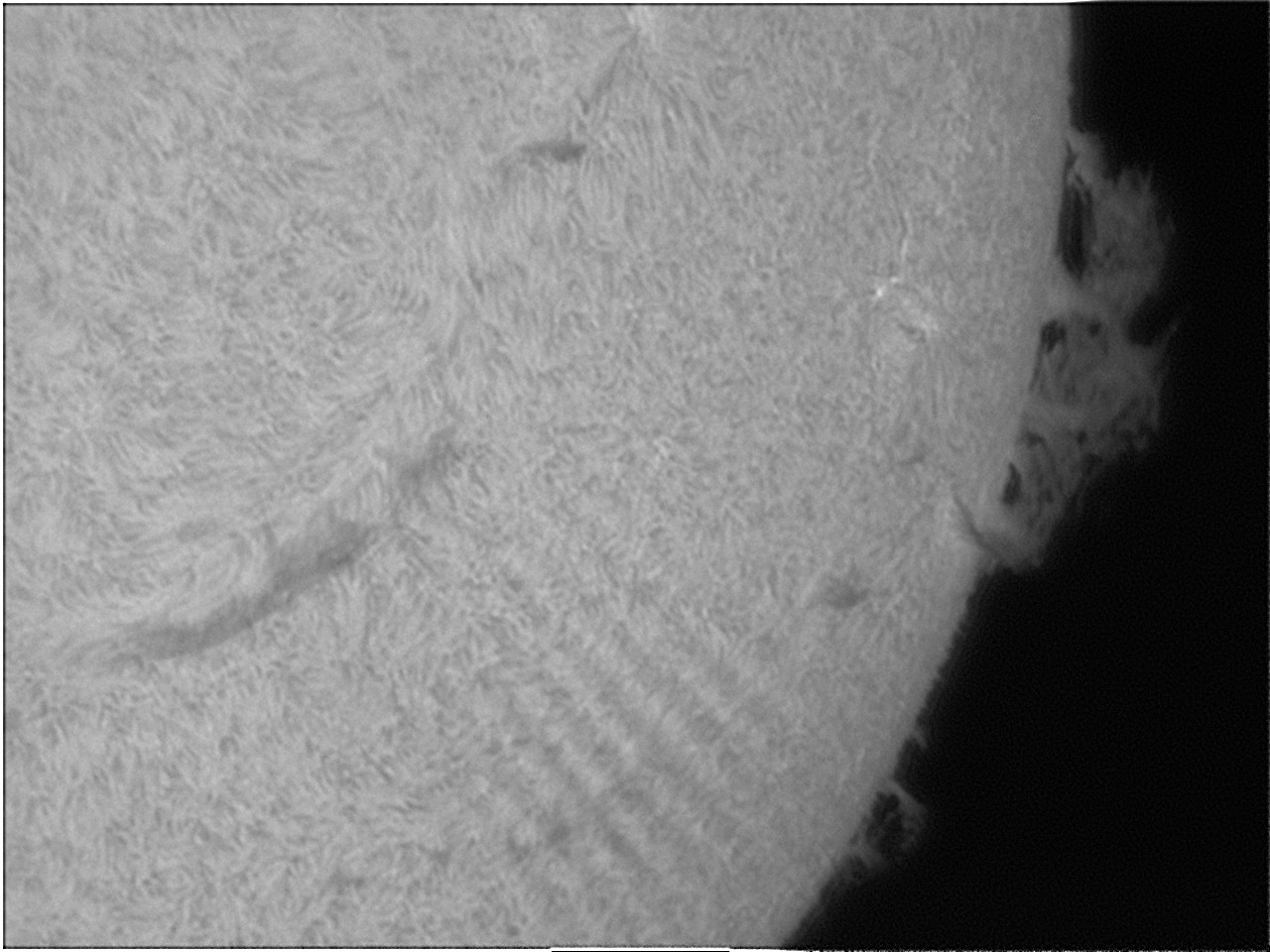
2015-06-21 18:45UT. The two active sun spots near center show a lot of H-Alpha structures.
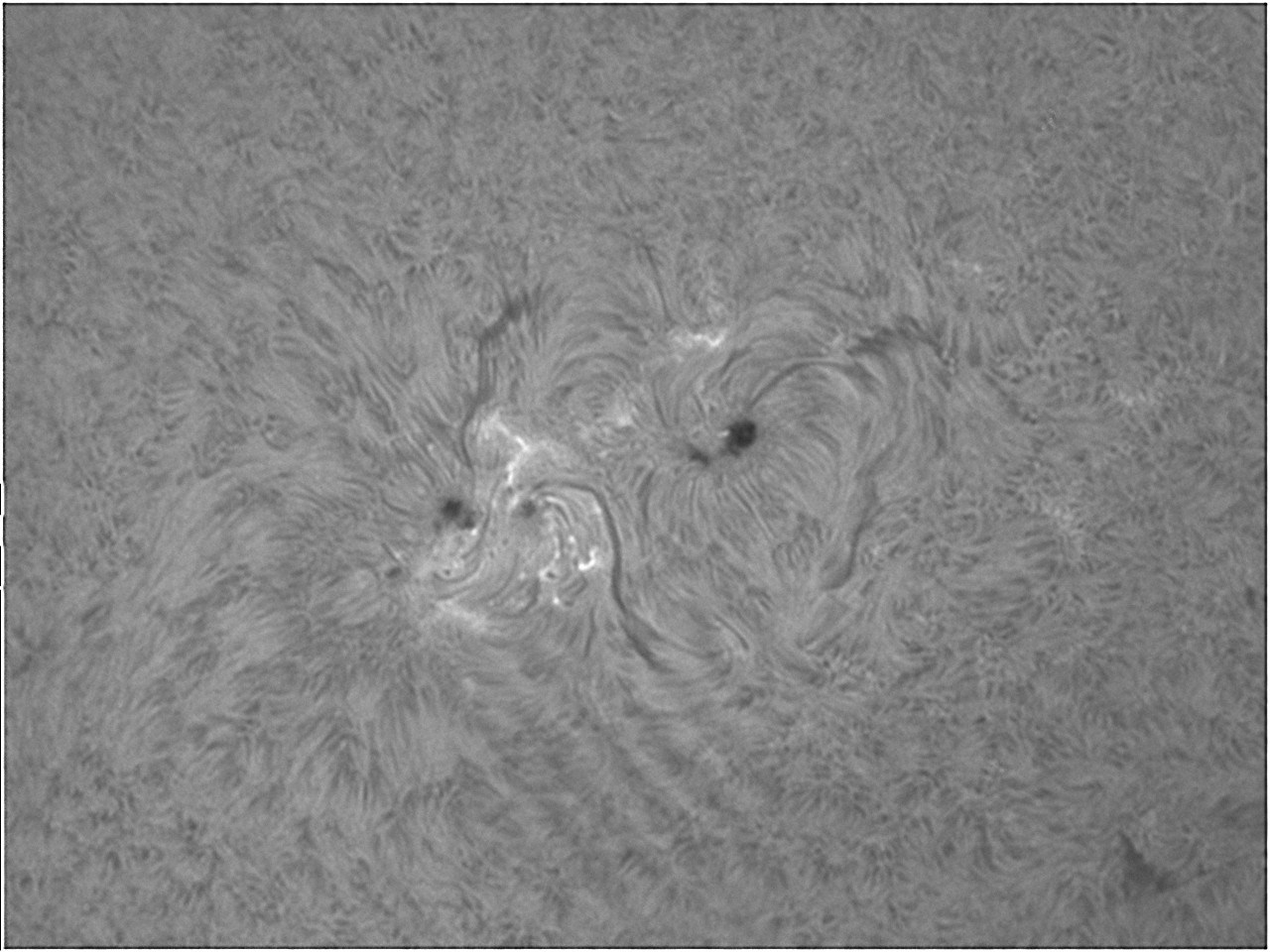
2015-06-14 18:26UT. There were some nice but not very luminous prominences on the sun today.
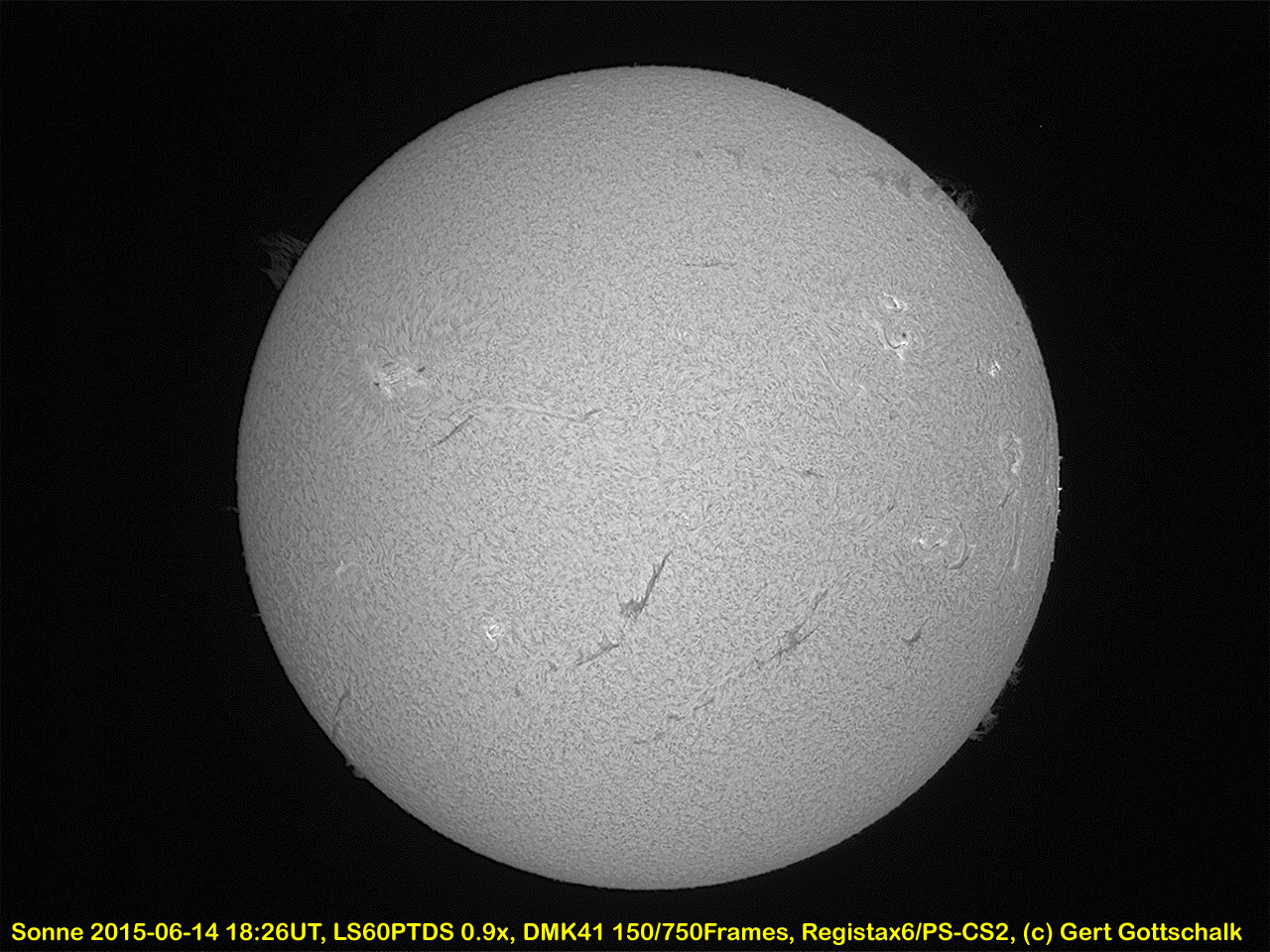
The prominence at upper left was target for an animation. Total of 11 frames were merged into a little movie.
2015-06-13 18:15UT. The Sun is nearing its highest point of the year. A good day to use the 60mm Lunt solar telescope with double stacked filter and the 0.9x Shapley lens.
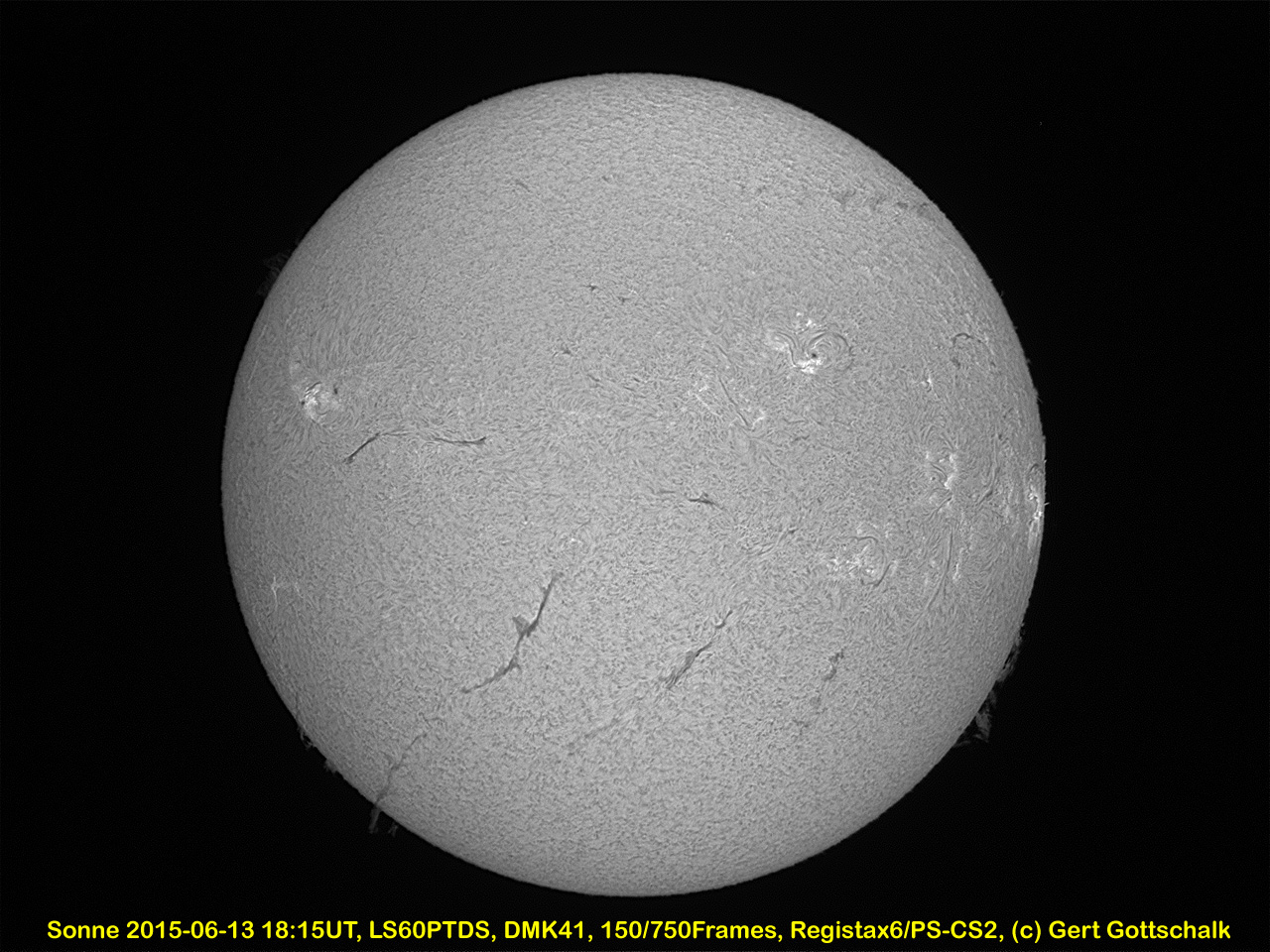
2015-06-13 18:20UT A little later with the same filter setup the 0.9x Shapley l;ens was replaced with a Meade 3x shorty Barlow lens to study some details. First the filament at lower left.
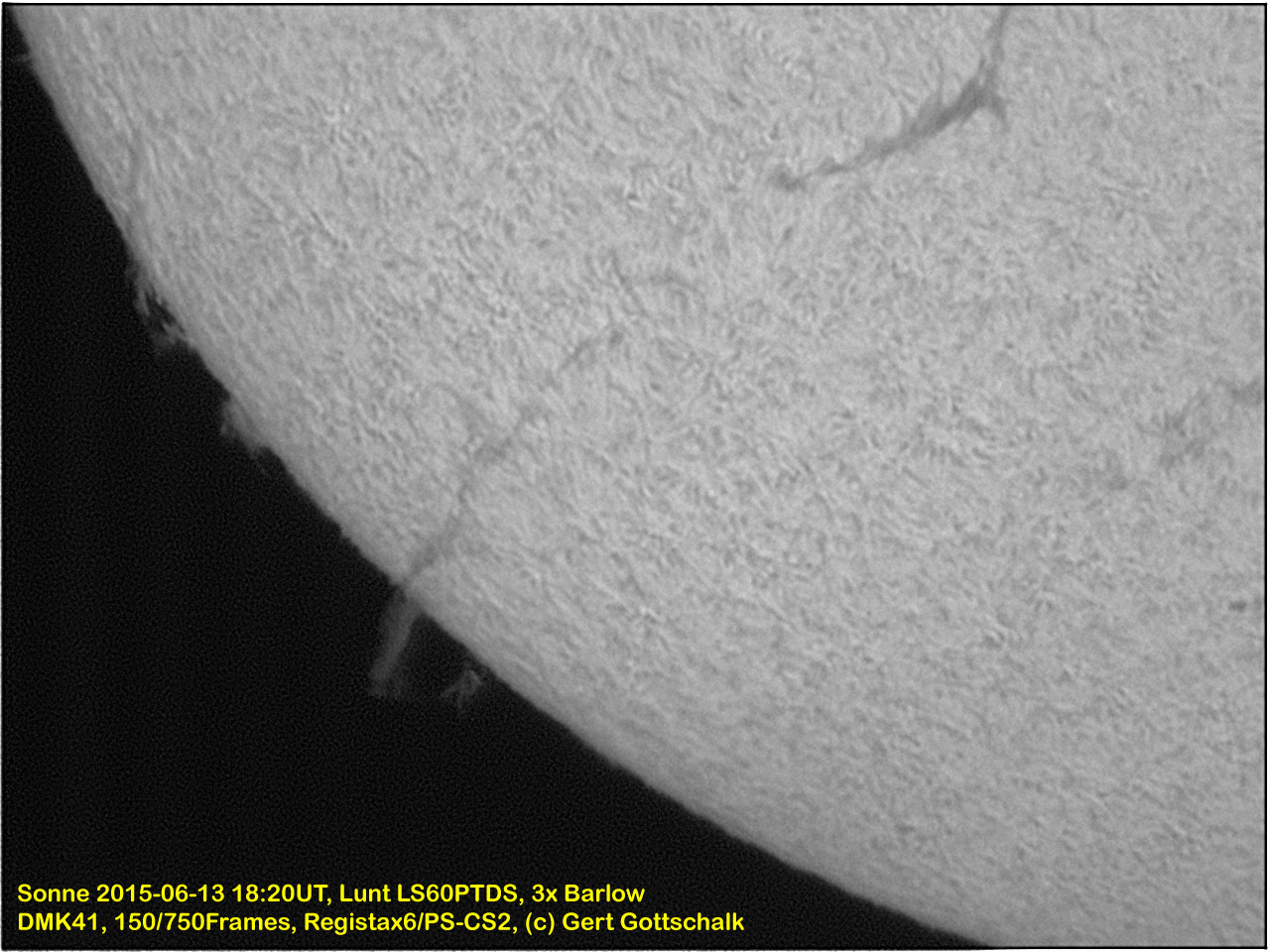
20015-06-13 18:35UT With the 3x Barlow lens a 3 frame composite was made from a series of activity spots at the right limb of the Sun.
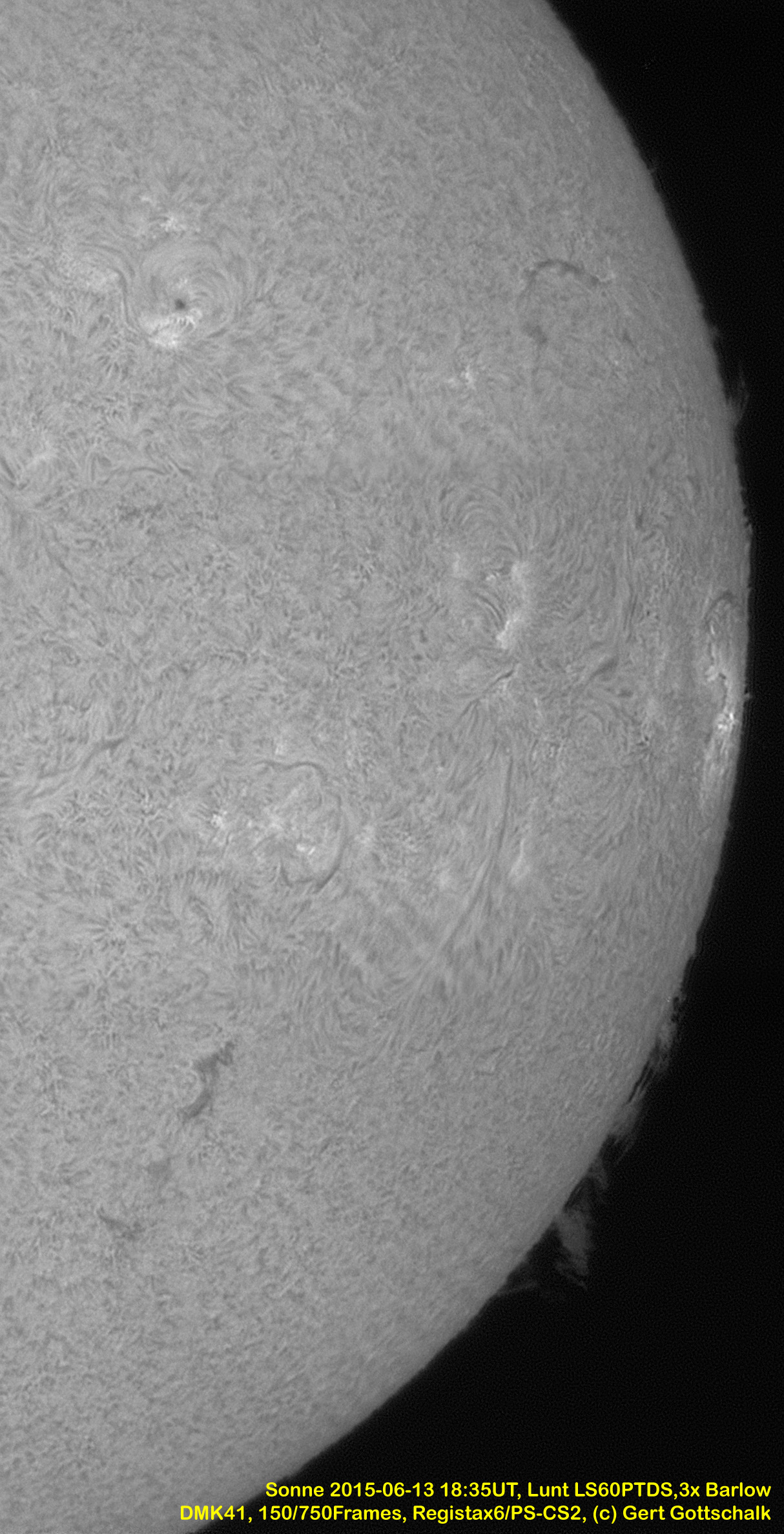
2015-06-07 18:46UT. Another sunny day but this time I used the Lunt LS60PT-DS for an overview image with the 0.9x Shapley lens. Thus the whole solar disk was captured on the DMK41 chip.
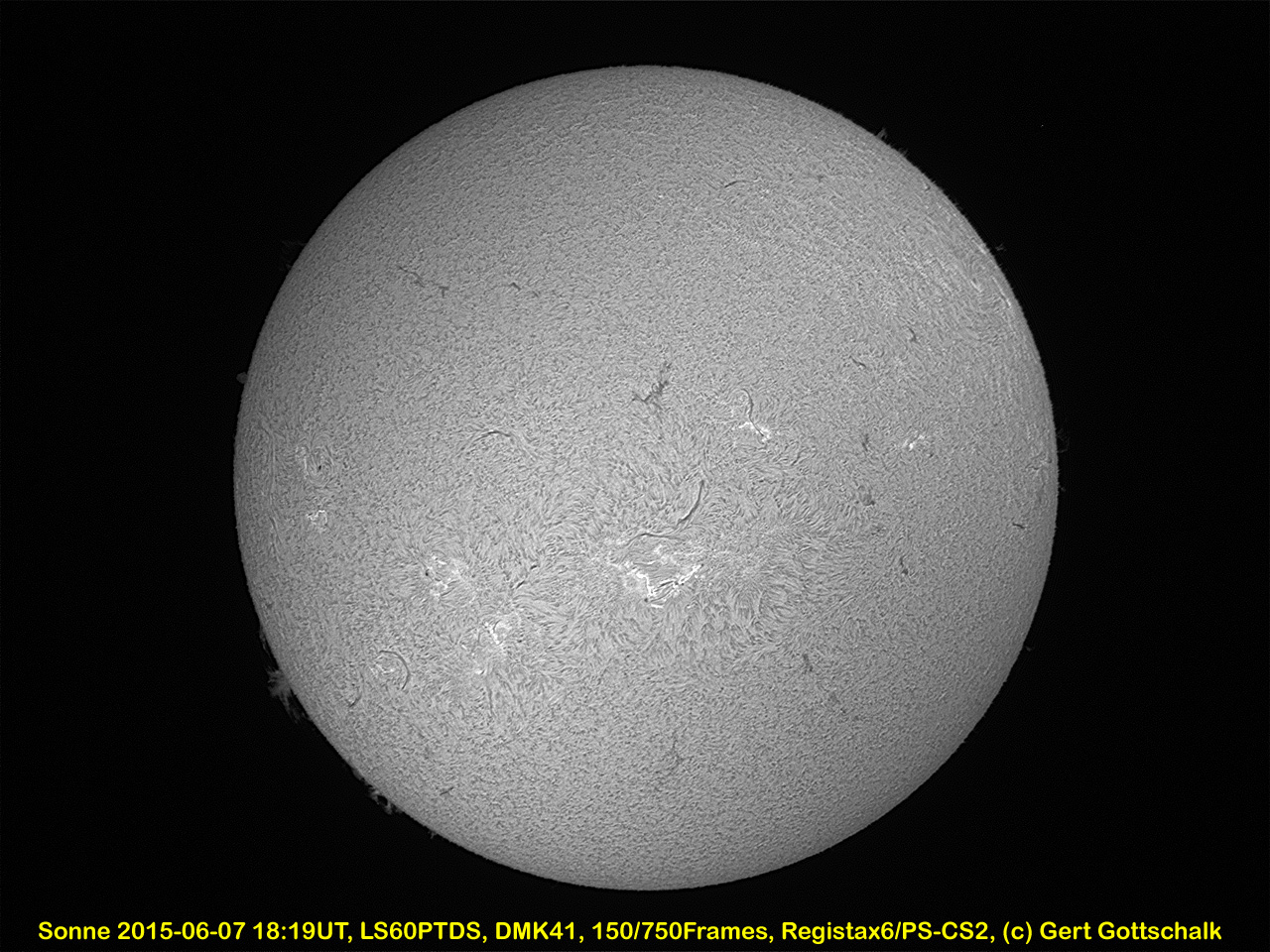
2015-06-05 19:30UT. The weather was nice and clear and I wanted to use the contrast of the LS100 to shoot some high resolution images.
This one at 19:39UT with a Meade shorty 3x barlow. The HA-fringing is quite mild with this barlow and I'll keep it in mind for later experiments with the Lunt HA-scopes.
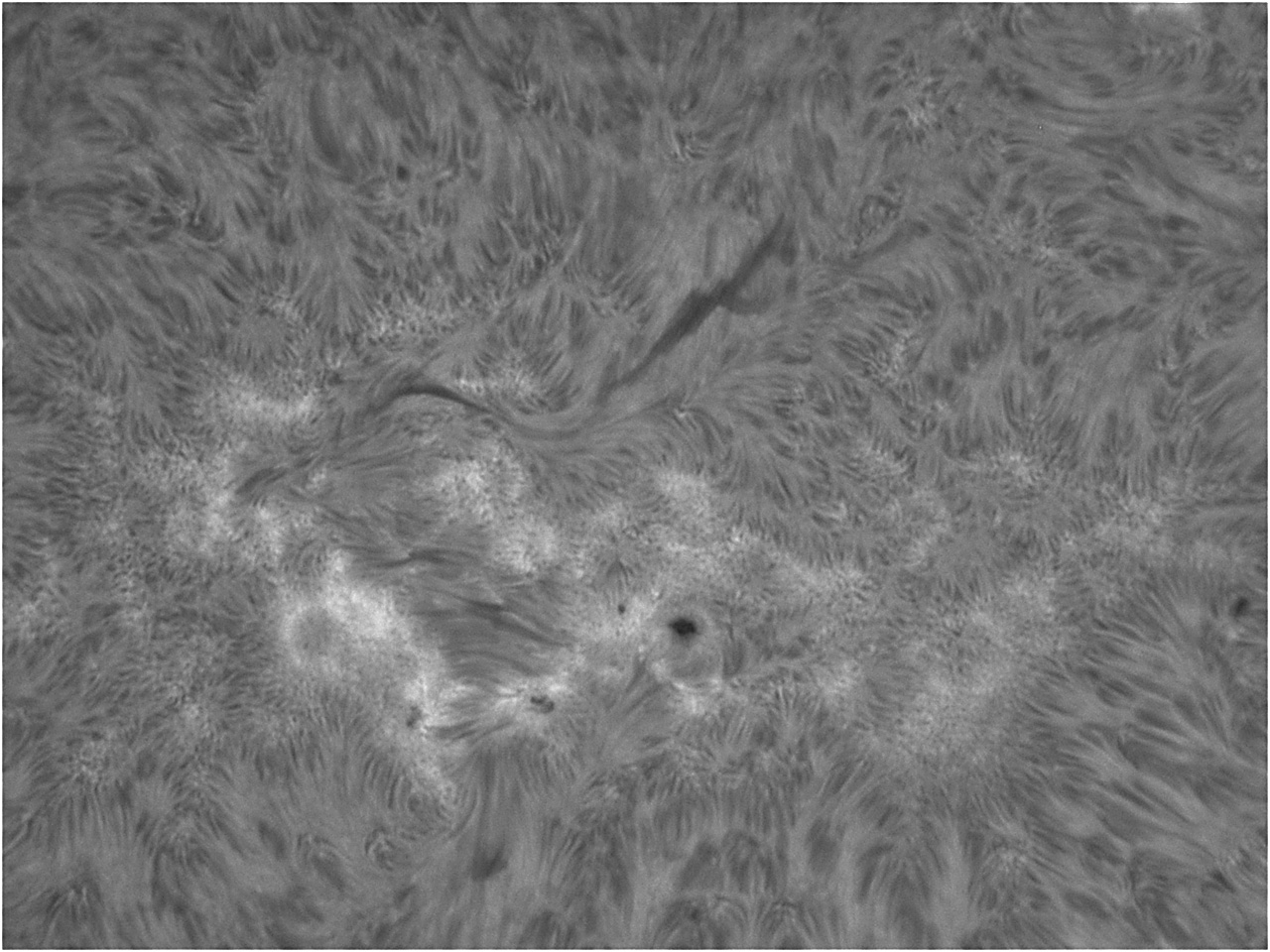
Another on with the 3x barlow at 19:26UT. A small prominence. We can see the HA-chromosphere on to of the solar photosphere. (the sharp edge of the sun shining through)
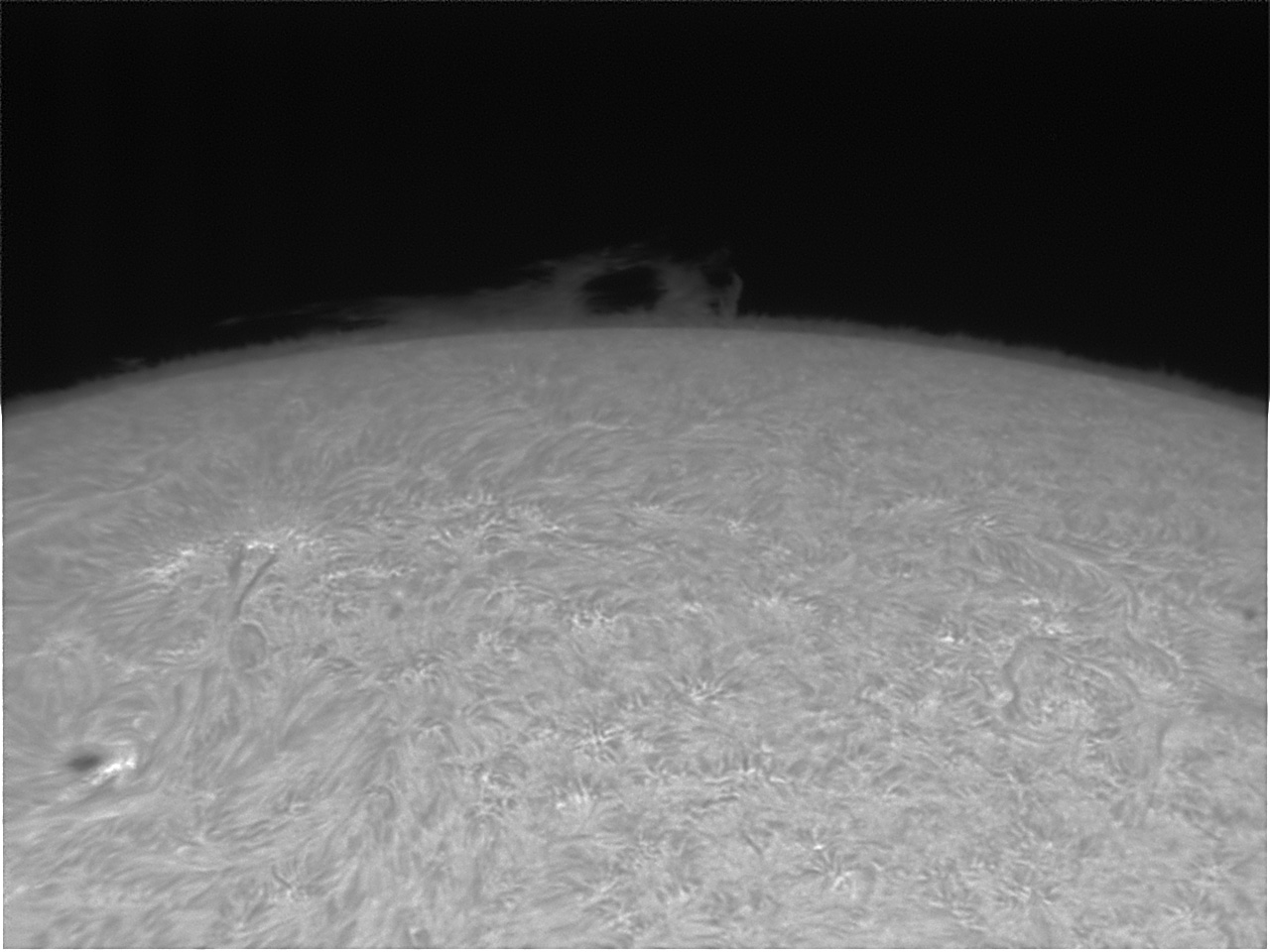
I tried a multi frame anmation for the prominence, but only 3 frames were shrap enough to be used. So it's rather short. there was also not much activity in the prominence. Only a small movint filament at left.
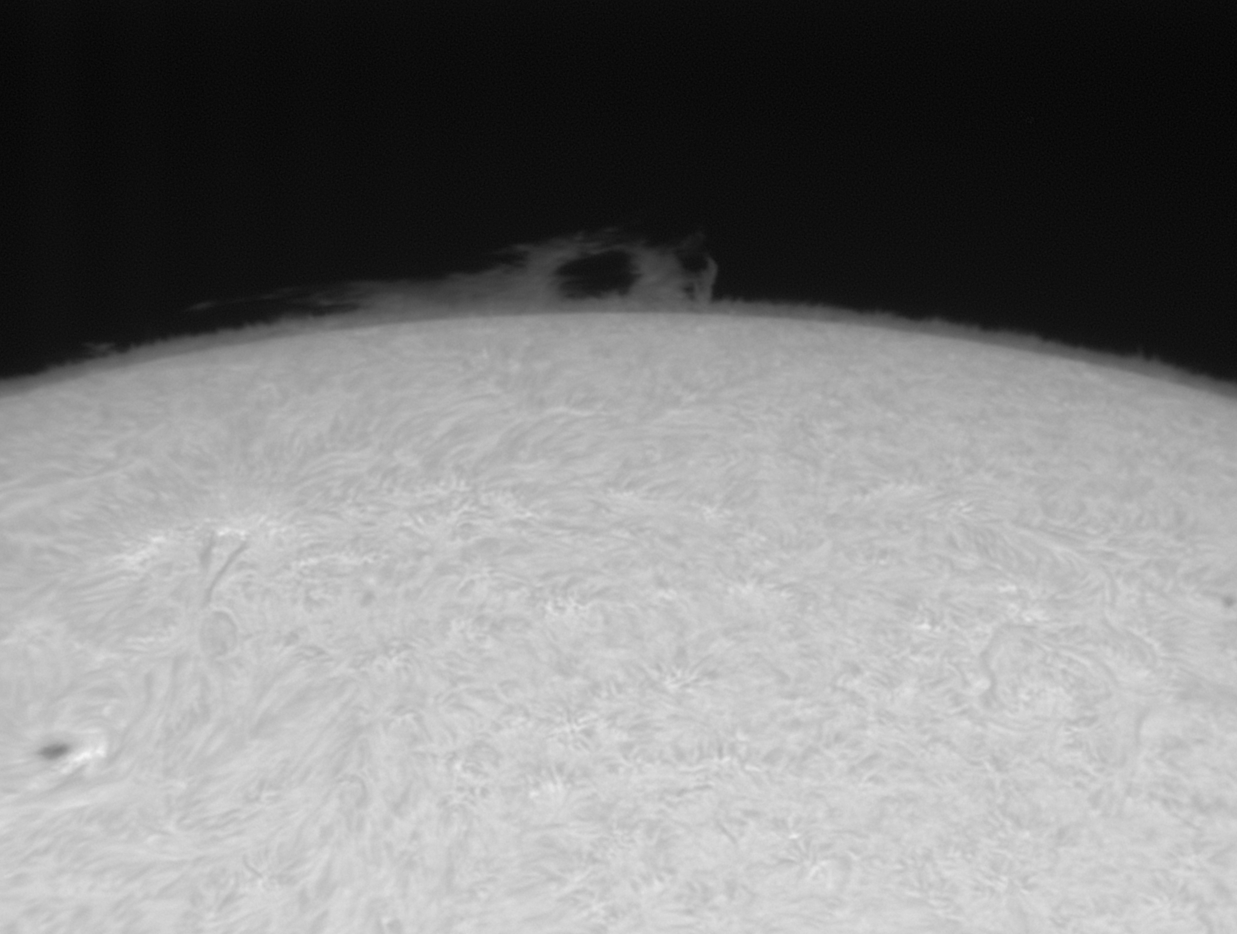
With the 800mm focal length of the LS100 there is not much use for full disk images. I have to use 4 frames and there are always variations in sharpness causing artefacts.
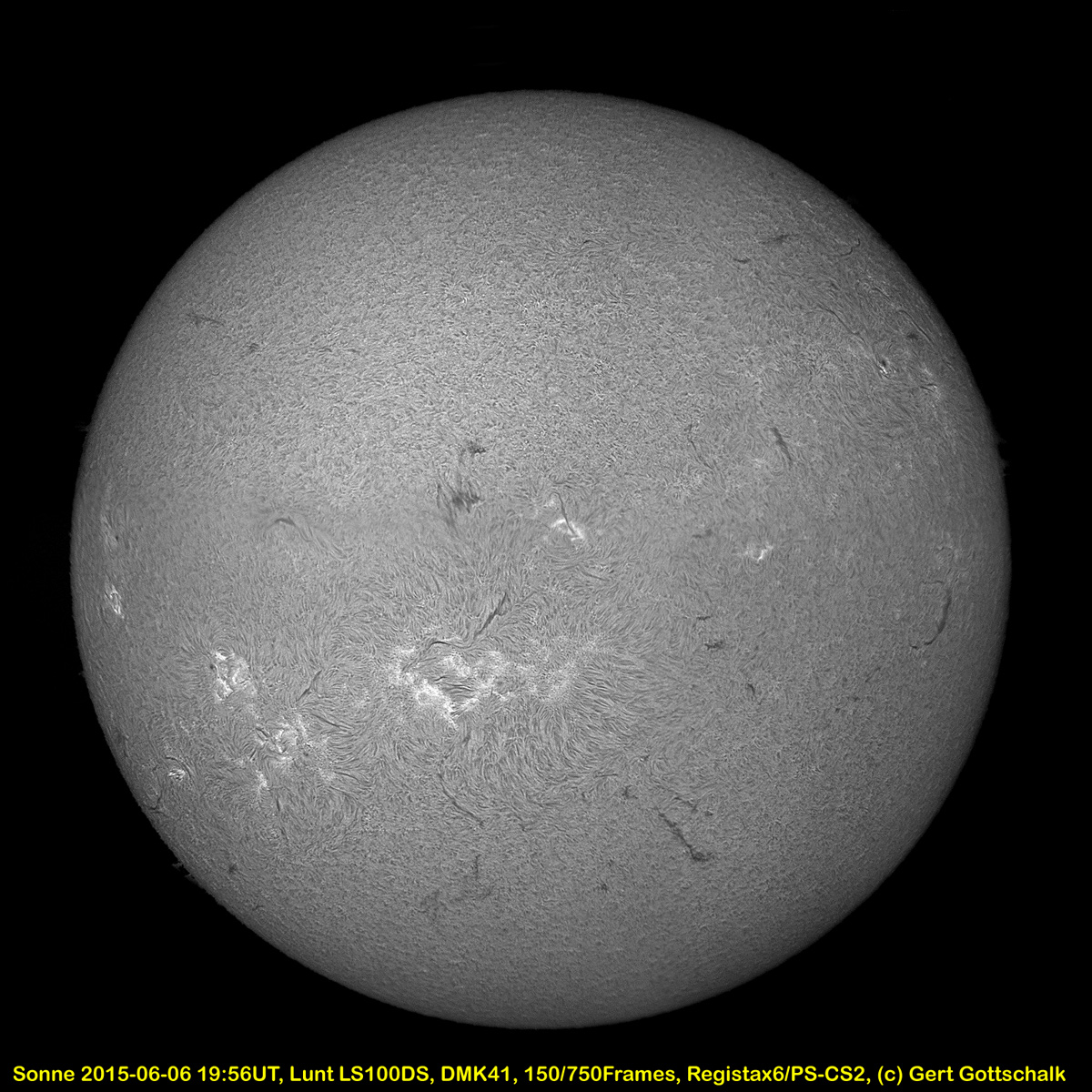
2015-05-16 18:46UT. First light of the new Shapley lens added to the imaging train. The lens is just in front of the camera and allows the whole solar disk to be captured in one shot. This image is a composite of two exposures capturing the solar disk and the prominences at different brightness levels. Both images were taken with the single stack filter.
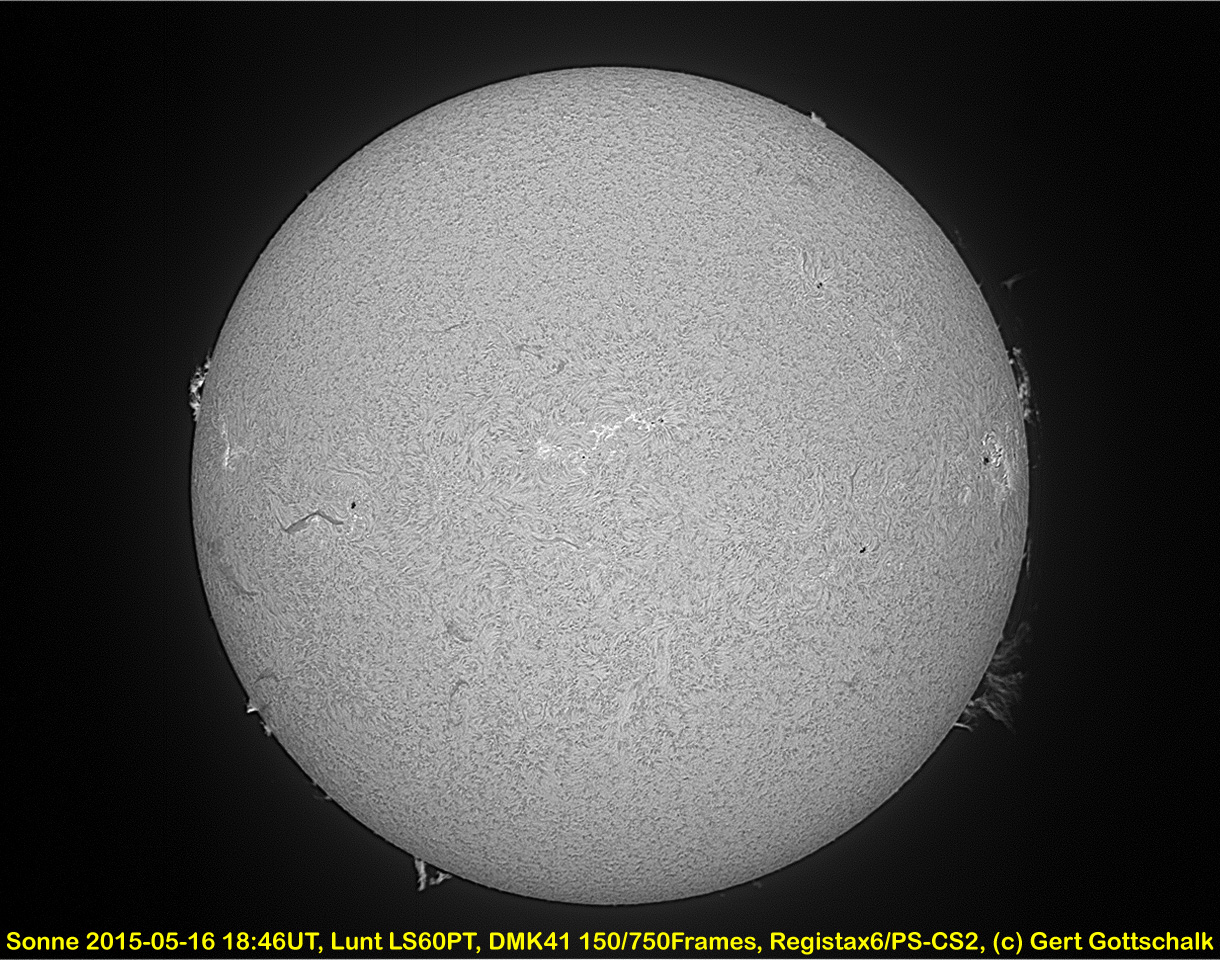
2015-05-16 19:01UT. The double stack filter got to use the Shapley lens as well. Here prominences and disk show well at the same time in a single exposure.

2015-04-26 18:15UT. Following rain on Saturday the sky was transparent on Sunday morning. Seeing was average and the 60mm Lunt scope was used. To improve contrast the double stack module was added.
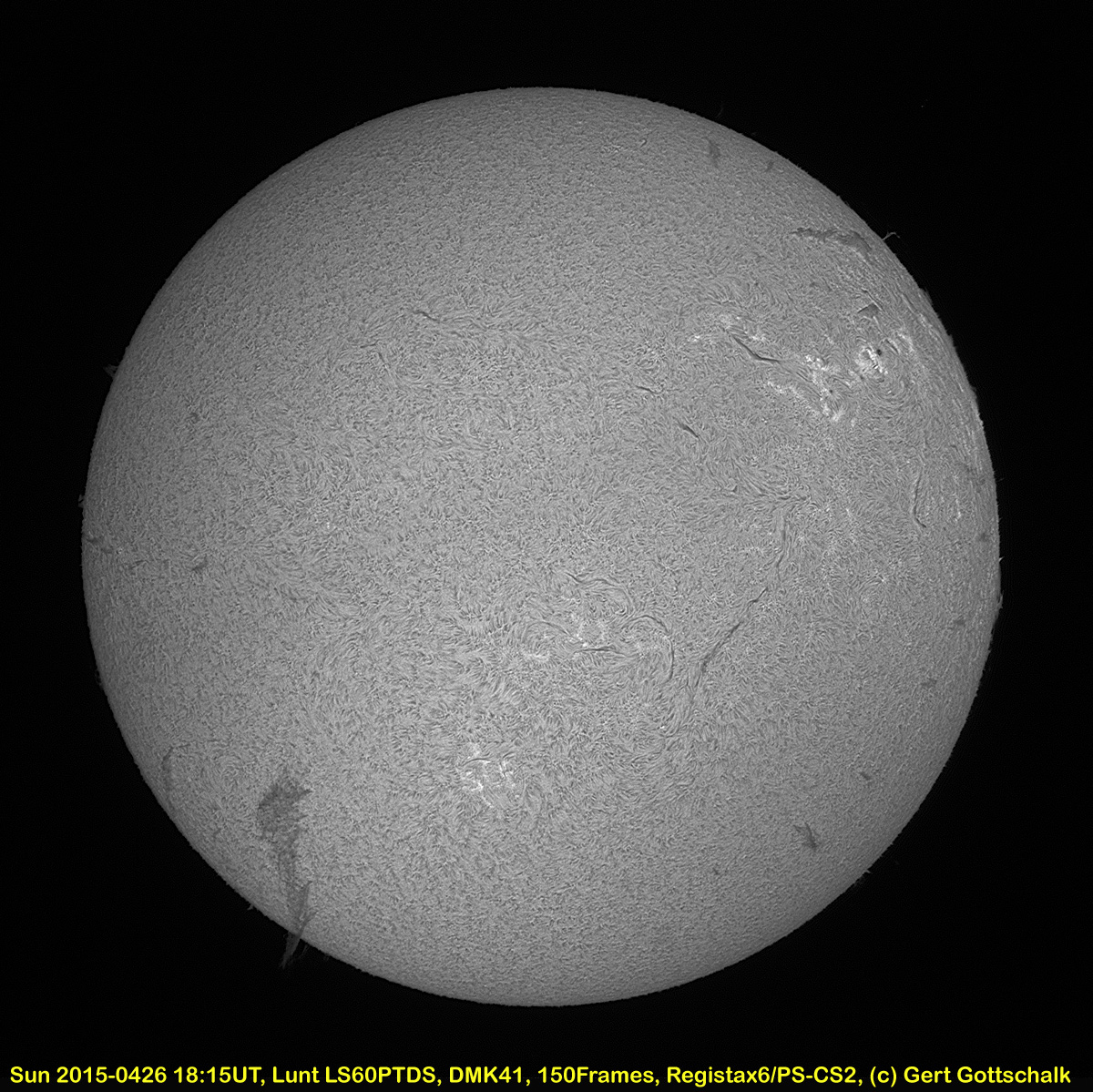
2015-04-18 18:28UT. This weekend I wanted again to take a full disk composite image of the sun and accordingly the 60mm Lunt scope was used. There was not much prominence activity and so it made more sense to use the double stack unit for enhancing the surface contrast.
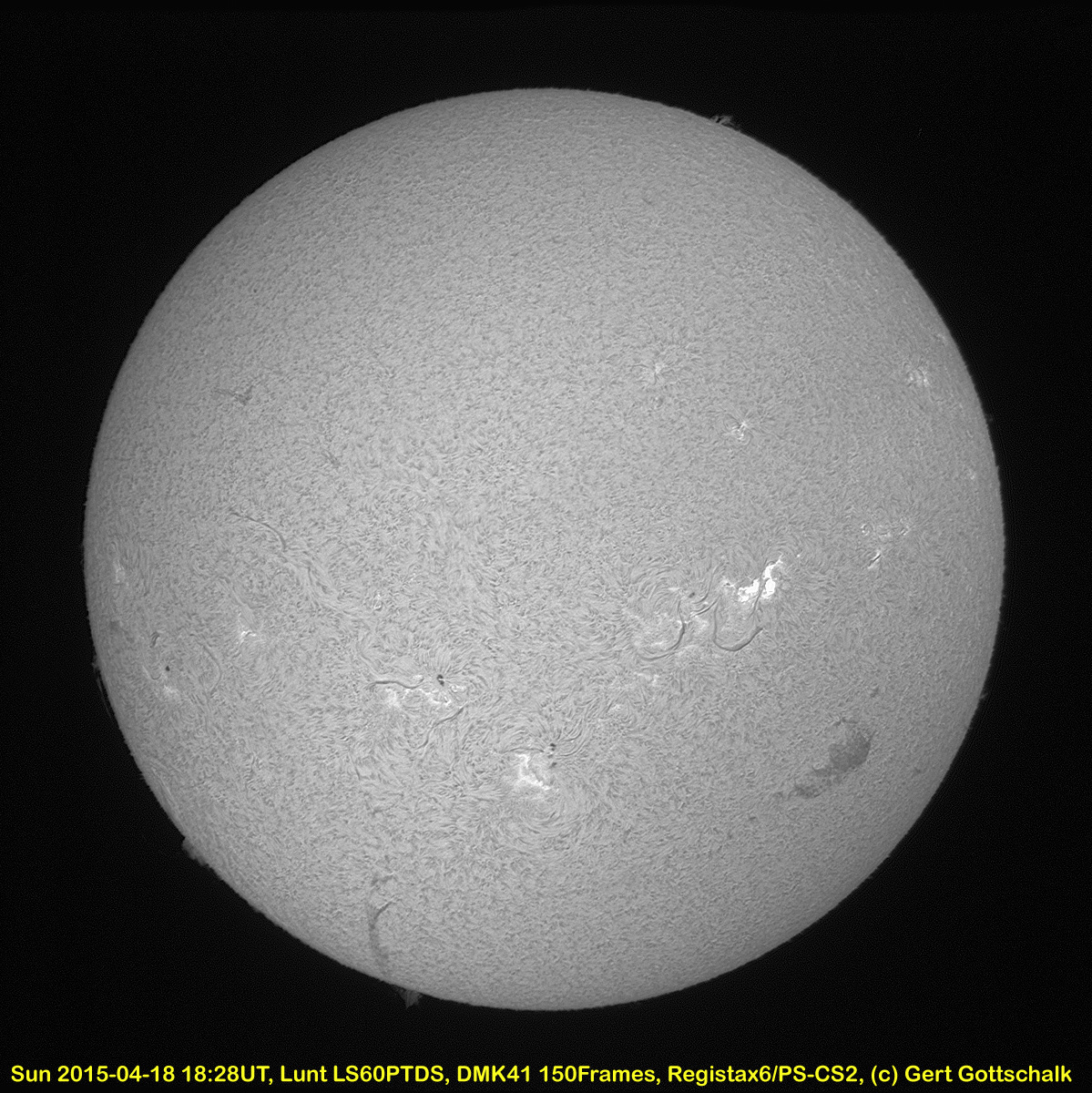
2015-04-18 18:32UT The above image show a flare right of center on the sun's disk. At the exposure setting for the surface detail (5ms) the flare is already overexposed. With a 2x barlow lens and reduced exposure time (7ms) the filaments inside the flare become visible.
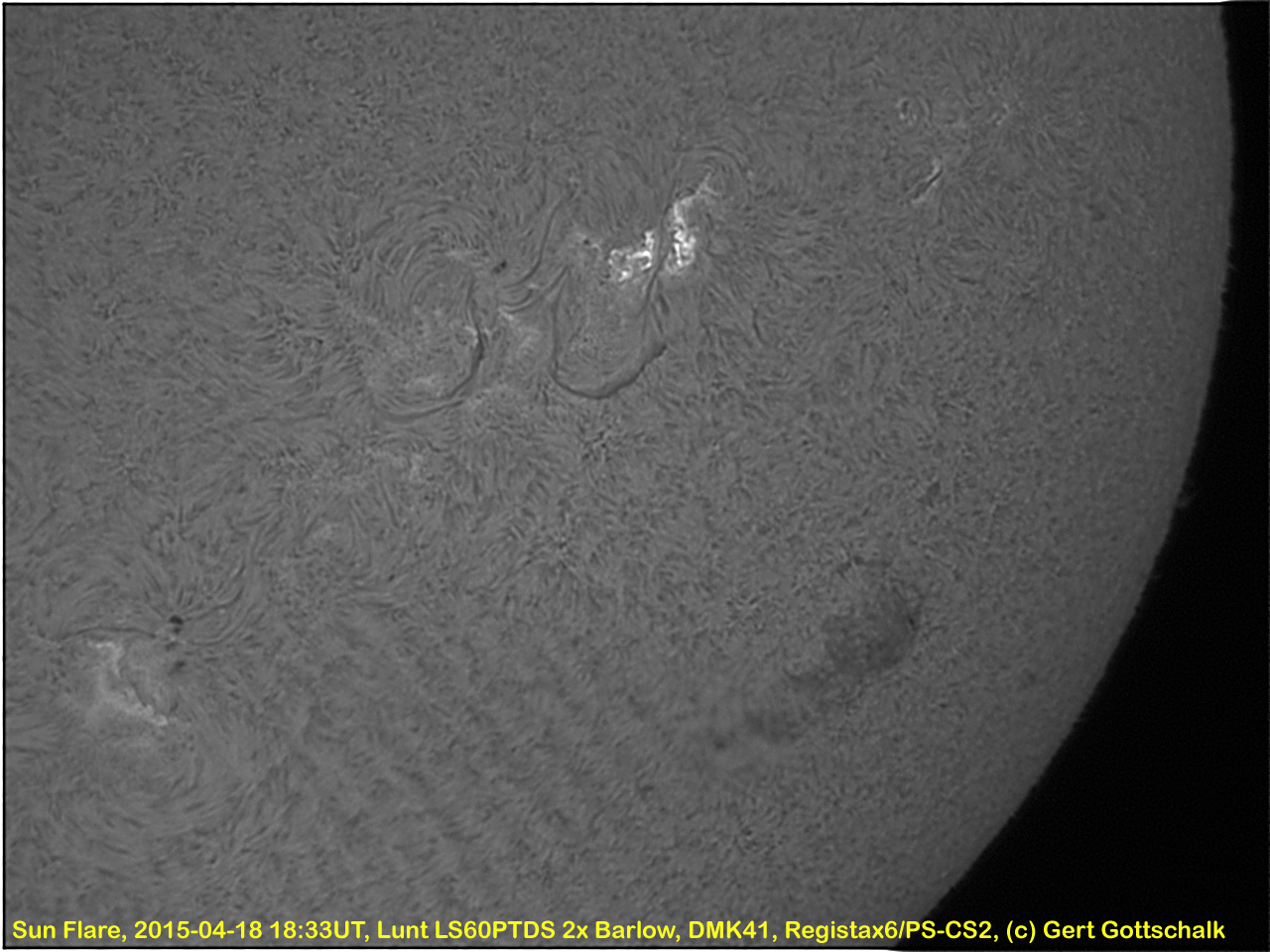
During the full disk recording an airplane crossed the sun's disk.
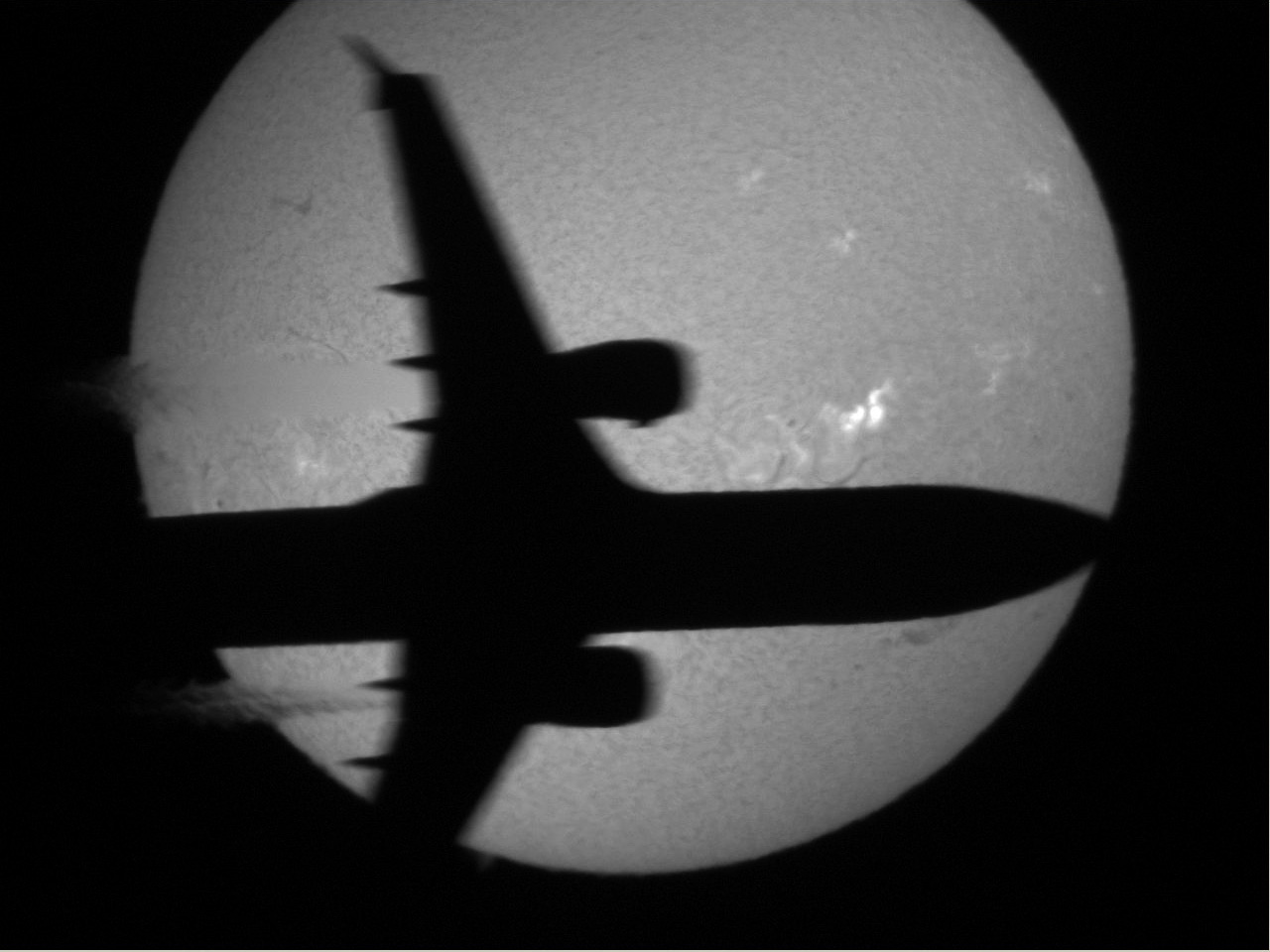
2015-03-07 18:58UT. The daytime seeing was better than usual and allowed using the 100mm double stack Lunt telescope with the 2x barlow giving 1600mm focal length, At that image scape only a few selected areas were imaged. Selected exposure parameters for the transition from surface to prominences. ( Shutter=8.000ms Gain=750 Brightness=0 FPS=15 Gamma=150 )
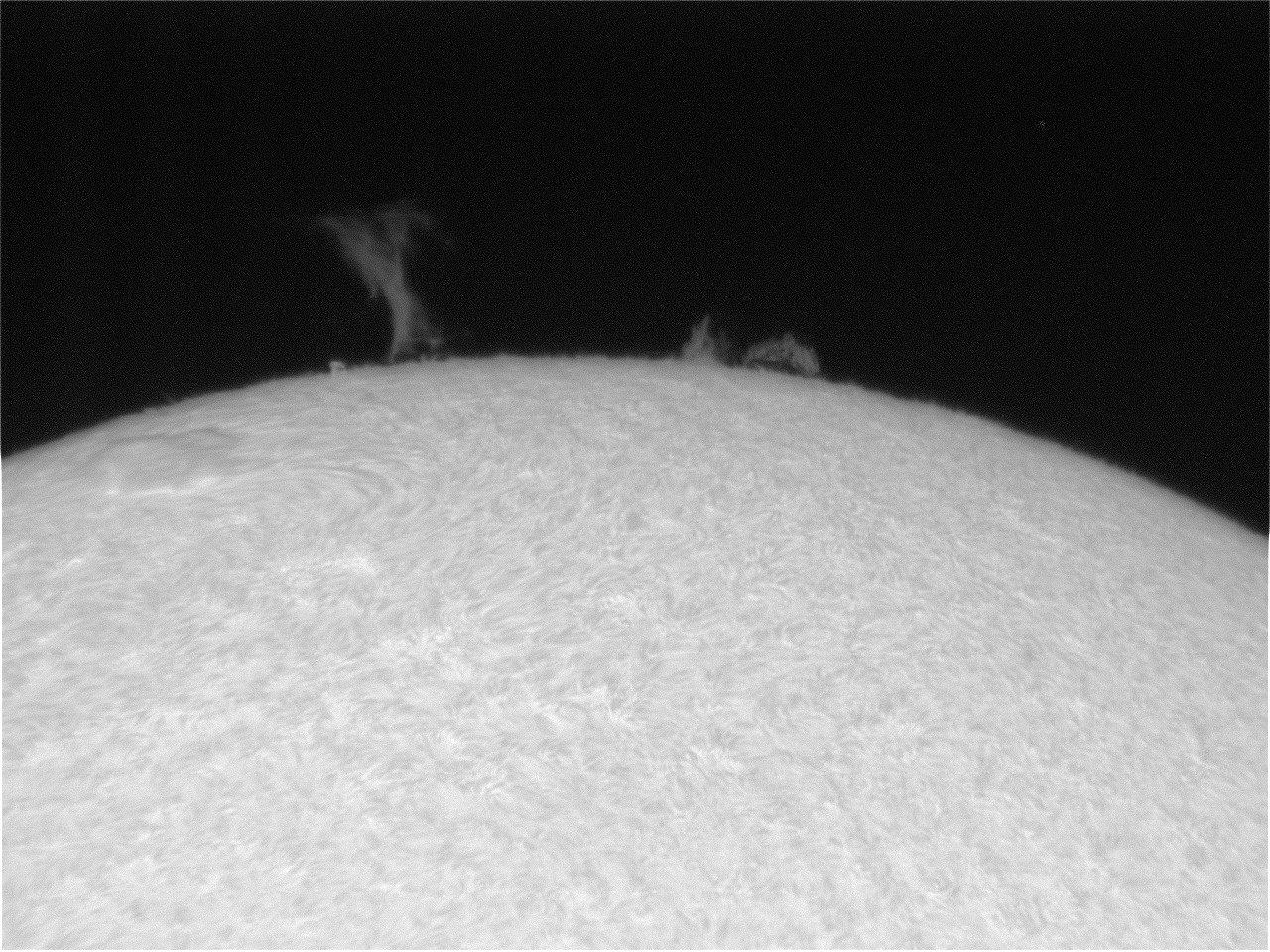
2015-03-07 20:08UT. More images a little later of surface filaments. Exposure parameters ( Shutter=6.000ms Gain=700 FPS=15 Gamma=100)
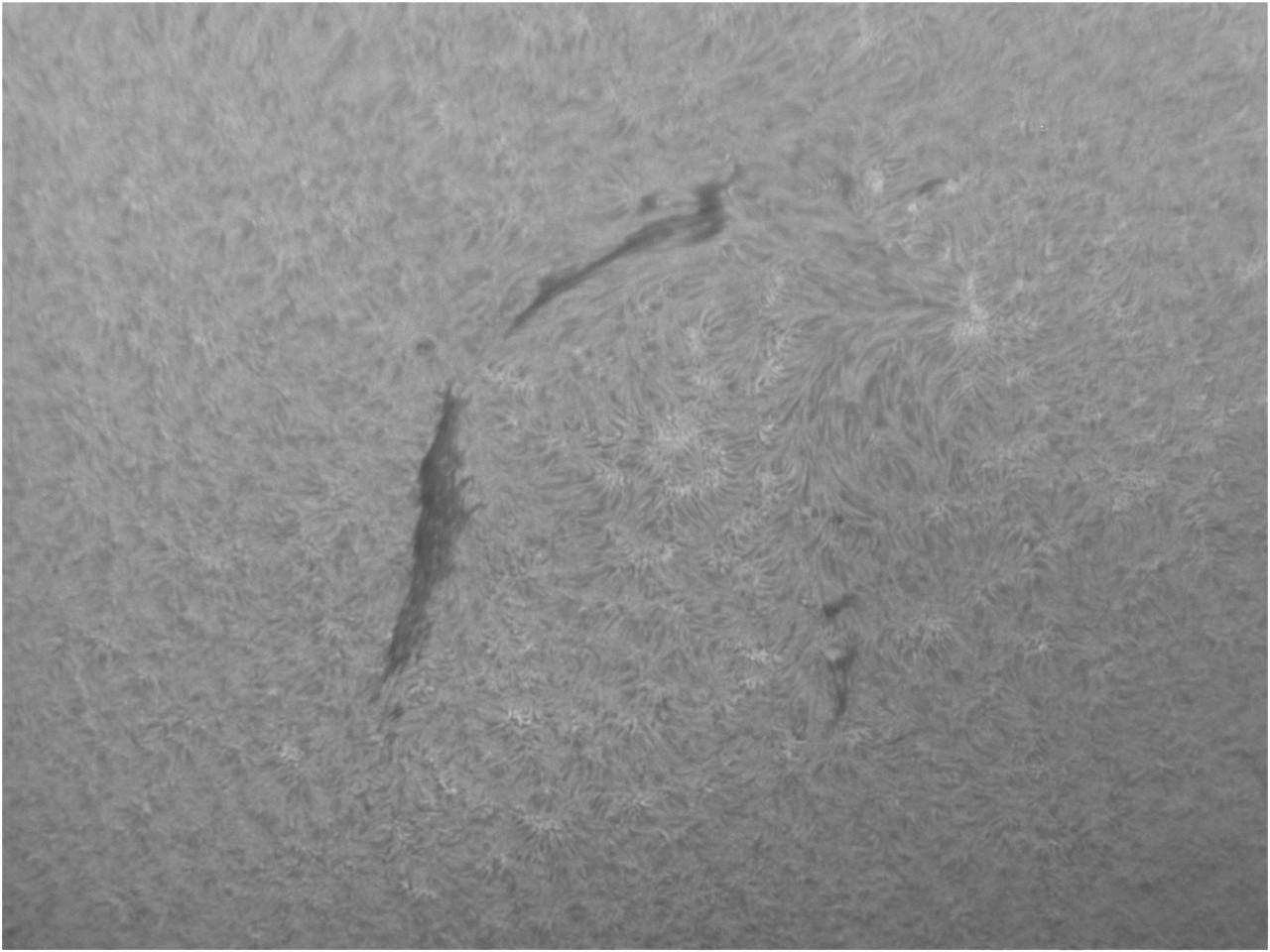
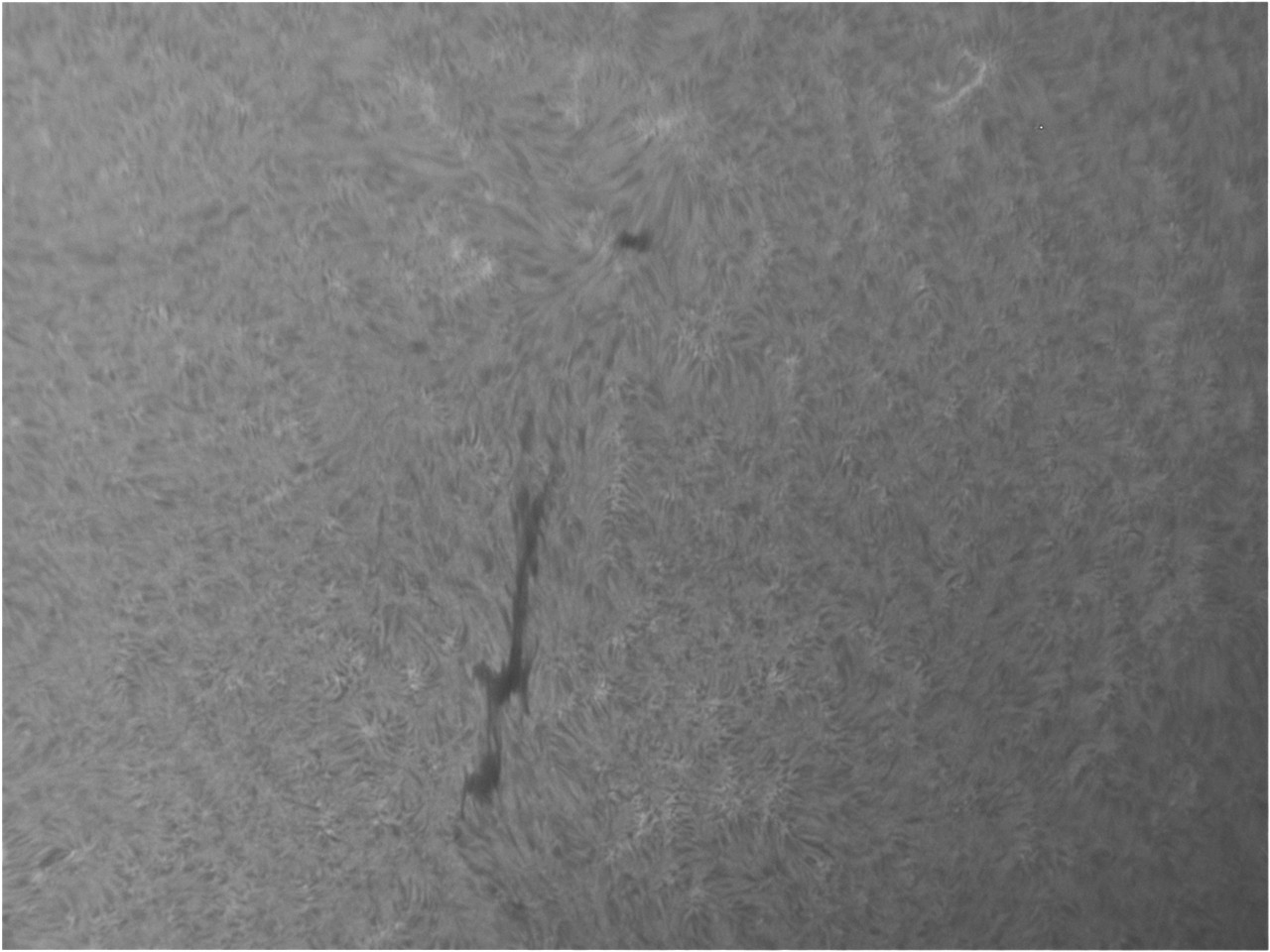
From 19:08 to 20:01UT a series of images was used to create a timelapse video.
2015-03-01 19:44UT. The first solar observation in March was offering a clear day. (The evening before it had rained) The seeing was reasonably good for a weather pattern like that. The image is a composit of surface and prominence detail at different exposure settings. (Surface : Shutter=2.000ms, Gain=350, Gamma=90. Prominences : Shutter=6.000ms, Gain=500, Gamma=180)
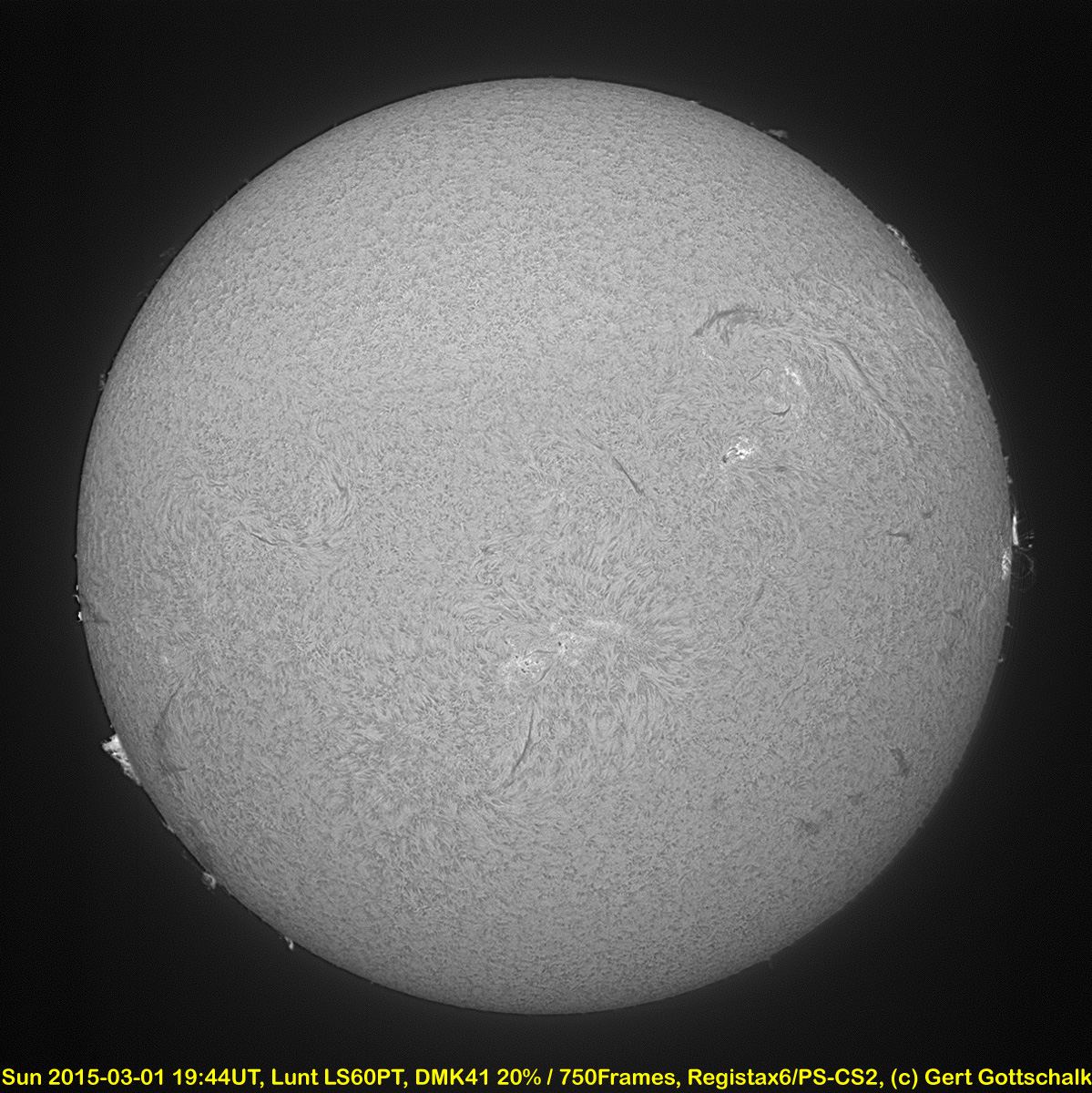
2015-03-01 19:49UT. The double stacked filter showed nice contrast with surface detail and prominences at the same time. The brightness curves were a bit post processed in Photoshop to enhance the prominences and the contrast of the disk.
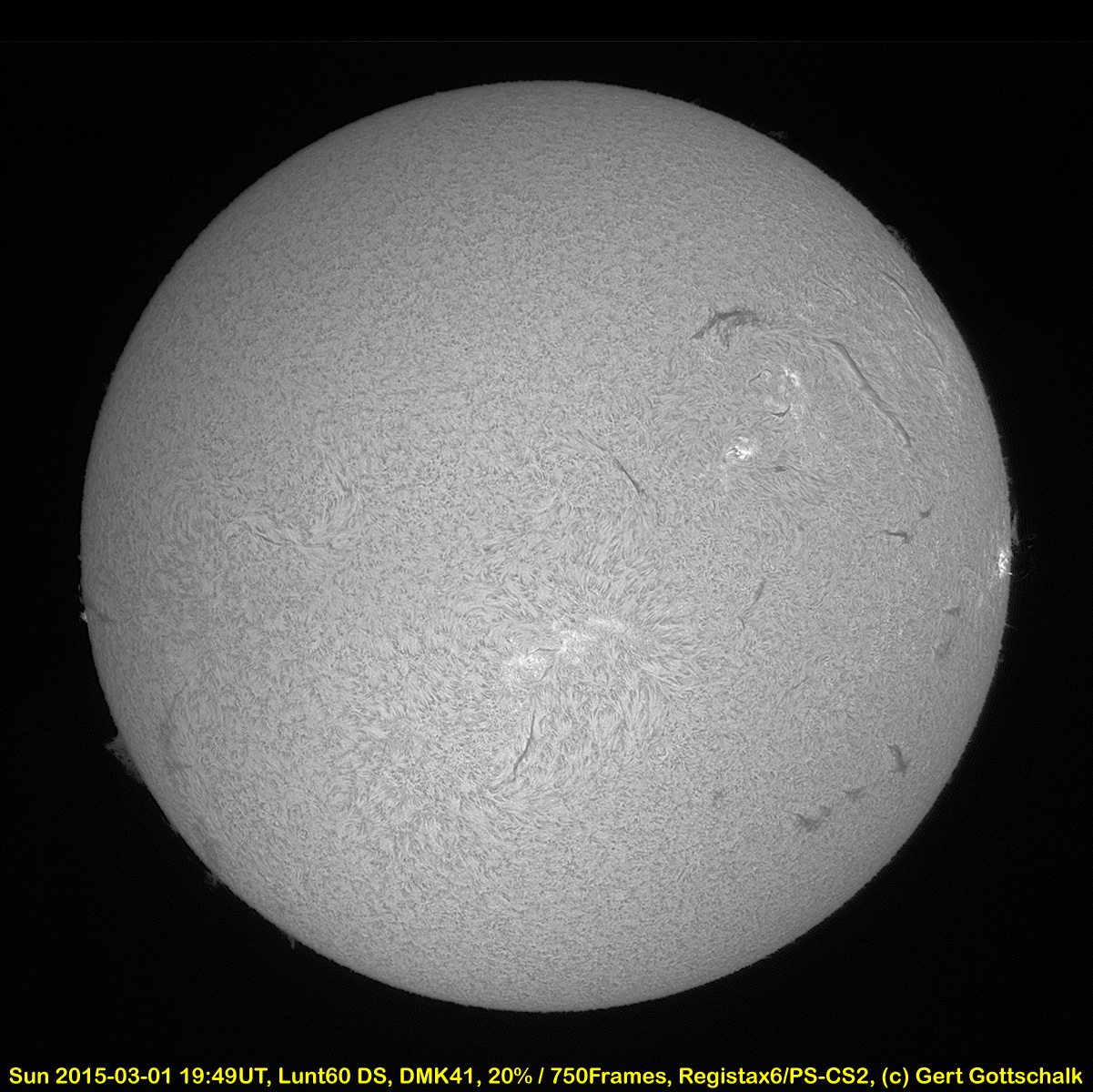
2015-02-21 19:00UT to 19:20UT. The sky waqs quite clear that day and again there was very good contrast with the single stack filter configuration. n that configuration the Chromosphere ist still transparent to light from the photosphere below and we can see this very thin layer of the solar athmosphere.
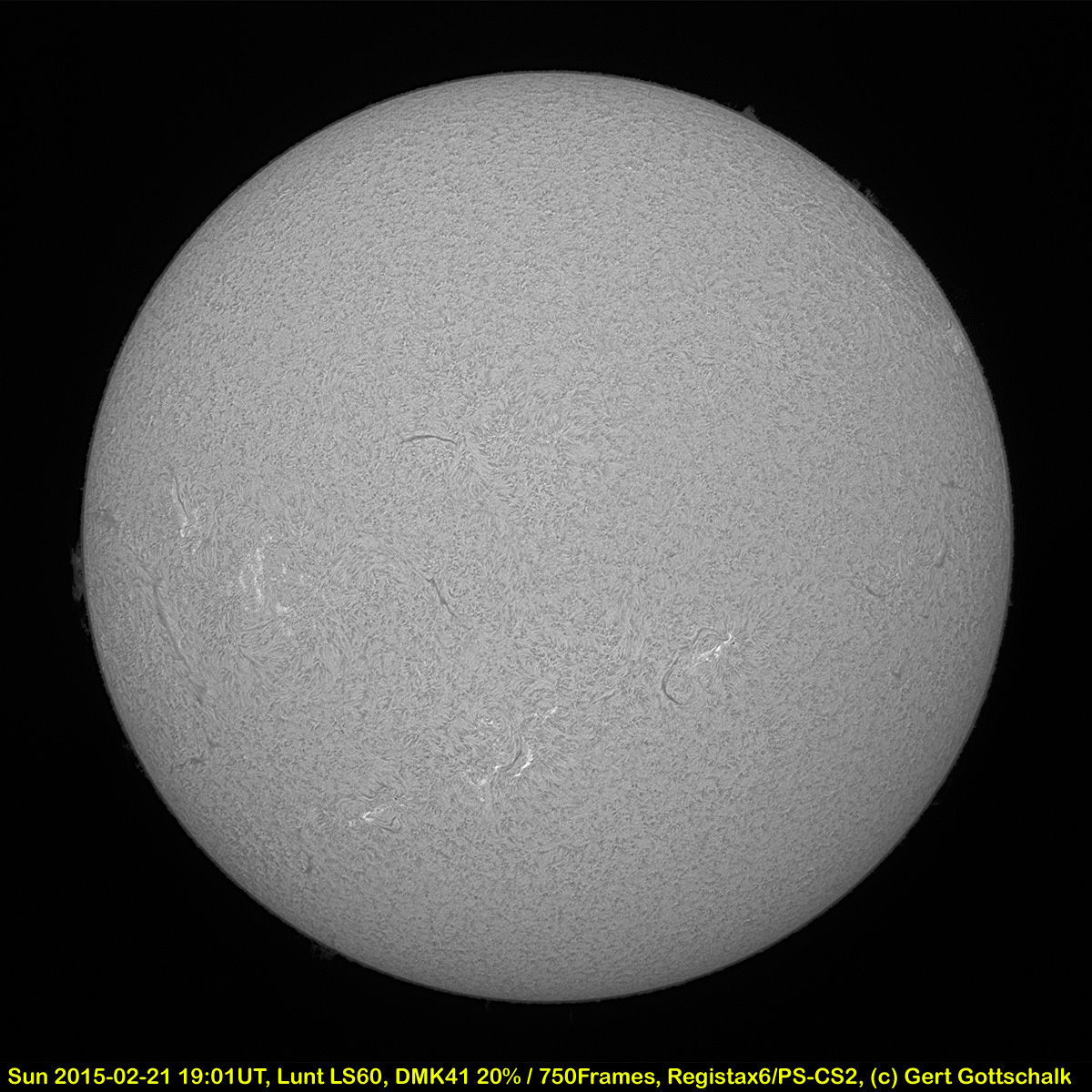
Now we add the double stack filter unit. In the narrow band configuration almost all light from the photoshere is suppressed. We no longer see the photosphere shining through. We also see somewhat stronger contrast on the disk from the double stack filtering.
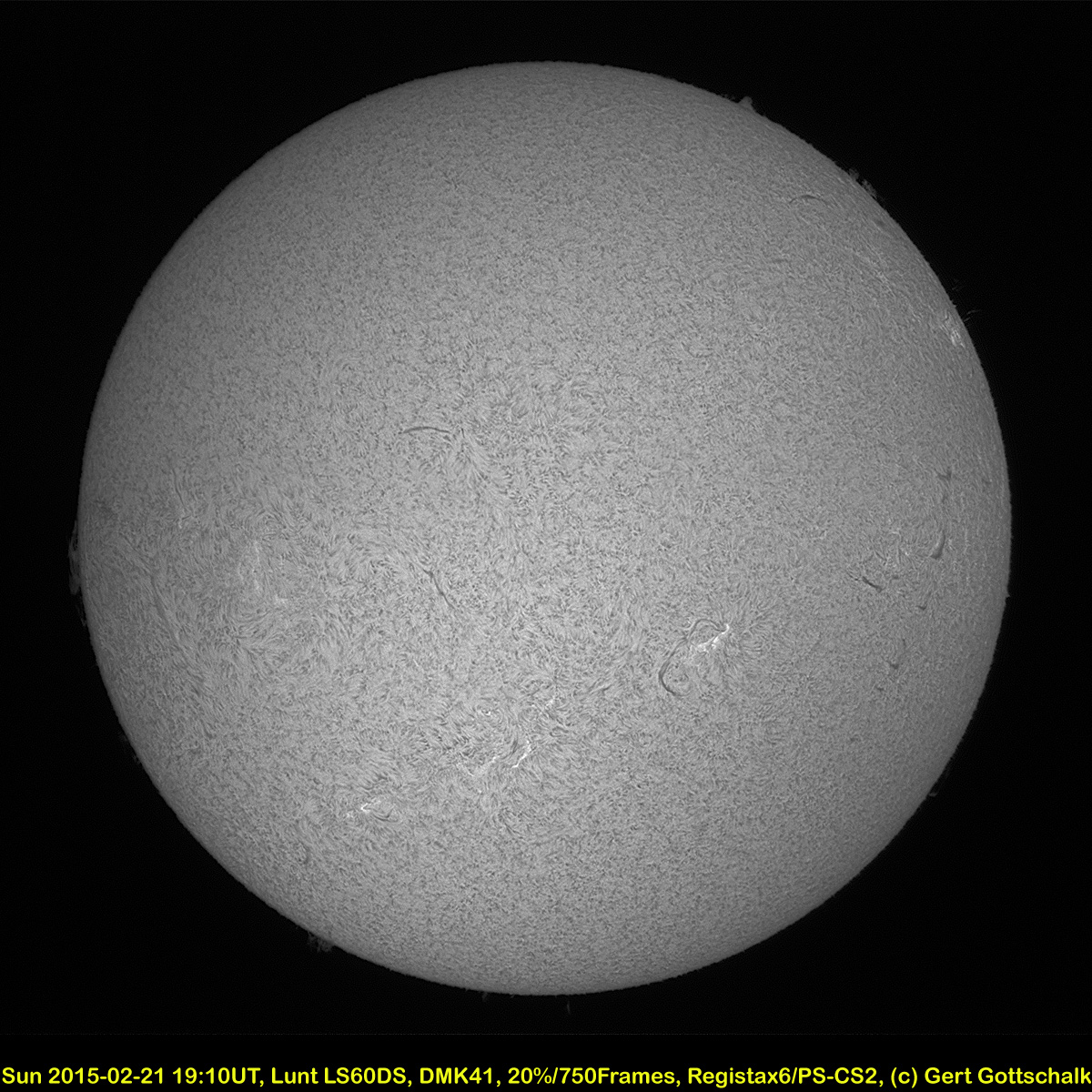
We combine longer exposures for the prominences with the single stack filtered disk image for a composite.
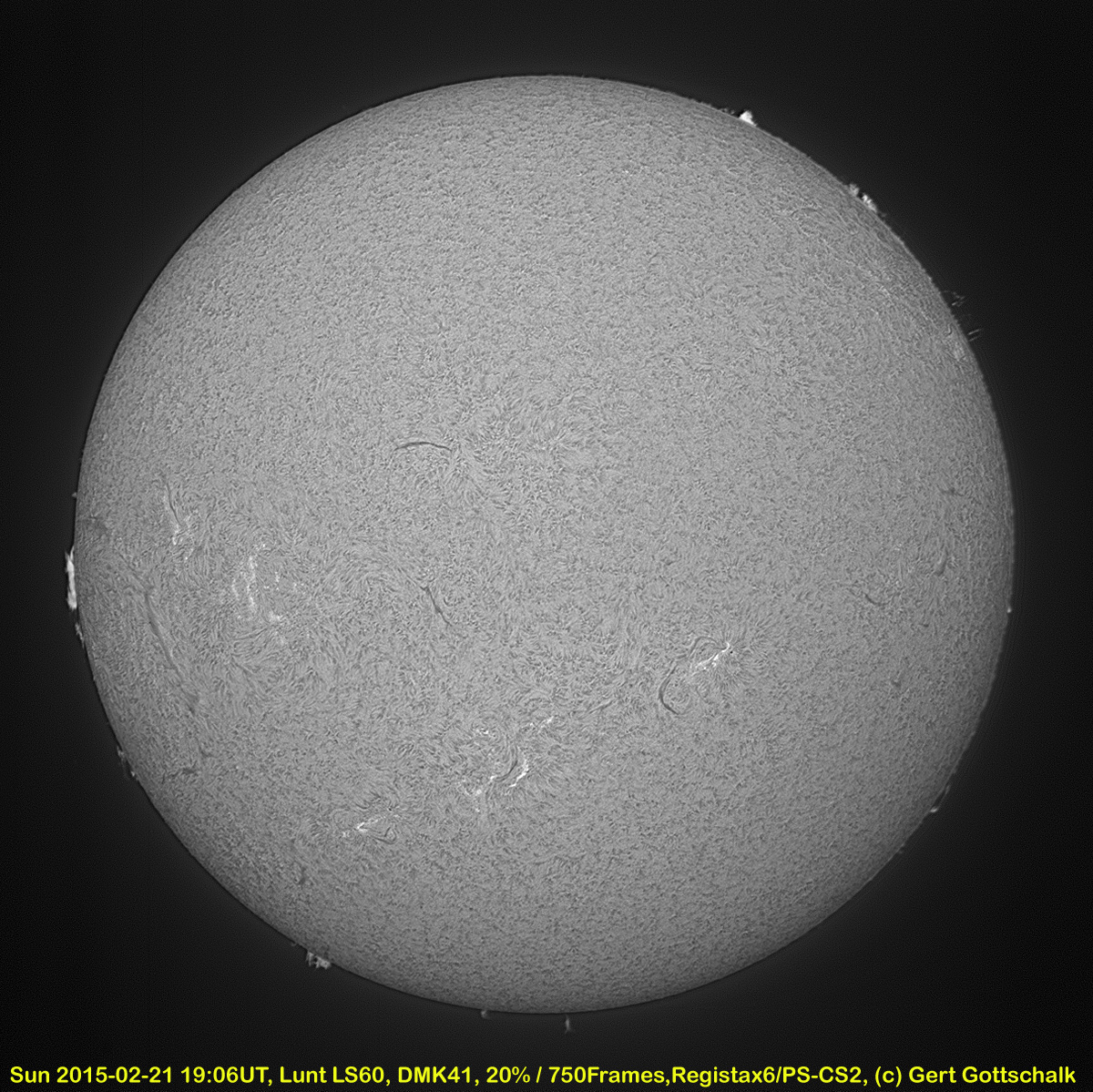
2015-02-14 19:30UT. (A Valentine's Day Sun) Observers noted a long filament stretching across the Sun for the last few days to a week. Saturday the rotation of the Sun led to a nice view where part of the filament was still projected onto the solar surface and another part reached out over the limb an was thus a prominence. The size of the filament needed two exposures side-by-side which were later combined in Photoshop. The observation was done with the Lunt LS100PT H-Alpha telescope in double stack operation. The light path was extended with a 2x barlow. The AVI was recorded with DMK41 B/W camera at 15frames per sec. for 750 frames. 20% of the frames were used in Registax 6 for processing and stacking.
(Click on image for full size)
2015-02-14 19:35UT - 20:50UT Animation of the filament / prominence (the hopping white dot in the upper right is a dead pixel)
2015-01-31 19:45UT The day was very transparent with dark blue sky and very little scattered light. Here the single stack setup performed very well as shown in the first image.
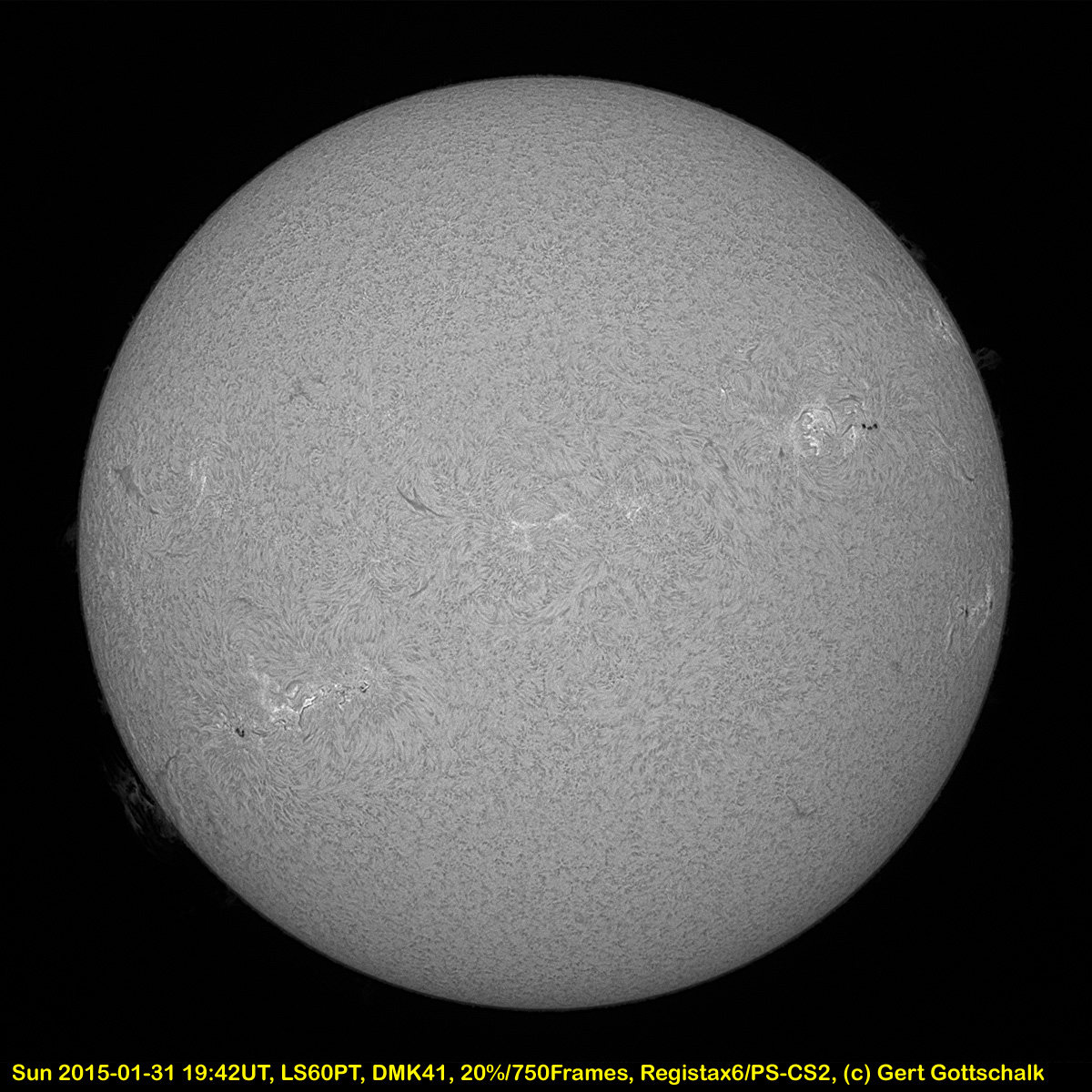
Same contrast as double stack which is shown second. The double stack showed the transition from surface detail to prominences better.
Addes is monior levels adjustment to enhance the prominences.

Last shown is a composit using different single stack exposures for surface and prominences combined together.
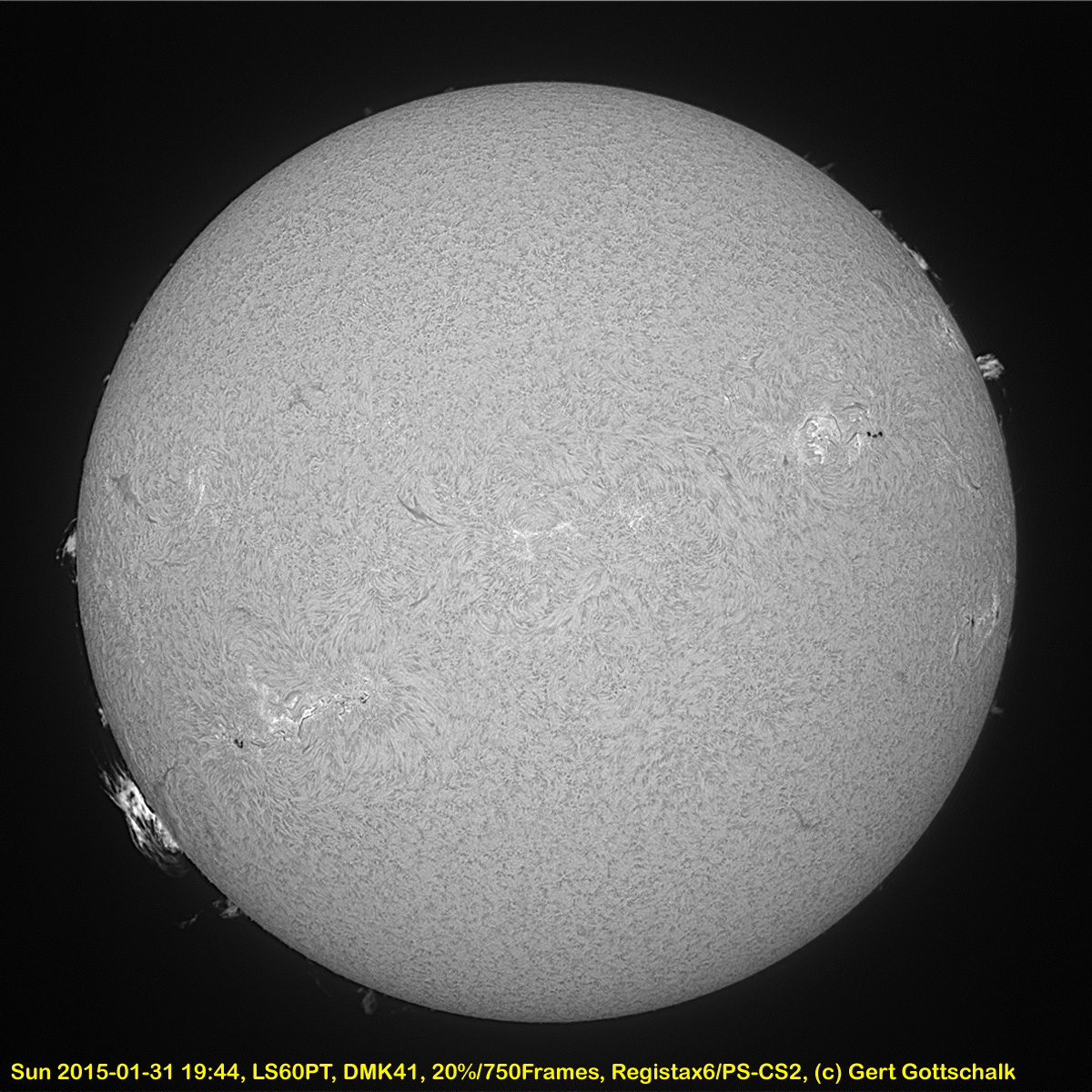
2015-01-24 19:30UT A comparison of single stack and double stack images for the surface part of the solar composite image. Surprising how much contrast the single stack is delivering. It was a day of very clear and dark blue sky, though. maybe that helped.
Single stack
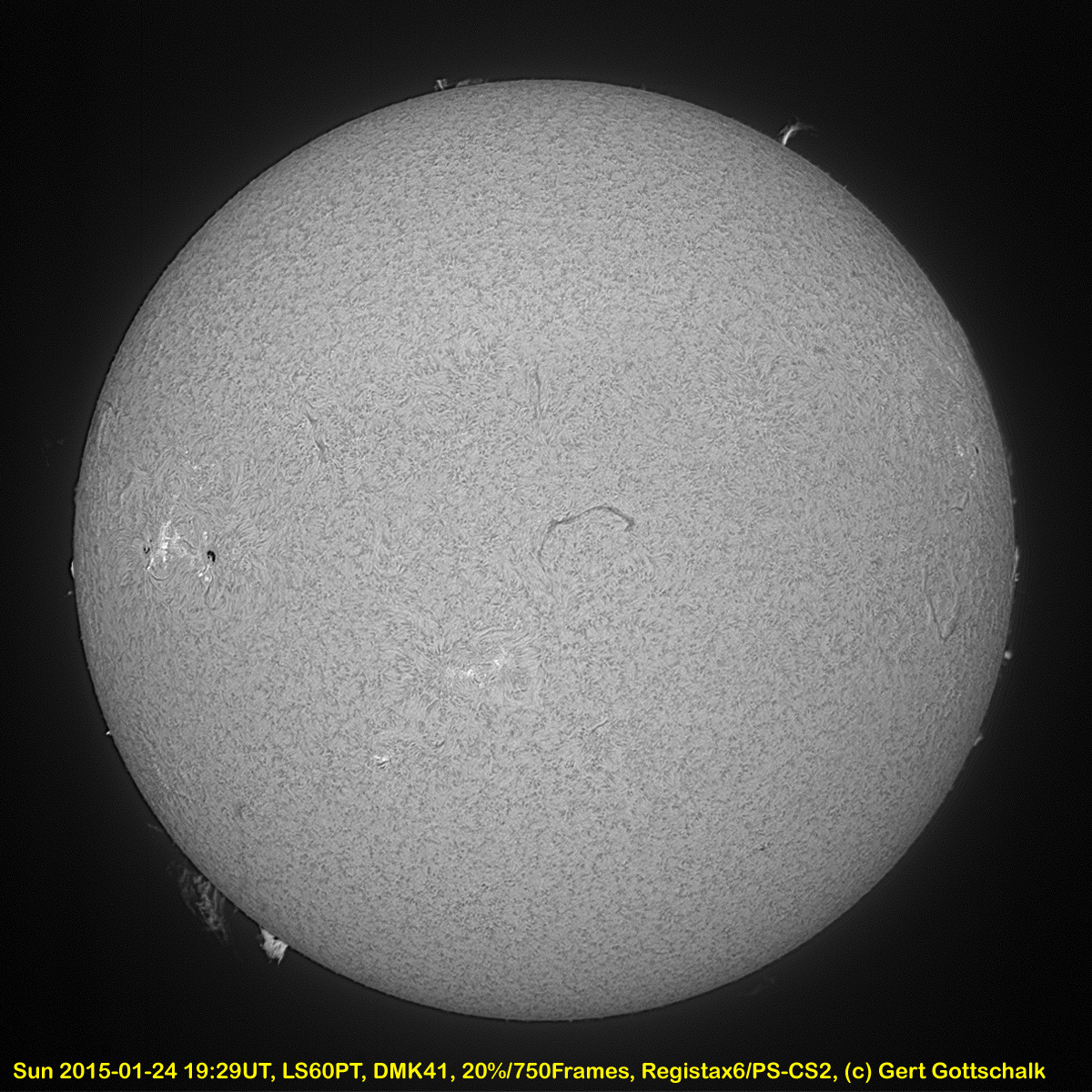
Double stack
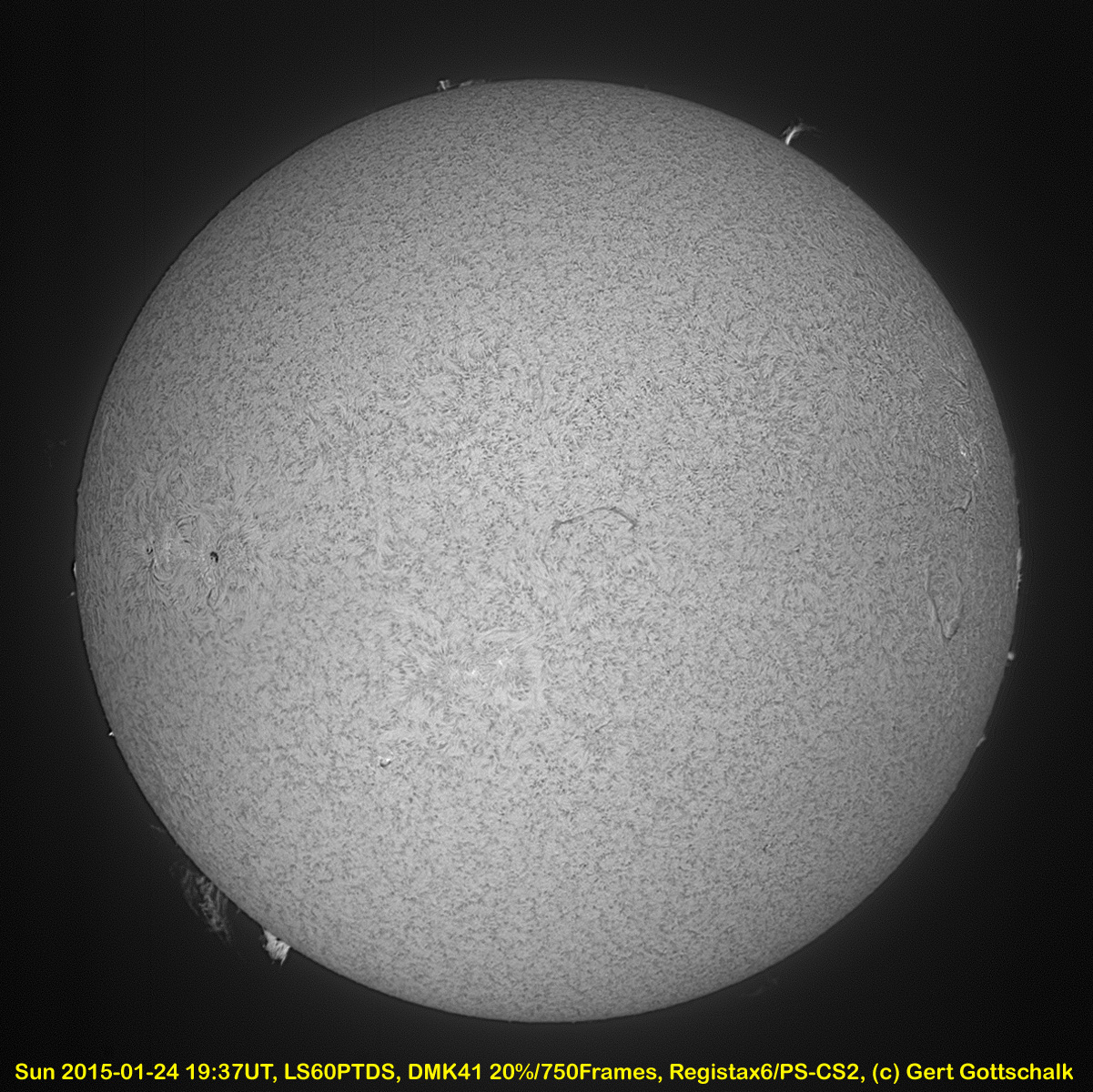
2015-01-14 18:11UT A day of pretty good daytime seeing condition and some nice solar activity. Imaged with the Lunt LS60PT in double stack configuration.
